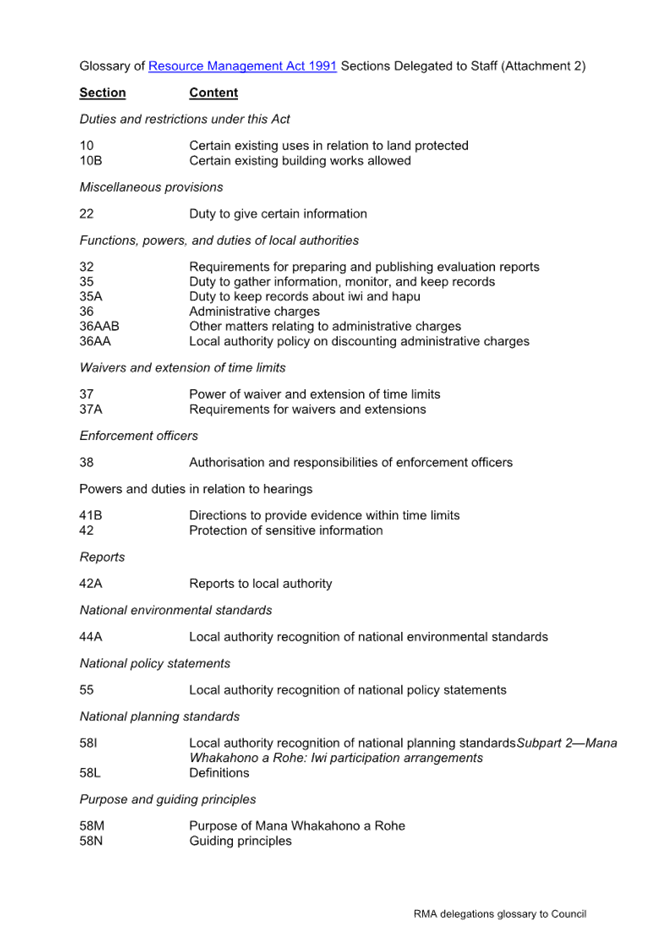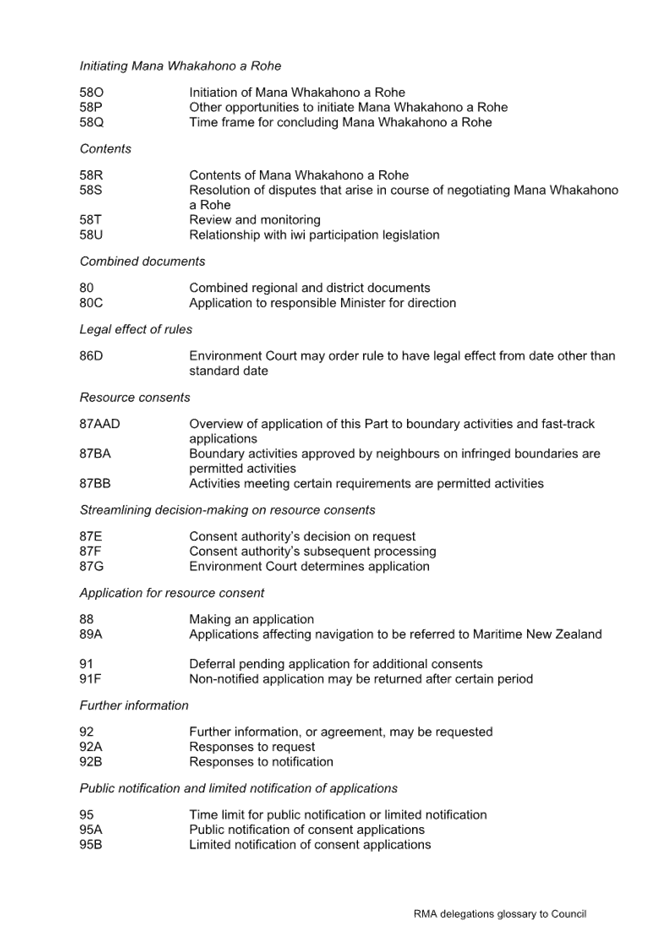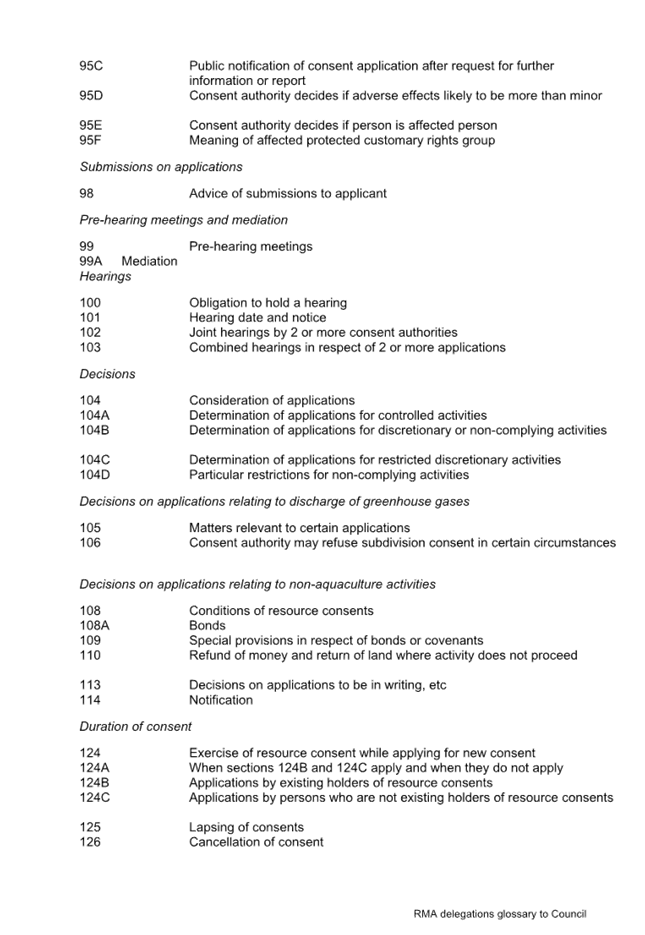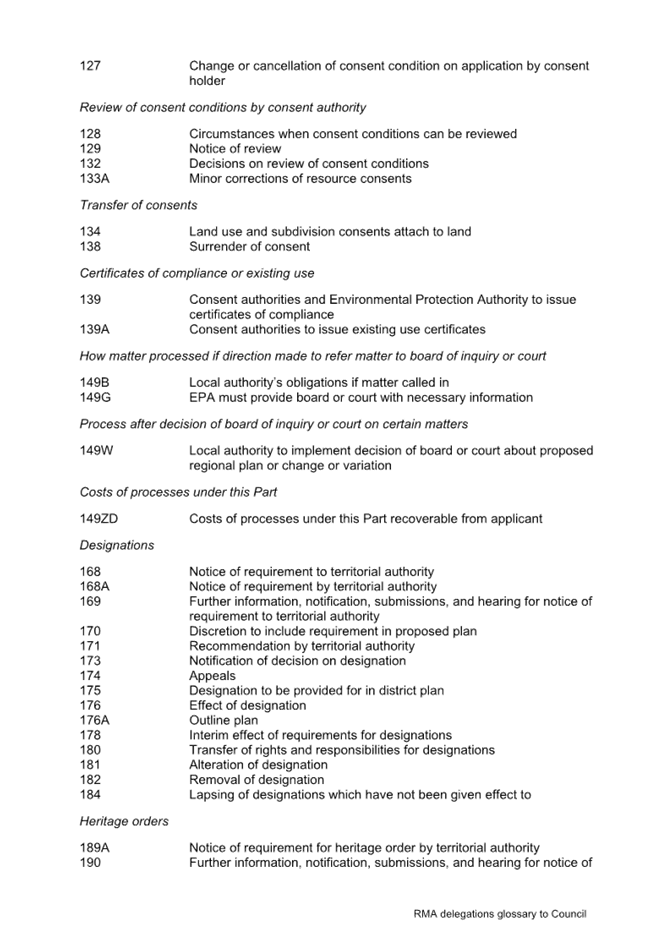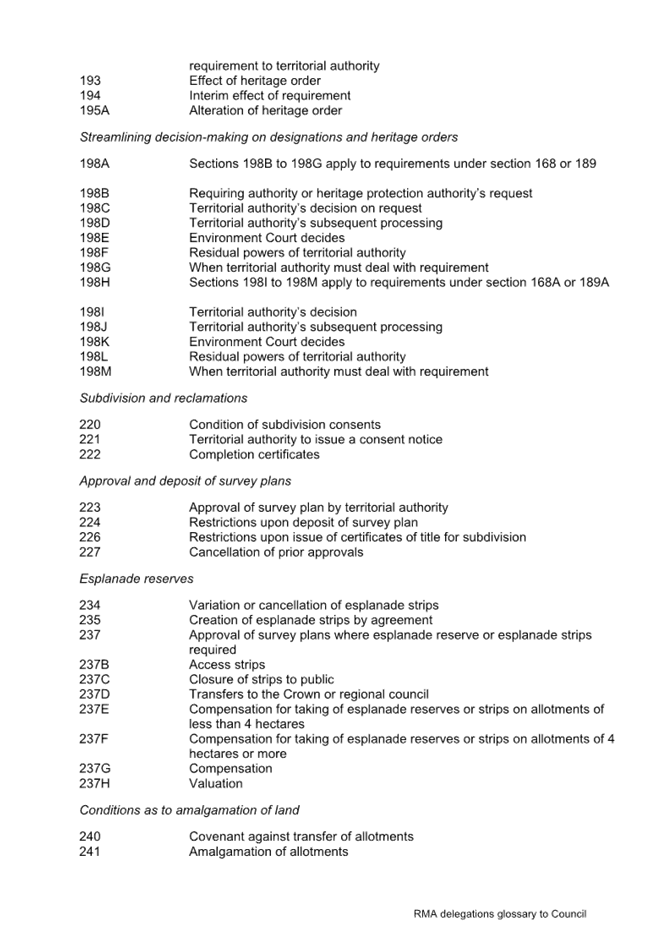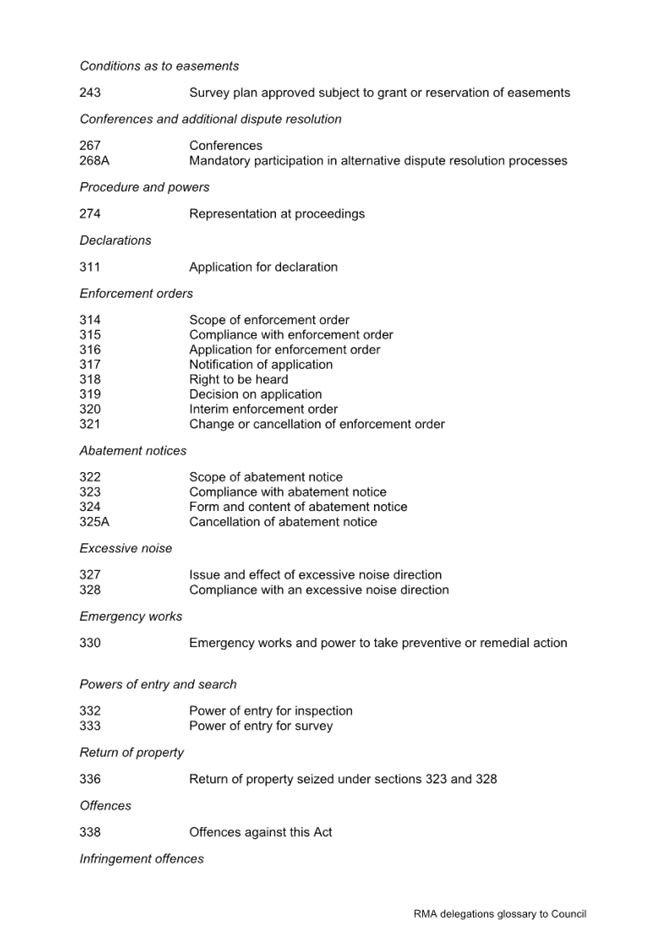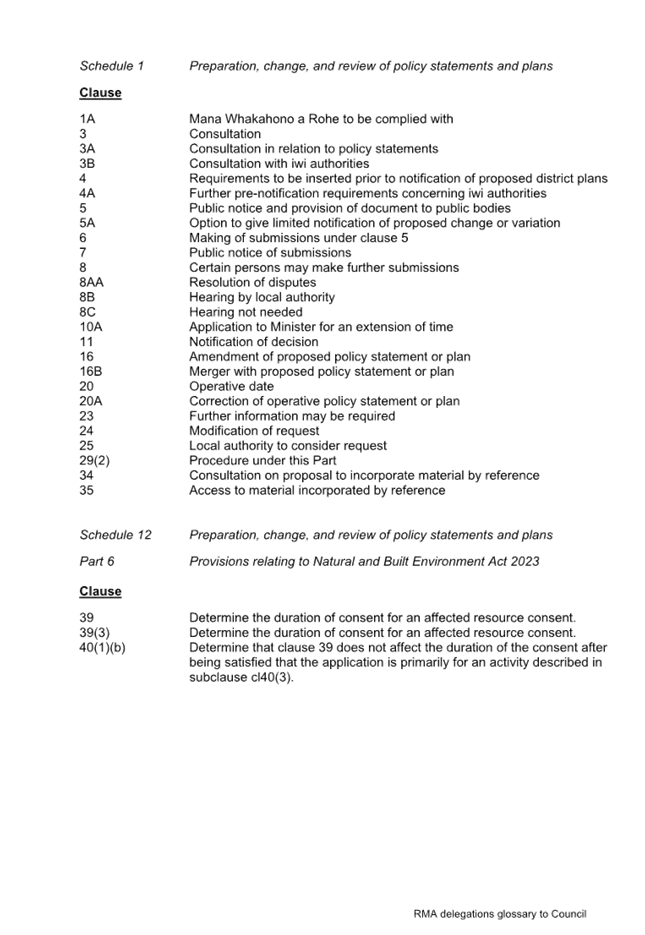|

|
|
RĀRANGI TAKE
AGENDA
Kaunihera | Council Meeting
|
|
I hereby give notice that a Meeting of the Kāpiti
Coast District Council will be held on:
|
|
Te Rā | Date:
|
Thursday, 27 March 2025
|
|
Te Wā | Time:
|
9.30am
|
|
Te Wāhi | Location:
|
Council
Chamber
Ground
Floor, 175 Rimu Road
Paraparaumu
|
|
Kris Pervan
Acting Chief Executive
|
|
Council Meeting Agenda
|
27 March 2025
|
Kāpiti Coast District Council
Notice is hereby given
that a meeting of the Kāpiti Coast District Council will be held in the Council Chamber, Ground Floor, 175 Rimu Road,
Paraparaumu, on Thursday 27 March 2025, 9.30am.
Kaunihera | Council
Members
|
Mayor
Janet Holborow
|
Chair
|
|
Deputy
Mayor Lawrence Kirby
|
Deputy
|
|
Cr
Glen Cooper
|
Member
|
|
Cr
Martin Halliday
|
Member
|
|
Cr
Sophie Handford
|
Member
|
|
Cr
Rob Kofoed
|
Member
|
|
Cr
Liz Koh
|
Member
|
|
Cr
Jocelyn Prvanov
|
Member
|
|
Cr
Kathy Spiers
|
Member
|
|
Cr
Shelly Warwick
|
Member
|
|
Cr
Nigel Wilson
|
Member
|
|
Council Meeting Agenda
|
27 March 2025
|
8 Ngā
Teputeihana | Deputations
8.1 Older
Person's Council
Author: Maria
Cameron, Advisor Governance
Authoriser: Steffi
Haefeli, Acting Group Manager Corporate Services
TE PŪTAKE | PURPOSE
Kevin Burrows, Older Person’s
Council, will speak to the Annual Plan.
Ngā āpitihanga | Attachments
Nil
|
Council Meeting Agenda
|
27 March 2025
|
8.2 Waikanae
Boating Club
Author: Maria
Cameron, Advisor Governance
Authoriser: Steffi
Haefeli, Acting Group Manager Corporate Services
TE PŪTAKE | PURPOSE
1 Graham
Oliver, Commodore of the Waikanae Boating Club, and Toby Bach, the Waikanae
Boating Club’s Finance Committee Chair, will provide an update on the
Waikanae Boating Club Rebuild Project, and present a submission to Council
seeking financial support for a potential shortfall in funding for the
Rebuild Project.
Ngā āpitihanga | Attachments
1. Waikanae
Boating Club Background ⇩ 
2. Waikanae
Boating Club Submission for Funding ⇩ 
3. Waikanae
Boating Club Rebuild Project Architectural Renderings ⇩ 
|
Council Meeting Agenda
|
27 March 2025
|


|
Council Meeting Agenda
|
27 March 2025
|


|
Council Meeting Agenda
|
27 March 2025
|















|
Council Meeting Agenda
|
27 March 2025
|
11 Pūrongo
| Reports
11.1 Reviewing
the Kāpiti Coast Youth Council, Older Person’s Council and the
Kāpiti Disability Advisory Group
Kaituhi |
Author: Emma
Haxton, Team Leader Connected Communities
Kaiwhakamana
| Authoriser: Brendan Owens, Group Manager Customer and
Community
Te pūtake |
Purpose
1 This
report provides the new Terms of Reference for the Kāpiti Coast Youth
Council, Older Person’s Council and the Kāpiti Disability
Advisory Group.
He
whakarāpopoto | EXecutive summary
2 An
executive summary is not required for this report.
Te tuku haepapa
| Delegation
3 As
advisory groups set by the Mayor or Council, the approval of the terms of
reference are required to be approved by Council (Governance Structure and
Delegations, 2022-2025 Triennium - Section A.2 (2)).
Taunakitanga | RECOMMENDATIONS
A. That
the Council notes the key changes made to the Older Person’s
Advisory Group (formally Older Persons Council), Kāpiti Coast Youth
Council and Kāpiti Disability Advisory Group.
B. That the Council approves the new Terms of Reference
for the Older Person’s Advisory Group (formally Older Persons Council),
Kāpiti Coast Youth Council and Kāpiti Disability Advisory
Group.
Tūāpapa | Background
4 The Council has three community advisory groups: the Older
Person’s Council, the Kāpiti Coast Youth Council and the Kāpiti
Disability Advisory Group (Community Advisory Groups). All three groups
have a long-standing role in supporting a diversity of community voice
to Council and were all established in the early 2000’s.
5 Effective
community voice and participation is about creating opportunities for people to
be involved in influencing, shaping, designing and contributing to policy and
the development of services and programmes. The Community
Advisory Groups provide a structured mechanism for this to occur.
6 The purpose of the Community Advisory Groups is to advise
Council on the needs, thoughts and ideas of people in the communities they
represent in Kāpiti.
7 The Kāpiti Coast Youth Council (Youth Council) acts as
a voice for the young people of the Kāpiti district to Council,
with current members aged 14 – 20 years. The Youth Council
does not have a current Terms of Reference.
8 The Older Persons' Council was established as a voice for
older people in our community. It has operated as an open forum for any member
of our older community to participate. The Older Persons Council does not
have a current Terms of Reference. The last terms of Reference for this group
was created in 2012.
8 The Kāpiti Disability Advisory Group (Disability
Advisory Group) provides advice to Council with a particular focus on issues of
access, equity and inclusion for people with disabilities. It has members who
have a wide range of disabilities. The Disability Advisory Group does not
have a current Terms of Reference. The group has
an inactive Memorandum of Understanding which operated as a Terms of Reference
from 2016.
HE KŌRERORERO | DISCUSSION
10 Each Community Advisory Group has its
own unique process, and the work undertaken to review the groups has sought to
ensure best practice engagement is tailored to their different needs and
strengths.
11 Council staff worked with the Chair of
the Older Person’s Council and the Chair of the Disability Advisory
Group to develop their respective groups' new Terms of Reference. A core group
of Youth Council members was involved with scoping their changes and ensuring
it was in line with best practice youth engagement.
12 We have undertaken a range of
consultation and engagement to develop the new Terms of Reference for each
group. A key component of this was working alongside the Community Advisory
Groups to capture their thoughts and ideas on the strengths of their current
structure, process, and factors they felt required improvement. As we built
each Terms of Reference, we checked back in with the Community Advisory Groups
to ensure changes being made met their needs. Rather than have one
Terms of Reference covering all three groups, the groups were clear that it was
important to them to have their own Terms of Reference. There is consistency
between each of the documents.
13 Key
aspects of our consultation and engagement included:
· opportunities for
individual members from each Community Advisory Group to meet with Council
staff to share their thoughts and ideas
· a workshop with
each of the Community Advisory Groups to ensure feedback opportunities for
members as recommended changes were drafted
· an ongoing
co-design process with the Chairs of the Older Person’s Council and the
Chair of the Disability Advisory Group and a sub-group of the Youth
Council throughout the process
· conversations to
get advice from the elected members appointed to each advisory group
· engagement with
other stakeholders including the Chair of the Kāpiti Health Advisory
Group, the Chair of the Age Friendly Reference Group and the previous Chairs of
Older Person’s Council and the Disability Advisory Group
· discussion with
staff who regularly access the Community Advisory Groups for advice.
14 Key
themes arose from the consultation and engagement from all three Community
Advisory Groups:
· A need for a more
diverse representation in the membership of the Community Advisory Groups,
including ethnic, geographic, age and disability diversity.
· The importance of
supporting Community Advisory Groups to able to link back to their diverse
communities and bring different ideas from their wider communities into their
advice and actions.
· Better induction,
training and support to help Community Advisory Groups understand and activate
their roles.
· The need for
having Community Advisory Groups with members who are selected and focused on a
clear group purpose.
· Support for having
Community Advisory Groups work programmes to increase purpose, direction and
deliverables, including reporting.
· A better
understanding of the role of the Community Advisory Groups amongst Council
staff to strengthen good practice engagement when advice is sought from the
groups.
15 The
new Terms of References reflect these key themes.
He
take | Issues
16 The
Terms of Reference for each of the Community Advisory Groups is provided as
Appendix One, Two and Three.
17 The
scope of the Community Advisory Groups is to:
· provide an
inclusive and diverse representation of their communities
· provide advice,
input and feedback on Council policies, initiatives and projects
· identify any
emerging trends, opportunities and challenges they see in their
communities
· progress actions
in partnership with Council which support the needs of their communities
· advocate and
provide a voice of their respective communities.
18 The Youth Council structure and
process is positioned in a nationally recognised youth participation in
decision making model.
19 The Age Friendly Reference Group will
continue while funded community projects they have helped facilitate are
delivered this year. The Older Person’s Council will hold the overall
role of working alongside Council to support the implementation of
Council’s Age Friendly Approach.
20 All Community Advisory Groups will
receive good training, induction and support so they are well equipped to
fulfil their roles. Each Community Advisory Groups will develop an annual work
programme with Council staff. Activities in this work programme will be aligned
with the Council's strategic directions and the outcomes of the Long-Term
Plan.
21 Appointments are made for a two-year
term. Members can re-apply for an additional two-year term. It is expected that
members of all the Community Advisory Groups come from and remain connected to
their communities. This means Community Advisory Groups will be supported
to engage with the communities they represent and others as part of their
role.
22 All Community Advisory Groups will
have the opportunity to report to a Council committee.
23 The Terms of Reference will be
reviewed every three years. Significant amendments must be approved by the
Council.
Next steps
24 Advisory group meetings will take a
pause for most of April and May 2025 as we undertake recruitment, selection and
induction of new members.
25 New members will be welcomed and
inducted in May with Community Advisory Groups meetings operating under the new
Terms of Reference starting up from June 2025.
Selection
26 The Chair of the Disability Advisory
Group and Older Person’s Council will be part of a selection panel to
decide the membership of their groups. The current Youth Council membership
will nominate two members to participate in the selection panel for the new
Youth Council members.
27 Current members of Youth Council and
the Disability Advisory Group were previously selected and appointed and do not
need to formally re-apply to be on their respective Community Advisory Group.
28 The Older Person’s Council has
operated without membership, as an open forum for any older person reside to
attend. A key theme in the consultation and engagement with people involved in
the Older Person’s Council was that the group should have a selected
membership similar to the Youth Council and Disability Advisory Group. This
recommended change also contributed to a shift from the name Older
Person’s Council to Older Persons Advisory Group to help the community to
understand the role of the group as an advisory group to Council.
29 While the Older Persons Advisory Group
will have a specific membership, the group will have a stronger focus on
engaging with older people’s communities in Kāpiti and can deliver
open forums to contribute to its work programme.
30 Older people who have attended the
open Older Person’s Council meetings will be supported to apply for a
role on the new group.
Ngā
kōwhiringa | Options
31 There
are no options associated with this report.
Mana whenua
32 Council officers will ensure a
communication link between mana whenua partners and the Community Advisory
Groups. Community Advisory Groups support projects that benefit their
communities and mana whenua, and engage with mana whenua on projects, where appropriate.
Panonitanga Āhuarangi me te Taiao | Climate change
and Environment
33 The Community Advisory Groups advise
on a wide range of issues, including advising on climate change challenges,
mitigation and adaptation to the effects of climate change for the communities
they represent.
34 The Kāpiti Coast Youth Council
have identified climate change as a key priority for young people. They
facilitate an annual summit aimed at inspiring young people to take climate
action.
Ahumoni me ngā rawa | Financial
and resourcing
35 The
Community Advisory Groups expenditure is within the allocated budget for each
year as approved in the Long Term Plan.
Tūraru ā-Ture me te Whakahaere
| Legal and Organisational Risk
36 There
are no legal risks associated with this report.
37 This
work is part of a broader Advisory Group Review being undertaken which is
focused on operational aspects to enable consistency and strengthen
accountability across existing advisory groups, including panels,
reference and advisory groups Council may have or wish to establish in the
future.
38 All
Community Advisory Group members must comply with the Code of Conduct for
members of advisory groups panels and boards. This Code of Conduct is
being developed as a part of the broader Advisory Group Review by the legal
team at Council.
Ngā pānga ki ngā kaupapa here | Policy impact
39 There is no policy impact associated with this
report.
TE whakawhiti kōrero me te
tūhono | Communications &
engagement
Te mahere tūhono | Engagement
planning
40 We have undertaken a range of
consultation and engagement to develop the new Terms of Reference for each
group as outlined earlier in this report.
Whakatairanga |
Publicity
41 A
communications plan is being developed to support communications with the
community and key stakeholders with the new look Community Advisory Groups. Our
recruitment promotion will be actively undertaken to reach our diverse
communities. The opportunity to apply for Community Advisory Groups will be
widely promoted and pop in sessions will be held in community spaces to provide
accessible opportunities for those interested in becoming a member of a group.
The recruitment process will ensure it is relevant to the interests of
different communities in the scope of each group.
Ngā āpitihanga | Attachments
1. Kāpiti
Coast Youth Council Terms of Reference ⇩ 
2. Older
Persons Advisory Group Terms of Reference ⇩ 
3. Disability
Advisory Group Terms of Reference ⇩ 
|
Council Meeting Agenda
|
27 March 2025
|
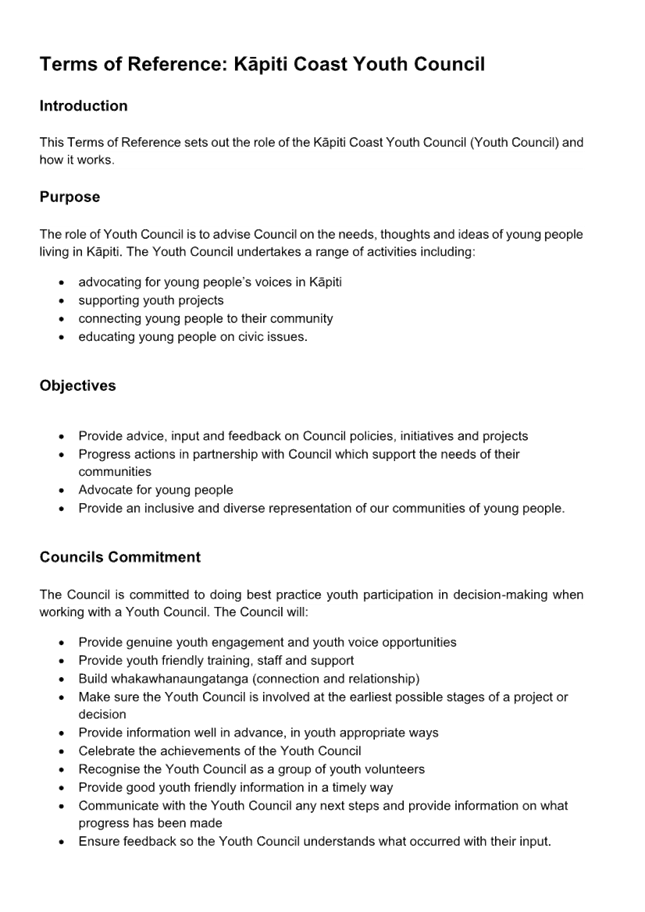

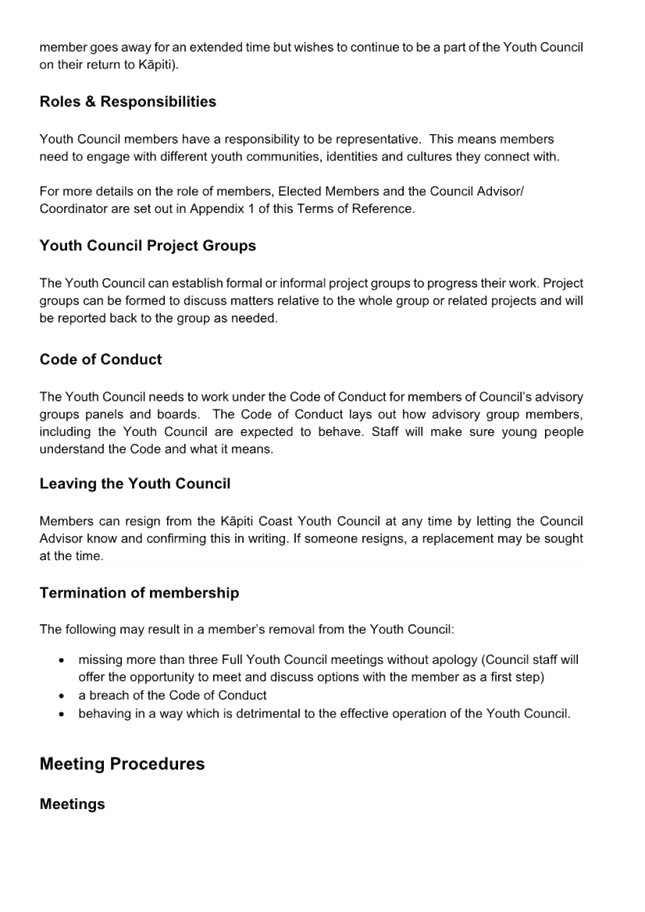

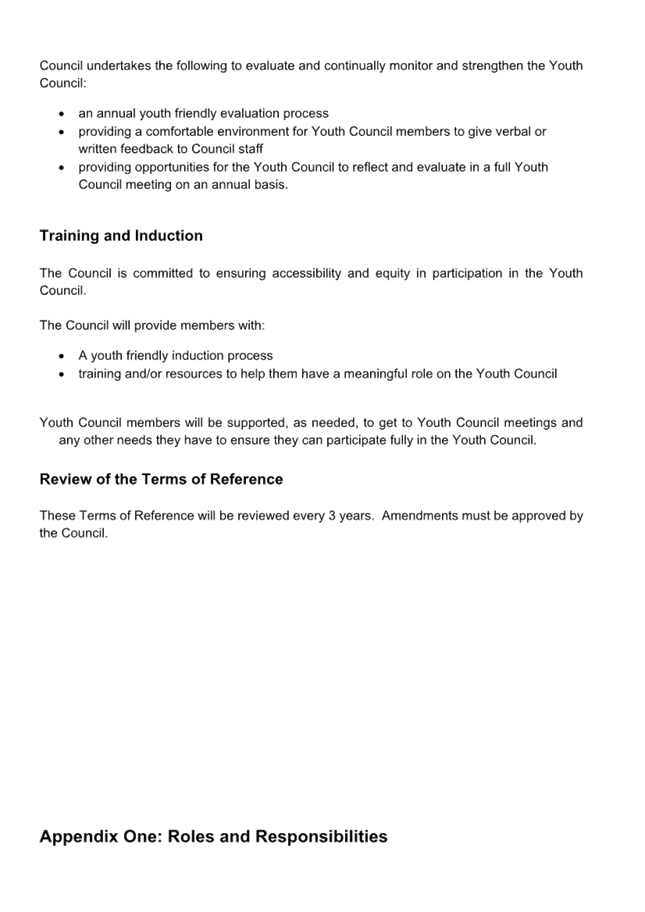
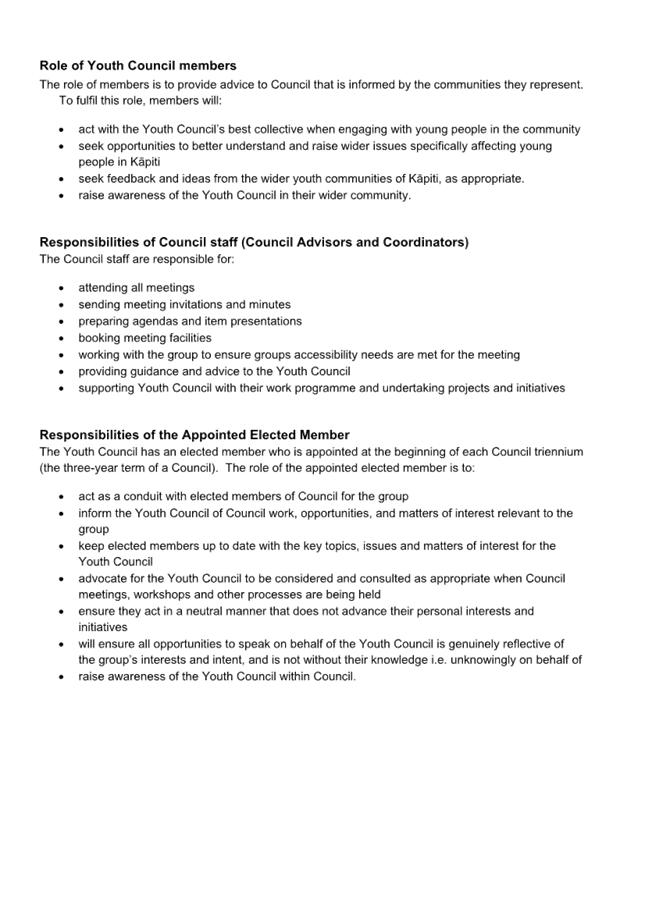
|
Council Meeting Agenda
|
27 March 2025
|
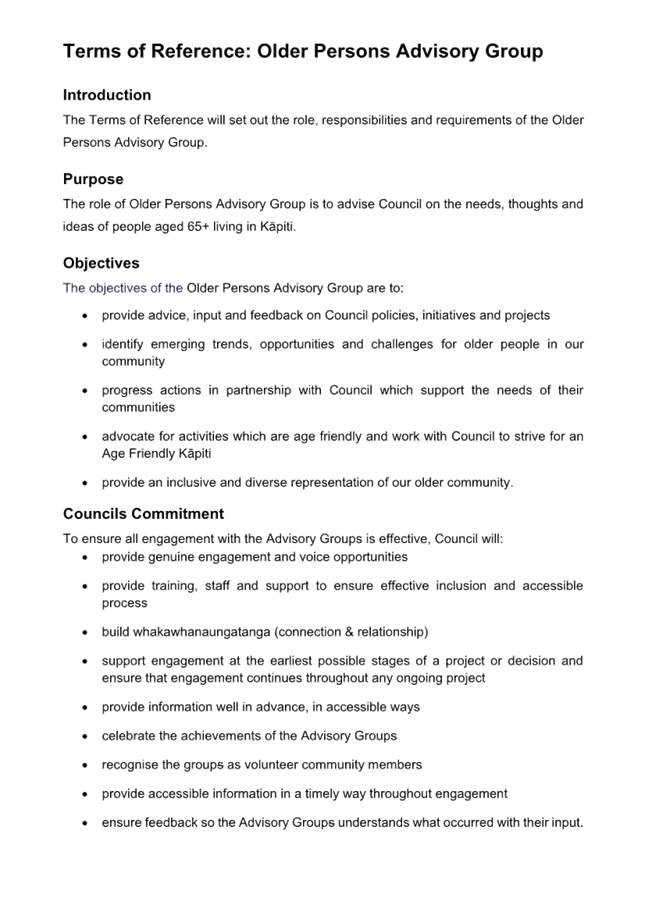
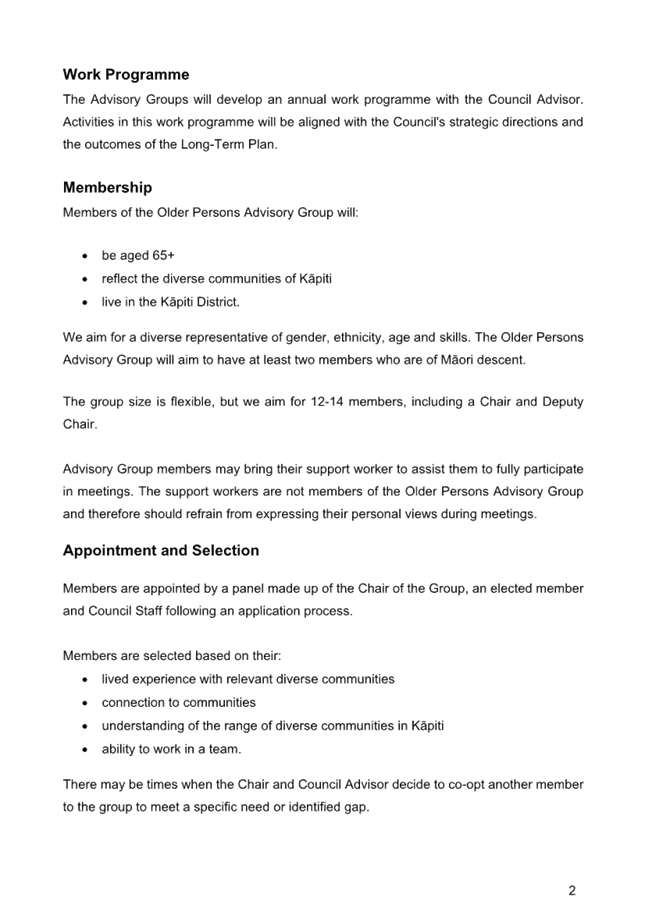
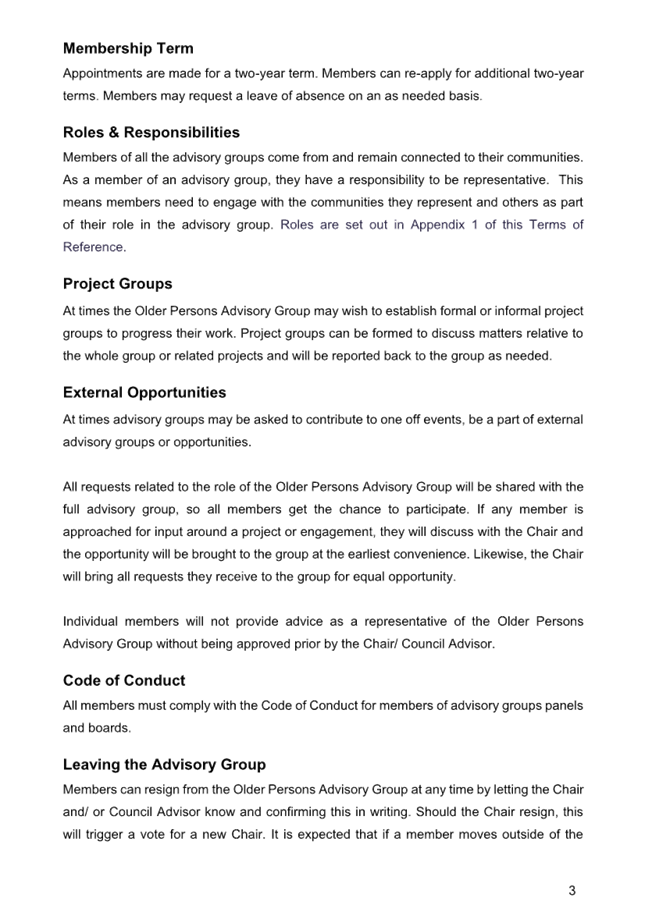
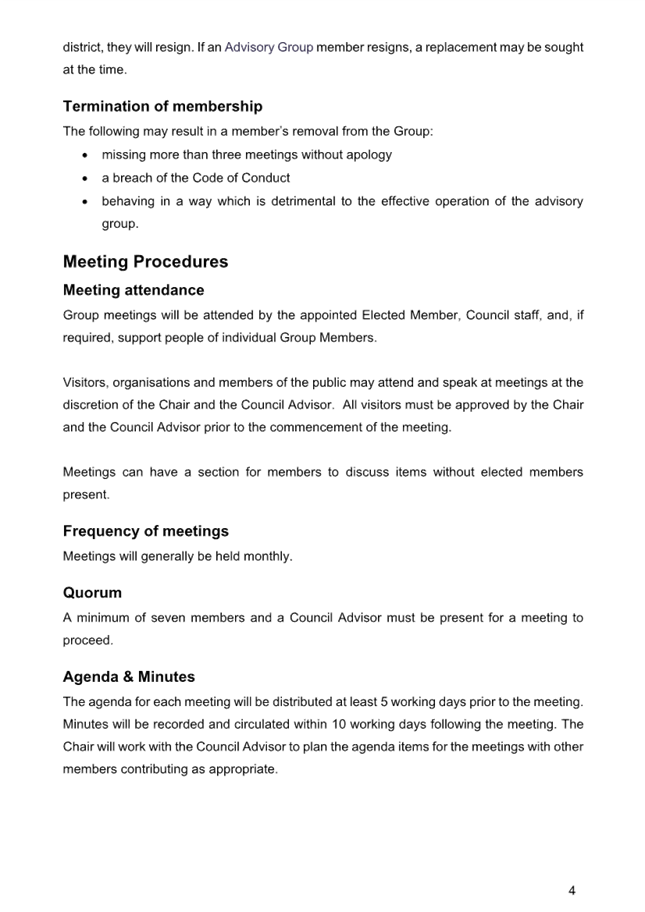
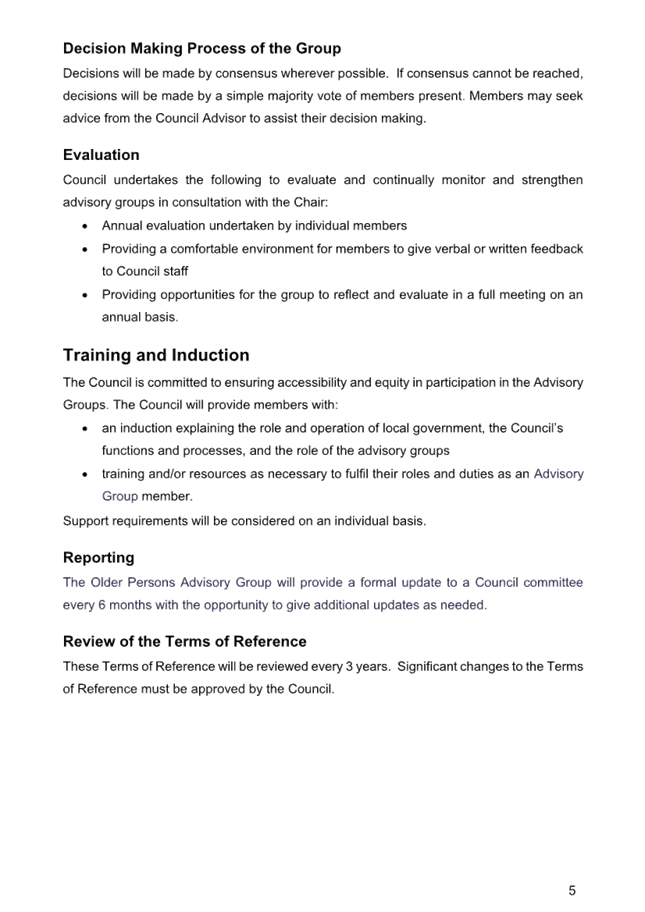
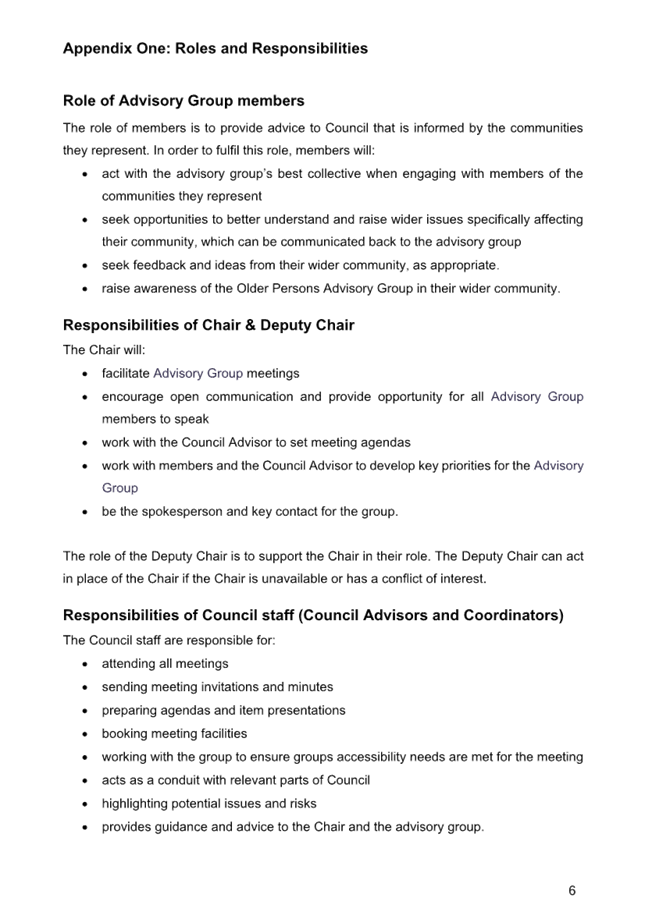
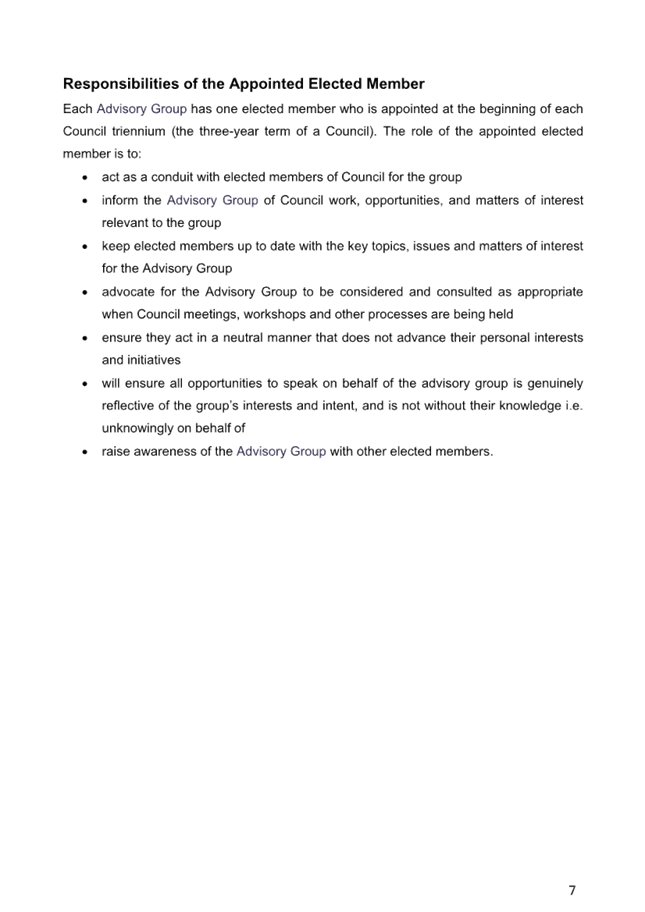
|
Council Meeting Agenda
|
27 March 2025
|
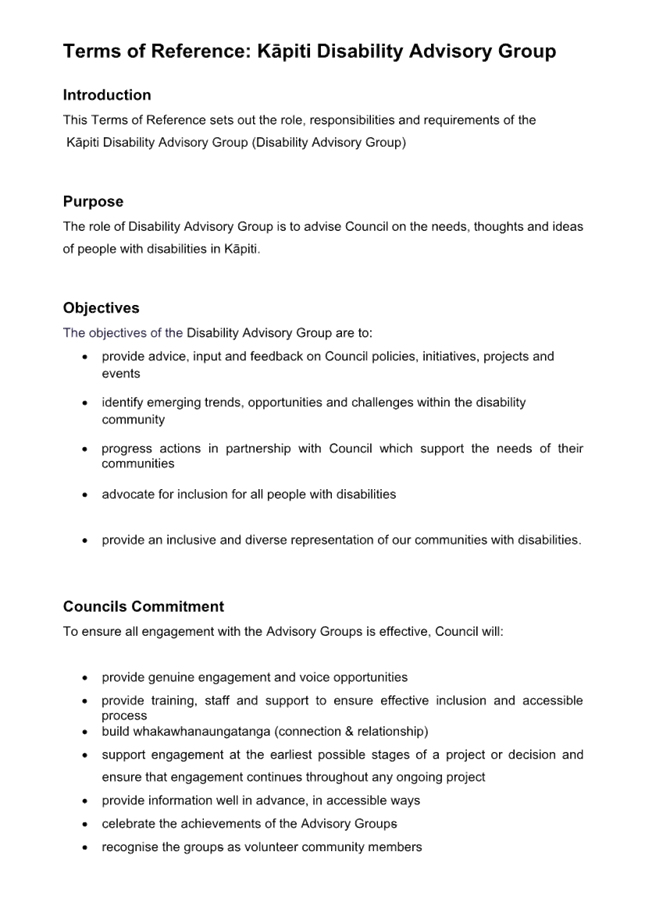
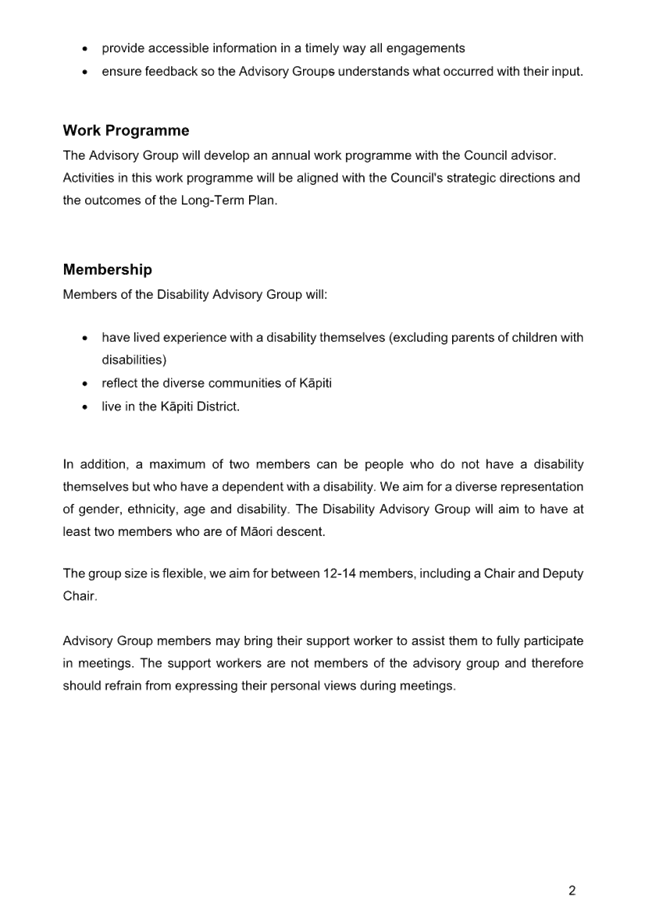
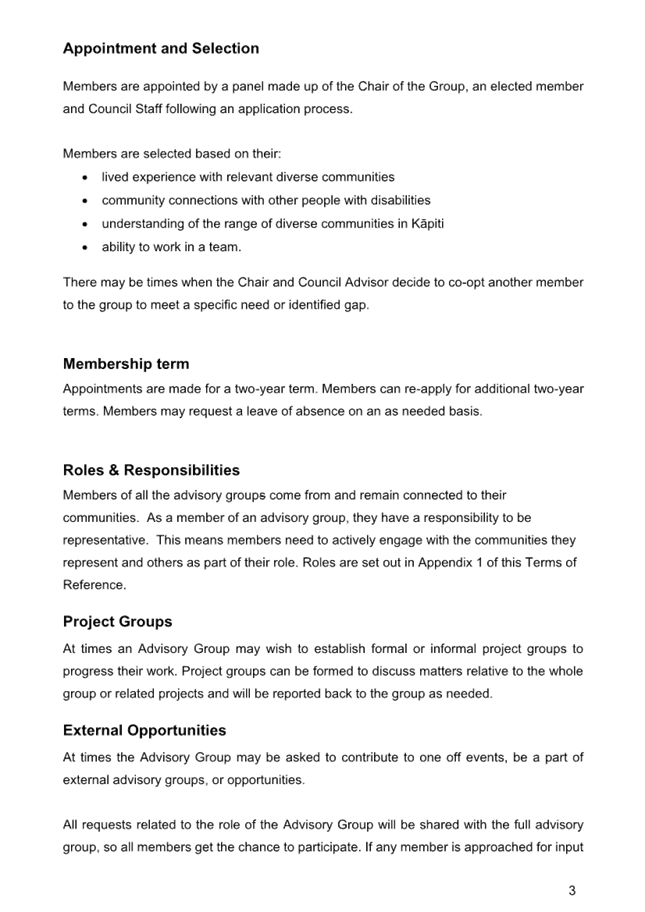
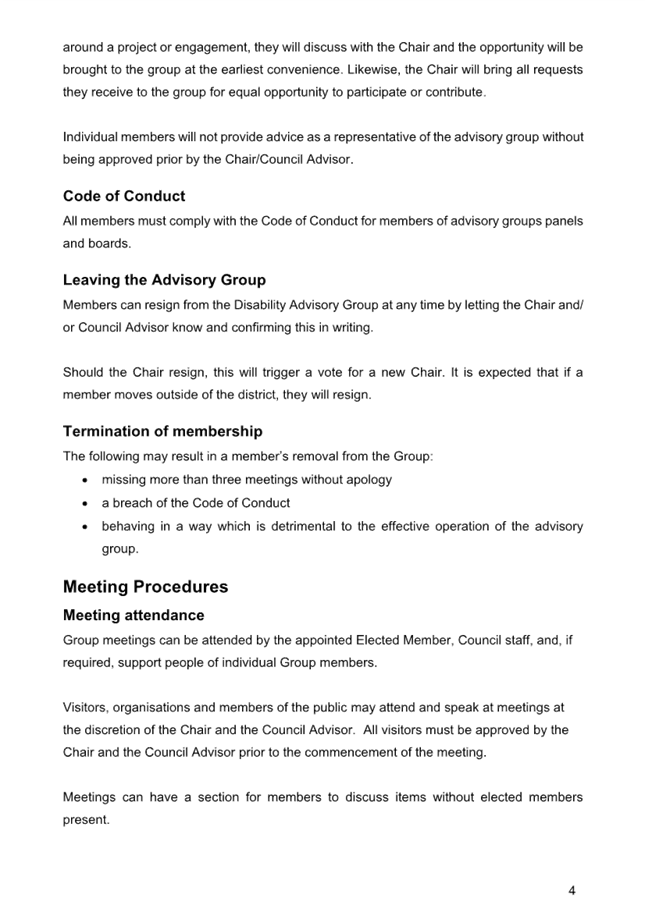
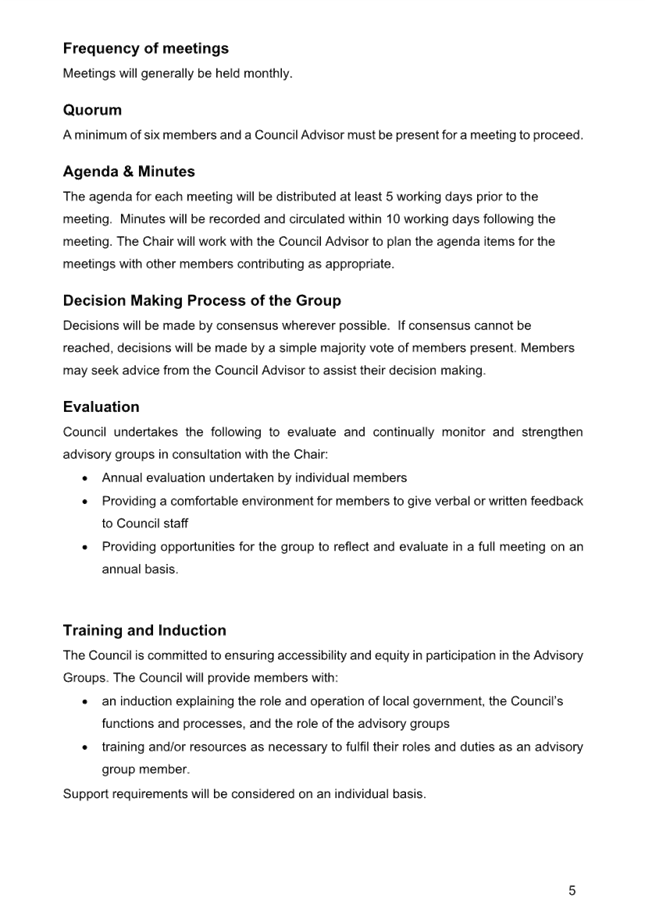

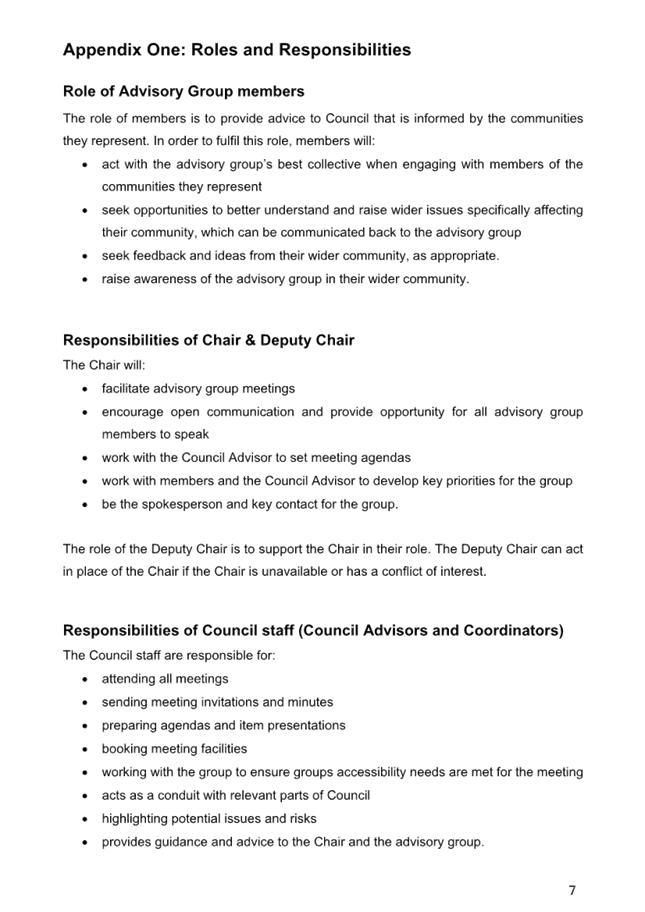
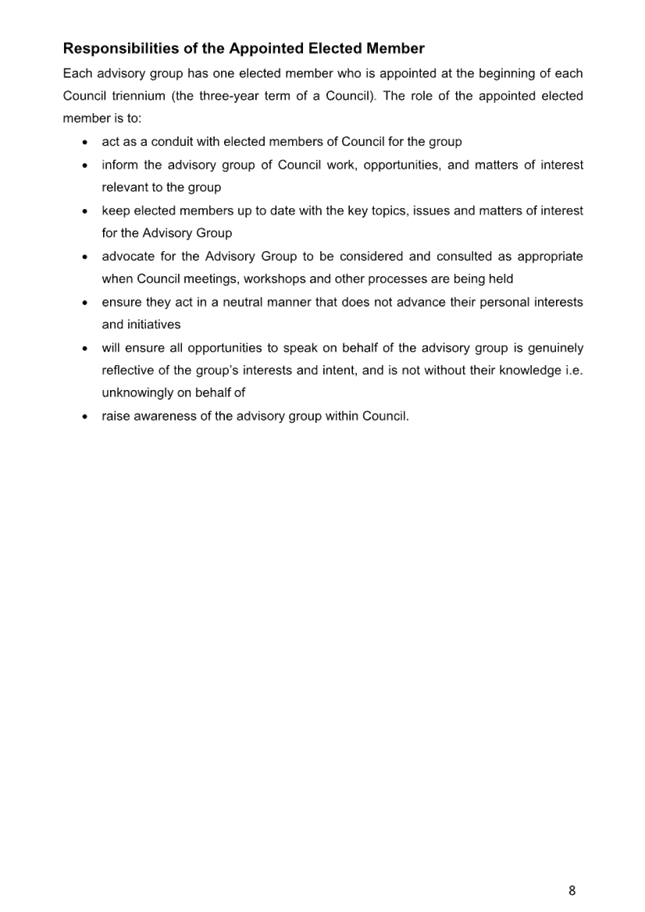
|
Council Meeting Agenda
|
27 March 2025
|
11.2 Approval to Consult on
the Freedom Camping Bylaw
Kaituhi |
Author: Victor
Walker, Principal Policy Advisor
Kaiwhakamana
| Authoriser: Kris Pervan, Group Manager Strategy & Growth
Te pūtake |
Purpose
1 This
report seeks Council approval to consult on a new Freedom Camping Bylaw 2025.
He
whakarāpopoto | EXecutive summary
2 An
Executive Summary is not required.
Te tuku haepapa
| Delegation
3 Council
has authority to make the decisions being considered in this report.
Taunakitanga | RECOMMENDATIONS
4 That
Council:
A. Note the review
the Freedom Camping Policy 2012.
B. Agree, as a
result of the review, to replace the existing Freedom Camping
Policy 2012 with a new Bylaw.
C. Approve, for
consultation (refer to attachments A, B and C):
· Proposed
Freedom Camping Bylaw 2025;
· The
Statement of Proposal; and
· Summary
of site assessment.
D. Delegate authority to
the Chief Executive to approve any minor or technical amendments to the
consultation documents.
E. Note that
consultation is proposed between 2 April to 2 May 2025
Tūāpapa | Background
5 The review
of the Freedom Camping Policy 2012 commenced in 2024 as part of Council’s
Policy Work Programme 2021-2024. In summary:
5.1 Freedom
camping is supported by the Freedom Camping Act 2011 (the Act). It involves
camping on public land[1]
that isn’t a recognised camping ground using a motor vehicle, tent or
other type of temporary structure. Freedom camping does not include short term
parking, day-trip excursions, resting at the roadside in a motor vehicle to
avoid driver fatigue, or using a vehicle as accommodation for those that are
homeless.
5.2 The
Act applies to all Council owned and managed land. The ability to restrict or
prohibit freedom camping in a local authority area can be achieved through a
Bylaw made under the Act, or under any other legislation. However, Freedom
camping can be managed under the Act, or other legislation.
5.3 Council
currently manages freedom camping through its Freedom Camping Policy 2012 (the
Policy) and the Public Places Bylaw 2010, alongside the Act.
5.4 The
Policy was first developed in 2010 and last revised in 2012. While a review was
initiated on the Policy in 2017, this was paused while a sector review was
undertaken by the Responsible Camping Working Group to identify ways to better
manage the freedom camping system. The current Policy looks to:
5.4.1 Ensure
freedom camping on the Kāpiti Coast is managed well.
5.4.2 Improve
the quality of the freedom camping experience and help reduce nuisance
complaints, damage or degradation of the environment and conflict with
residents.
5.4.3 Limits
freedom camping to self-contained campervans and identifies nine sites for
freedom camping across the District with limits on the time people can stay at
them.
5.4.4 A
survey was undertaken in January-June 2023 to understand the freedom camping
experience in Kāpiti. The survey showed that:
· A
large proportion of visitors were kiwis; and their reasons for visiting the
Kāpiti Coast were varied, sometimes associated with travel to and from the
South Island, at other times specifically for interests in Kāpiti.
· Most people stayed
at one of the designated Council freedom camping sites for one night. Of
concern, they stated that our 24-hour restrictions are out of sync with most
other districts in New Zealand.
· Eighty-four
percent spent in excess of $100 per day; and around twenty percent spent over
$400. Most spending was at local eateries and vehicle service costs.
· Seventy-five
percent travelled for the purpose of a holiday, with around twenty percent
travelling as a long-term or permanent lifestyle choice.
· Thirty percent of
respondents said there were not enough freedom camping areas in our District.
6 Council's
reserves are currently managed under the Reserves Act 1977, which prohibits
camping activities on reserves unless supported by a reserve management plan.
Council is currently in the process of reviewing reserve management plans for
its recreational reserves and parks. Further discussion of the treatment of
reserves and future suitability for freedom camping is provided in the Options
section of this paper.
7 This
paper outlines options for potentially introducing a new Freedom Camping Bylaw.
As background:
7.1 Councils
are empowered to make bylaws to manage freedom camping in their area under the
Act. In making the bylaw to prohibit or set restrictions on self-contained
vehicles, tents or other temporary structures, the Council must do an
assessment process to be satisfied that the bylaw is:
7.1.1 necessary
to protect the area.
7.1.2 necessary
to protect the health and safety of people who may visit the area.
7.1.3 necessary
to protect access to the area.
7.1.4 the
most appropriate and proportionate way of addressing the problem.
7.1.5 not
inconsistent with the New Zealand Bill of Rights Act 1990.
He
kōrerorero | Discussion
8 Attached
for your consideration is the suite of documents to support introducing a new
Freedom Camping Bylaw:
8.1 Proposed
Freedom Camping Bylaw (Attachment A);
8.2 Statement
of Proposal (Attachment B);and
8.3 Summary
of site assessment (Attachment C).
9 As
you are aware, we have undertaken a review of the 2012 Policy. It included
initial scoping and analysis to understand freedom camping in the Kāpiti
Coast District – who, their interests (or concerns); and our communities
views on the current freedom camping policy. More specifically:
9.1 Analysing
data related to:
9.1.1 Compliance
monitoring from 2018.
9.1.2 Freedom
camping ambassadors engagement in the district in 2023 and 2024.
9.1.3 Survey
of freedom campers over the January-June 2023 period.
9.1.4 Freedom
camping-related service requests and correspondence from 2013.
9.1.5 CamperMate
information on the numbers and timing of visitors to the district.
9.2 Desk-top
review of the settings and approaches taken by neighbouring local authorities
and some selected Councils from elsewhere in New Zealand.
9.3 Engagement
with our mana whenua partners and several key stakeholders[2] to understand issues,
opportunities and alternative approaches for freedom camping within and
adjoining the district.
10 Insights
from this analysis and review were provided to:
10.1 Community
Board’s during April and May 2024.
10.2 Elected members and mana whenua partners in June and October 2024, to
highlight feedback on current issues, concerns and potential opportunities; this included discussion on the potential
option to intorduce a Freedom Camping Bylaw.
10.3 A Council workshop in November 2024 provided an overview of council
land for freedom camping, and the identification of areas proposed to be
restricted or prohibited for freedom camping.
11 On
the basis of analysis and the recommendations noted in the Sections below, a
Freedom Camping Bylaw 2025 is proposed. Of note, it:
11.1 Is
based on the Local Government New Zealand standard model bylaw that has been
developed and used by other Councils across the country.
11.2 Does
not need to include specific offence and penalty provisions as the Act provides
various offences (infringement fines) that apply to any restrictions or
prohibitions specified in a Bylaw. The Act also
provides for offences relating to the discharge of a substance likely to be
noxious, dangerous, offensive, or objectionable; or obstructing (or inciting
another person to obstruct) an enforcement officer to be addressed.
He
take | Issues
12 Analysis
of freedom camping data and discussions identified a number of key issues and
opportunities that were used to assess the effectiveness of the current policy,
and viability of introducing a new bylaw.
13 In
summary, key opportunities include:
13.1 Increasing tourism potential
from visitors:
13.1.1 Freedom
camping can benefit the Kāpiti Coast. It helps to promote tourism and
attracts visitors who contribute to the local economy, often looking for
experiences in nature without the constraints of traditional accommodation.
13.1.2 The
Kāpiti Destination Management Plan (KDMP) has the key objective of
increasing visitor numbers to the District and acknowledges freedom camping as
a source of visitation.
13.1.3 Improved
access from the new expressway and Transmission Gully has meant that
traditional spots closer to Wellington have been bypassed encouraging visitors
to the district. Visitor numbers have increased form regular site visits of
between 1,000-2,000 vehicles over the summer period to between 5,000-6,000
recorded vehicles over the summers of 2023 and 2024 (since Covid-19).
14 In
summary, key issues include:
14.1 The
misalignment with our policy and the recently updated Freedom Camping Act:
14.1.1 In
2023 the Government amended the Freedom Camping Act 2011 by requiring that
vehicles used for freedom camping must be certified as self-contained through a
certification process overseen by the Plumbers, Gasfitters, and Drainlayers
Board.
14.1.2 The
Act also changes the premise for freedom camping in a motor vehicle that is not
self-contained. Changes to restrict or prohibit self-contained vehicles, or
permit non-self-contained vehicles can only be made by a Council under a Bylaw
made under the Act or by another piece of legislation.
14.1.3 The
2023 changes mean the Freedom Camping Policy 2012 no longer aligns with the
current Act.
14.2 The unintended impact of increasing number
of visitors and legislated changes:
14.2.1 Has
resulted in an increased number of self-contained and larger sized vehicles
across the district which has negatively impacted parking, safety, increased
demand on waste management services (due to rubbish dumping), and congestion
around several of the existing sites.
14.3 Specific
issues have arisen at the North Bank, Ōtaki River site:
14.3.1 The
North Bank of the Ōtaki River is one site that has seen a substantive
increase in users and pressures with its access and location. The site was
identified in the Policy as suitable for six freedom camping vehicles at any
one time and a maximum stay of 48 hours. However, the number of freedom campers
using this area is much higher, with up to 30 vehicles freedom camping in the
area at peak times.
14.3.2 This
increased level of activity has resulted in concerns from local mana whenua and
residents with regards to health and safety and access to the area alongside
the impacts usage is having on the environment.
14.3.3 Our
assessment of this site has confirmed these impacts and has also subsequently
identified that the site is Crown land. As this is not Council land the site
has been removed from the review process. Actions have already been taken to
remove signage and update information on supporting websites to reflect this
change in status. In light of this, we have given careful consideration of the
suitability of the Marine Parade carpark at the end of Tasman Road for freedom
camping in the Ōtaki area.
Ngā
kōwhiringa | Options
15 Two options are
proposed for consideration in the future management of freedom camping:
|
Options
|
Detail
|
|
1 - Status quo: continue to manage freedom camping using
the Freedom Camping Act in combination with a revised Council policy.
|
Review the existing Policy, and update it. Use existing
legislation such as the LGA, Land Transport Act 1998 and the Reserves Act
powers and actions to manage freedom camping.
|
|
2 - Introduce a bylaw under the Freedom Camping Act
|
Adopt a Freedom Camping Bylaw
under the Freedom Camping Act, and describe the locations in Kāpiti
Coast where freedom camping in vehicles that are:
· Self-contained,
tents and other temporary structures will be: restricted, and what
restrictions will apply; or where it is prohibited.
· Not
self-contained will be permitted, and what if any requirements apply.
Overall, as noted in the Statement of Proposal, the Bylaw
will prohibit areas in town centres, camping on roads where the speed is
80km/hr, support longer stays for self-contained vehicles, limit vehicle stay
in one area to up to 28-days, limit vehicle length to 8m (in most areas), and
increase the restricted use of freedom camping sites from 9 to 11 (see page 9
of the Statement of Proposal).
Note - Council officers identified that the car park
opposite 54 Marine Parade and the Waikanae River Mouth – Tutere Street
were no longer suitable for freedom camping. These are removed from the
Statement of Proposal (attached).
|
16 We have assessed the
feasibility and effectiveness of the two options in regards to management of
freedom camping and enforcement, as follows:
|
Table 2: Option Benefits
and Risk Table
|
|
Kōwhiringa |
Options
|
Hua | Benefits
|
Tūraru | Risks
|
|
Option One:
Freedom Camping Policy
|
A policy already exists and provides some
flexibility for managing freedom camping – e.g. reflecting an education
first approach
|
A policy lacks the level of enforceability and
access to additional powers provided by a bylaw under the Freedom Camping
Act.
Council requirements for freedom camping could be
ignored by some
Community continues with frustration and potential
for conflict around unwanted behaviours.
As a result, Council has largely taken an educational
approach to manage effects from freedom camping to date.
|
|
Option Two: (recommended)
Freedom Camping Bylaw
|
Reflects the design intent of the Freedom Camping
Act
Provides access to enforcement and infringement
powers under the Act.
|
Future amendment of a bylaw requires a statutory
process to be followed.
Increased expectations for enforcement which may
require additional resourcing.
|
Mana whenua
17 We
have engaged with mana whenua partners as part of this review process alongside
discussions on reserve management planning. This has also included liaison
through the Iwi Partnerships team to support the site assessment process.
18 Mana
whenua have raised particular concerns relating to the increase in activity and
impacts of freedom camping behaviour through Te Whakaminenga o Kāpiti.
Ngā Hapu o Ōtaki have also raised concerns directly with regards to
activity at the Ōtaki river mouth.
19 Mana
whenua feedback has been considered and reflected in the Statement of Proposal
within the bounds of the Act and provision for making a Bylaw. Further
engagement will be undertaken as part of consultation on the proposed Bylaw.
Discussions are also ongoing around operational support for managing freedom
camping reflecting the interest of mana whenua as kaitiaki of the District.
Panonitanga Āhuarangi me te Taiao | Climate change
and Environment
20 The
consideration of Freedom Camping in our district has an obvious and direct
impact on the environment through vehicle emissions. The significant measure is
the Government’s change to the Freedom Camping Act to give greater
freedom to camp on local authority land. This change and the growth in freedom
camping in our district are factors outside of our control.
21 The
suitability of Council’s other reserves for freedom camping will be
considered as part of the process to update the Reserve Management Plans under
the Reserves Act 1977. This work is now underway. The proposed Bylaw contains a
clause to make it clear that a person must not freedom camp on a Council
reserve unless freedom camping is expressly allowed for by that reserve’s
Reserve Management Plan.
Ahumoni me ngā rawa | Financial
and resourcing
22 Overall, it is likely
that the net cost for introducing a Bylaw is minor on the basis that:
22.1 A
Bylaw brings more comprehensive powers of enforcement under the Freedom Camping
Act, but also potentially greater expectations from the public about monitoring
and enforcing compliance with the bylaw. The use of a Bylaw and its supporting
infringement notices under the Act will create a cost offset to compliance
activities.
22.2 There
will be opportunities to partner with others, and to share costs, for providing
specialised freedom camping areas or facilities to support freedom camping
across the District. Potential for these opportunities will be further
considered as part of the reserve management review process and as part of the
ongoing management and engagement with stakeholders.
23 Of note, the proposal
to establish freedom camping areas in the Kāpiti Coast will require some
minor additional operational expenditure, which is not set within the current
Long-Term Plan. This would be fore layout and marking of campervan parking spaces
and improved signage – estimated to be around $12-$15,000 in total. It
may also involve some site tree pruning and general tidying up. Some of the
costs will be recoverable from funding through the Governments Transitional
Fund (ie signage).
Tūraru ā-Ture me te Whakahaere
| Legal and Organisational Risk
24 Council
must satisfy itself that the proposed bylaw is the most appropriate and
proportionate way of addressing the perceived problem in relation to that area.
The tests under the Act (outlined in paragraph 9 of this paper) provide for the
protection of an area, health and safety, and right to access, ensure that the
content of the proposed bylaw is justifiable and consistent with the New
Zealand Bill of Rights Act 1990. For the reasons discussed in the issues and
options sections, we believe a bylaw is the appropriate instrument to manage
freedom camping within the District.
25 The
proposal to introduce a Bylaw has followed legislative requirements. The
consultation for the Freedom Camping Bylaw has been planned in accordance with
the principles and process requirements for the Special Consultative Procedure
under the LGA. Hearings will be provided for and are planned for 20 May 2025.
Ngā pānga ki ngā kaupapa here | Policy impact
26 The
making of the proposed Bylaw will follow the consultation and hearing process.
At the meeting that the Freedom Camping Bylaw is agreed and the commencement
date set, there will be a corresponding decision to repeal the existing Freedom
Camping Policy 2012.
27 While
no overlap or transition from the current Policy to the proposed Bylaw is
considered necessary, it will be necessary to correct any bylaw and policy
cross references to the 2012 Policy.
TE whakawhiti kōrero me te
tūhono | Communications &
engagement
Te mahere tūhono | Engagement
planning
28 A
comprehensive communications and engagement plan has been prepared by the
Communications and Engagement Team to support consultation on the Freedom
Camping Bylaw. This will involve a range of communication and engagement
activities, including media engagement, digital advertising, radio advertising
and stakeholder communication.
29 A
dedicated Have Your Say page will be active during the consultation
period of 2 April to 2 May. Hard copy forms and information will also be
available at libraries and service centres.
30 Submitters
will have the option to speak to the Council during hearings in late May. All
written and verbal submissions will be included in the analysis of responses.
Whakatairanga |
Publicity
31 See
section above for engagement on the proposed Bylaw. The
adoption of the proposed Bylaw will be supported by a public communication
campaign including website information, brochures and maps and supporting
signage.
Ngā āpitihanga | Attachments
1. Proposed
Freedom Camping Bylaw 2025
2. Statement
of Proposal for the proposed Freedom Camping Bylaw 2025 (under separate cover) 
3. Summary
of Site Assessment ⇩ 
|
Council Meeting Agenda
|
27 March 2025
|
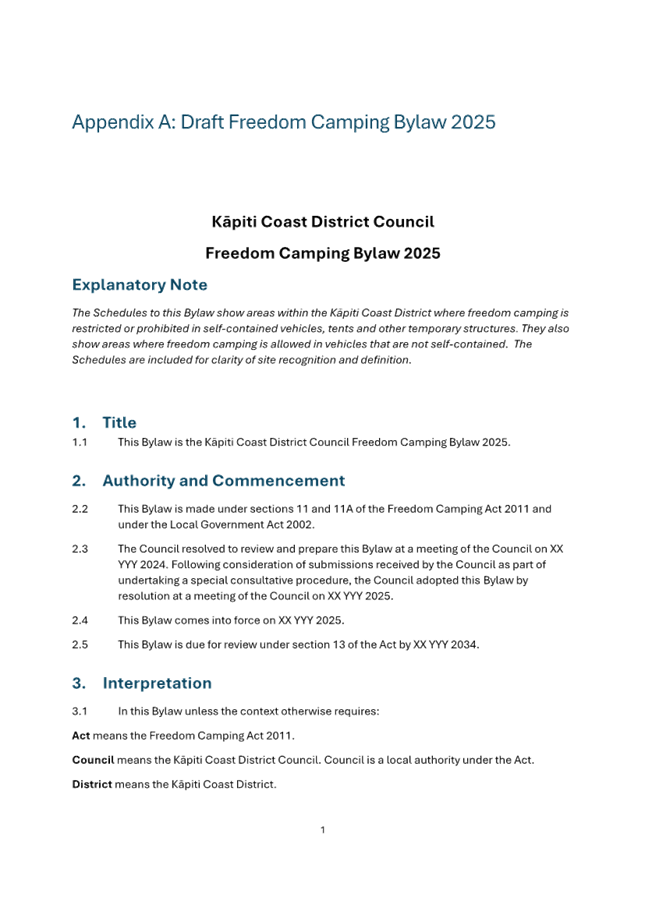
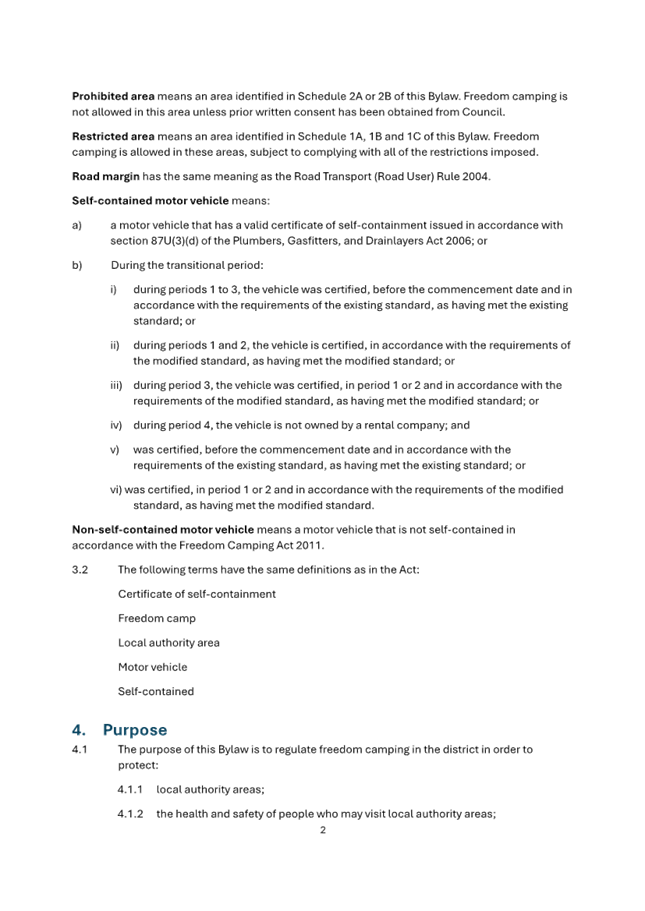
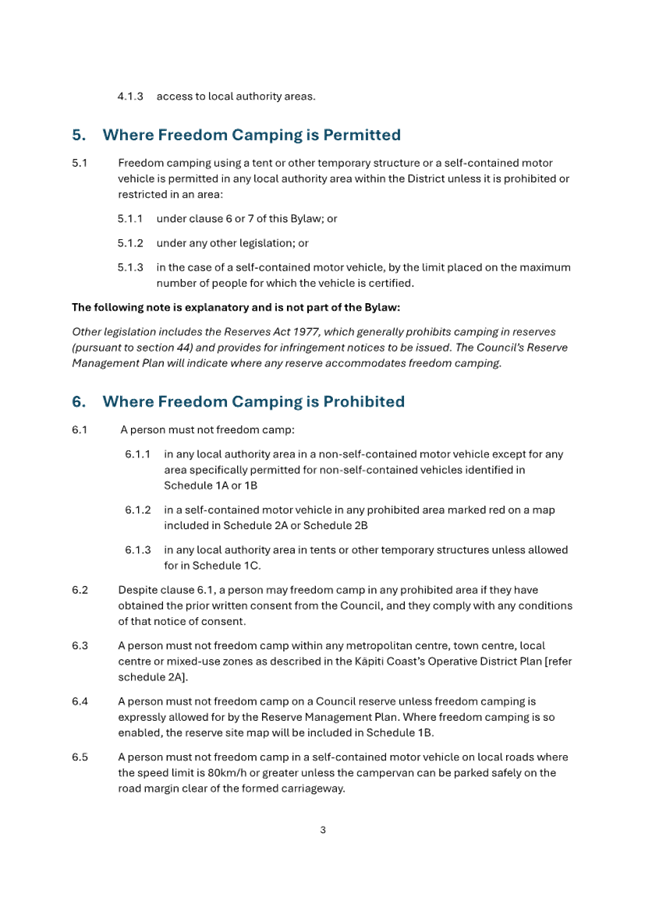
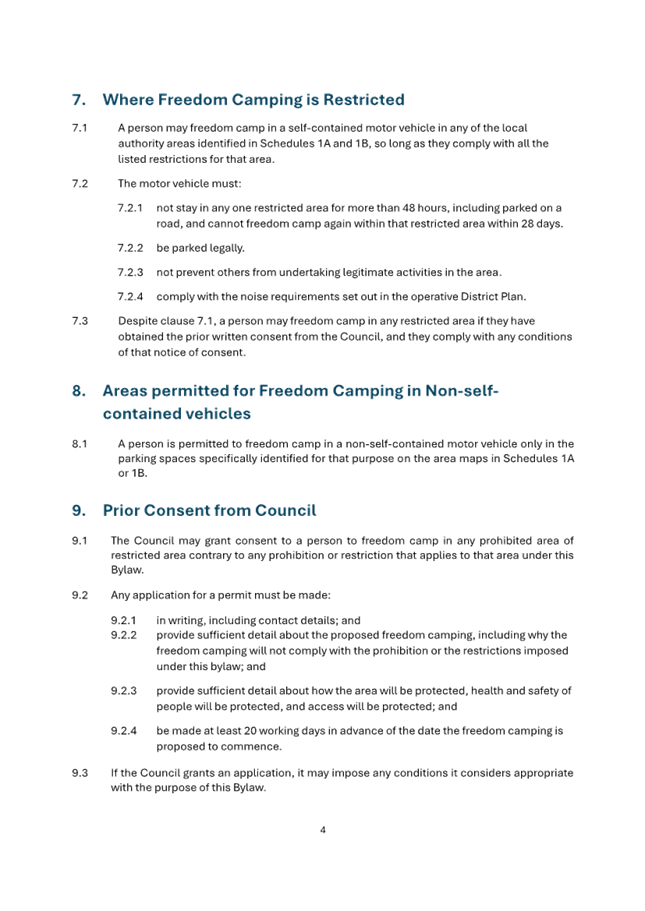
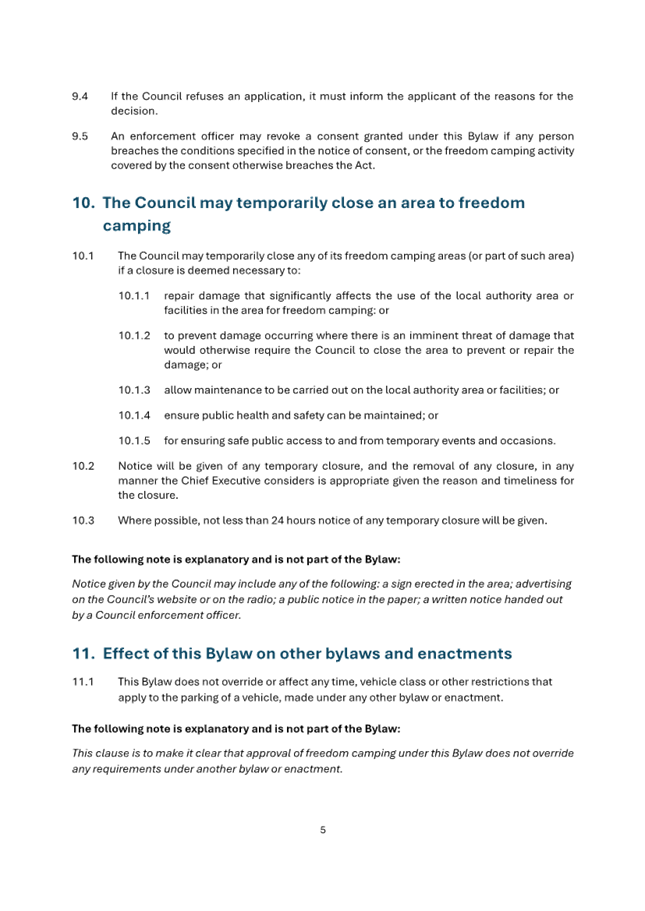
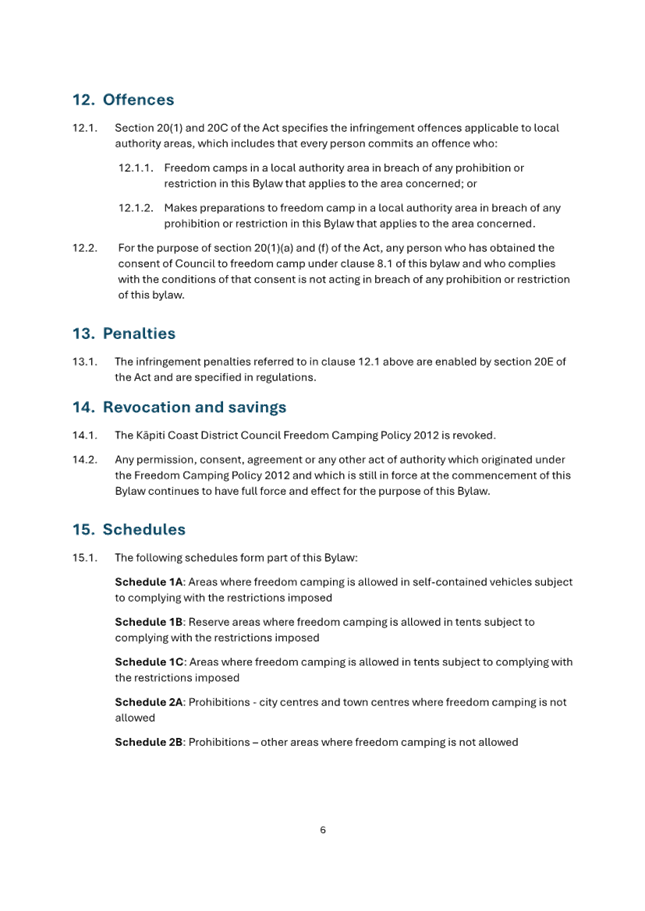
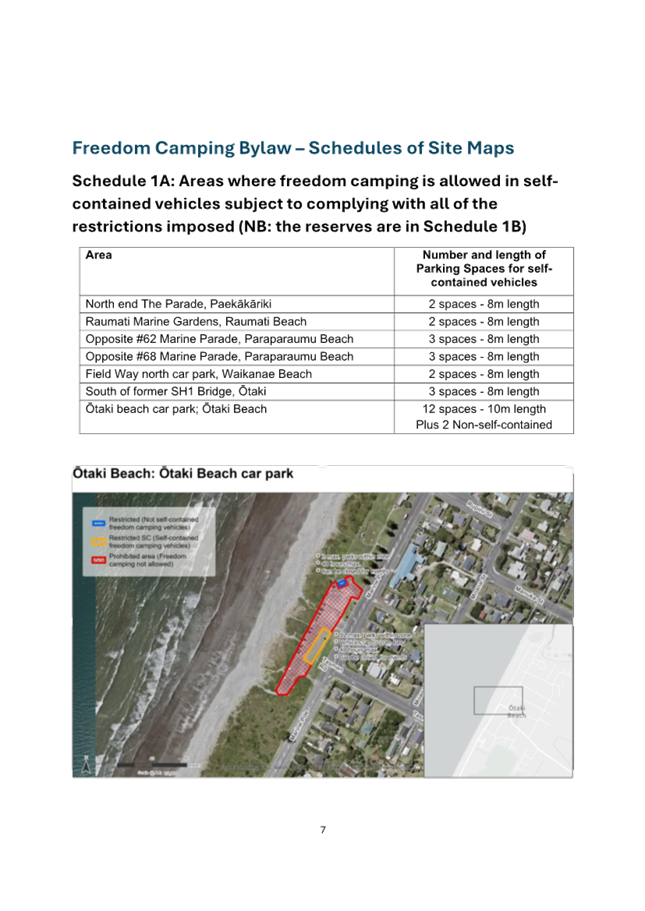
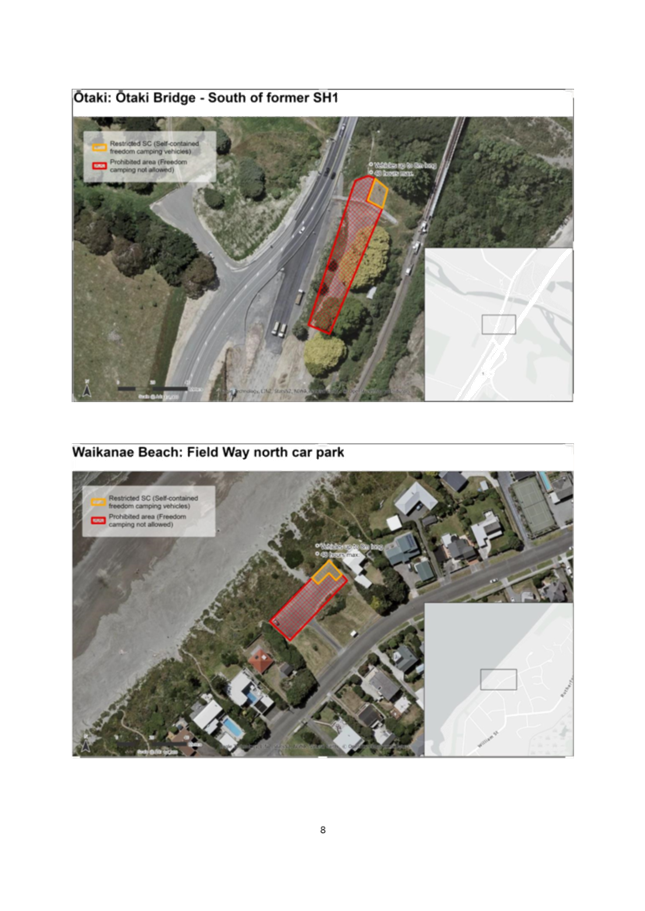
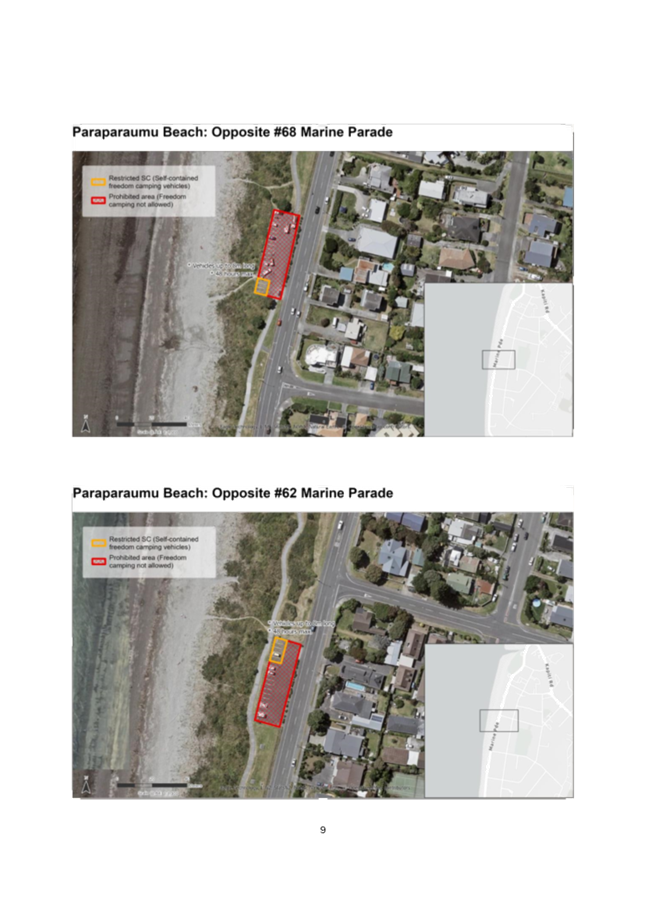
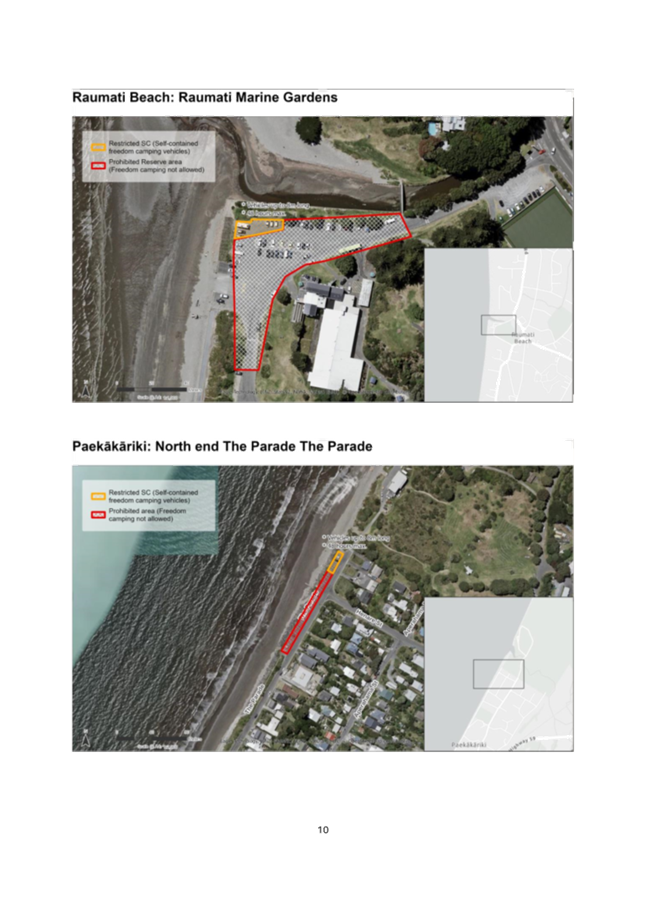
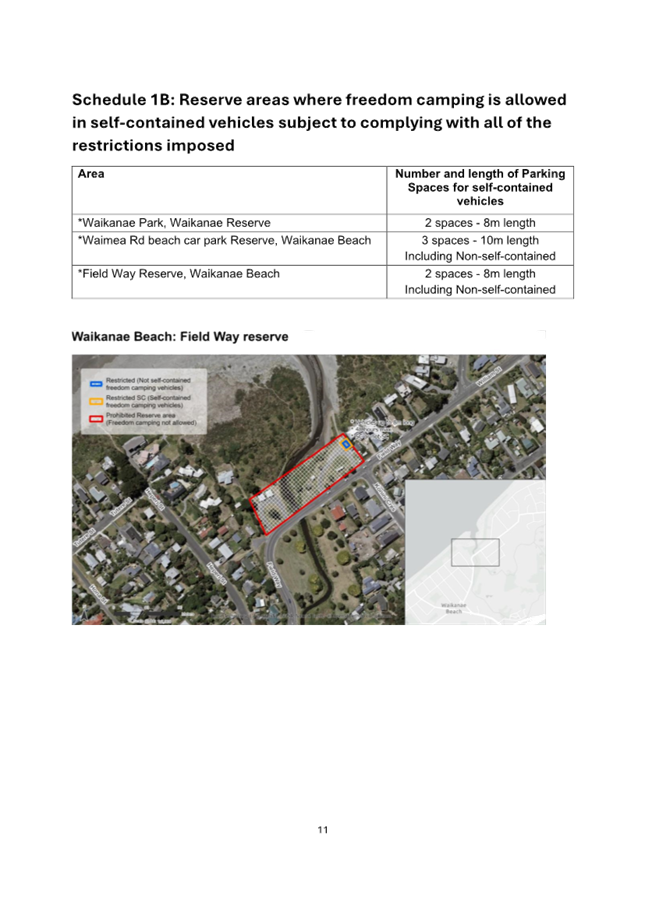
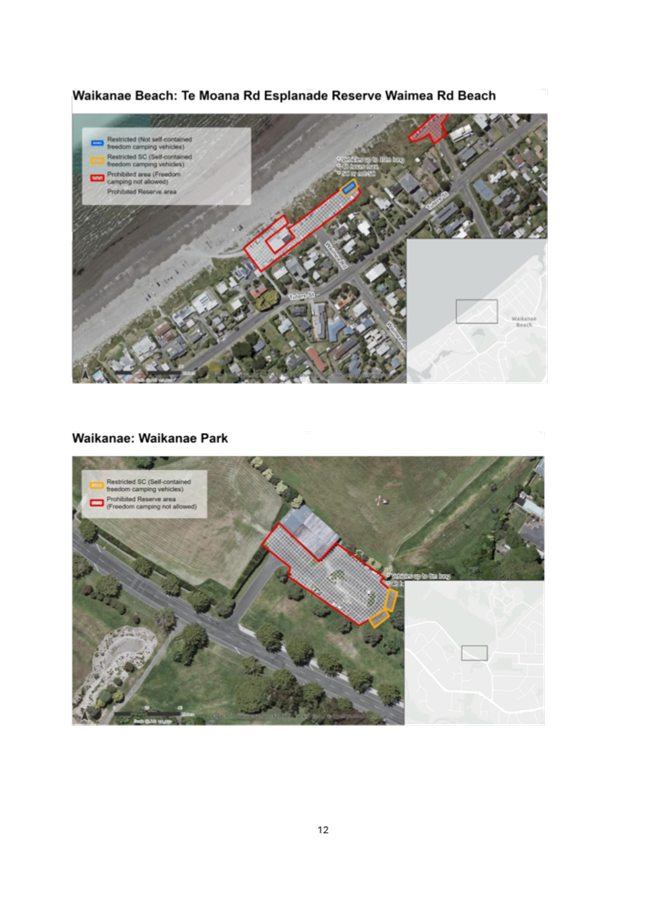
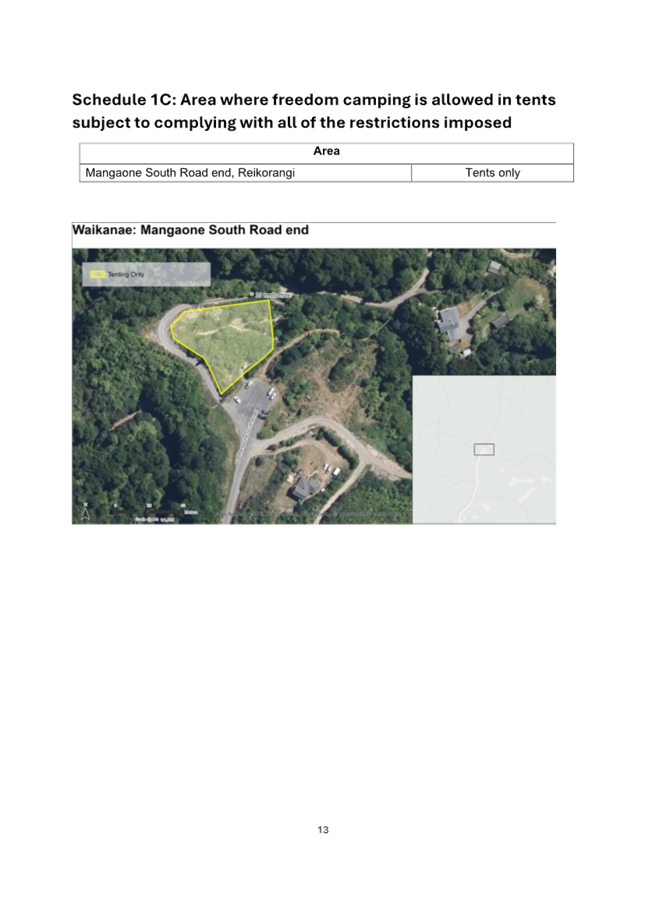
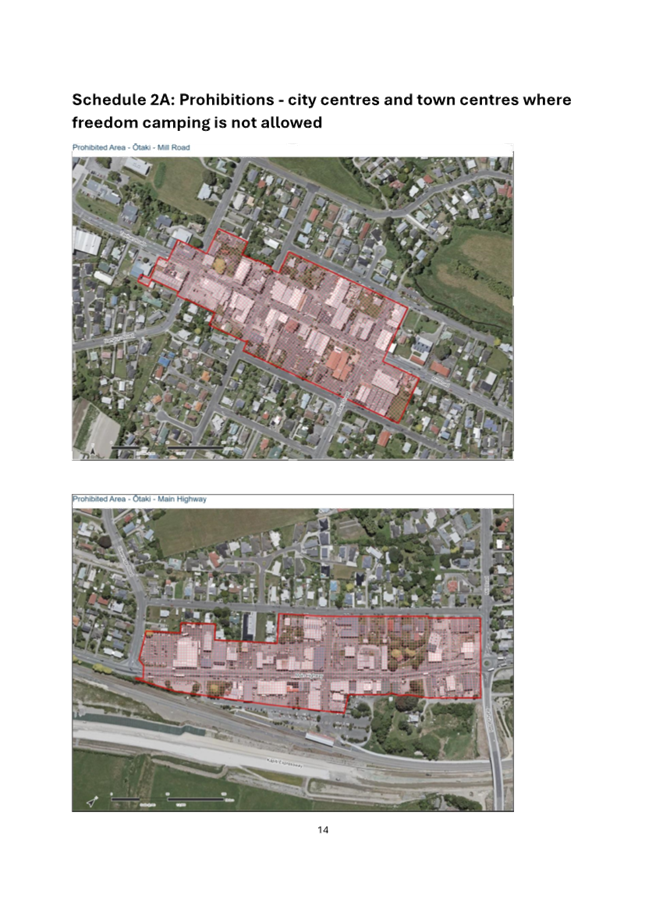
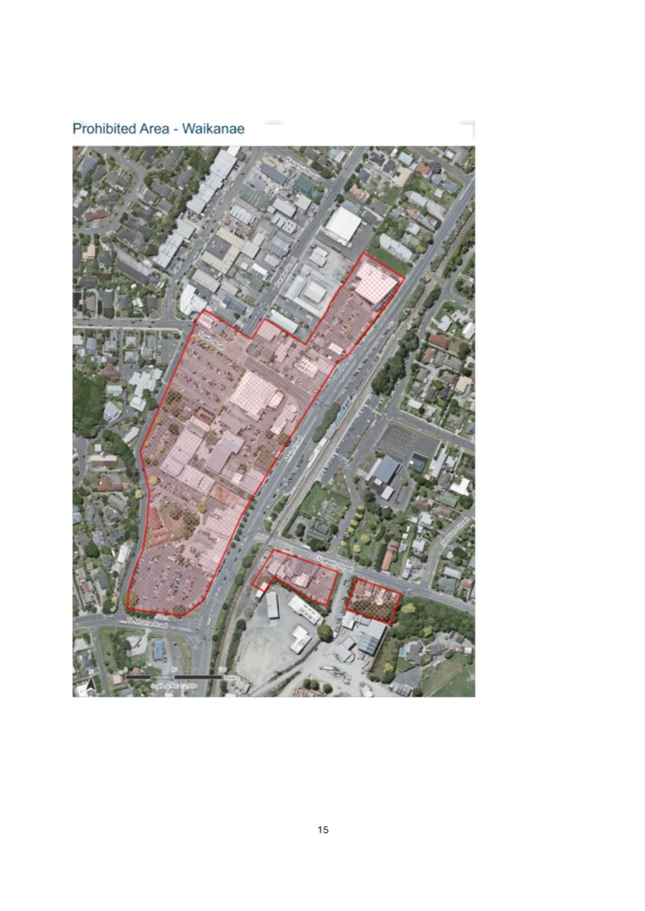
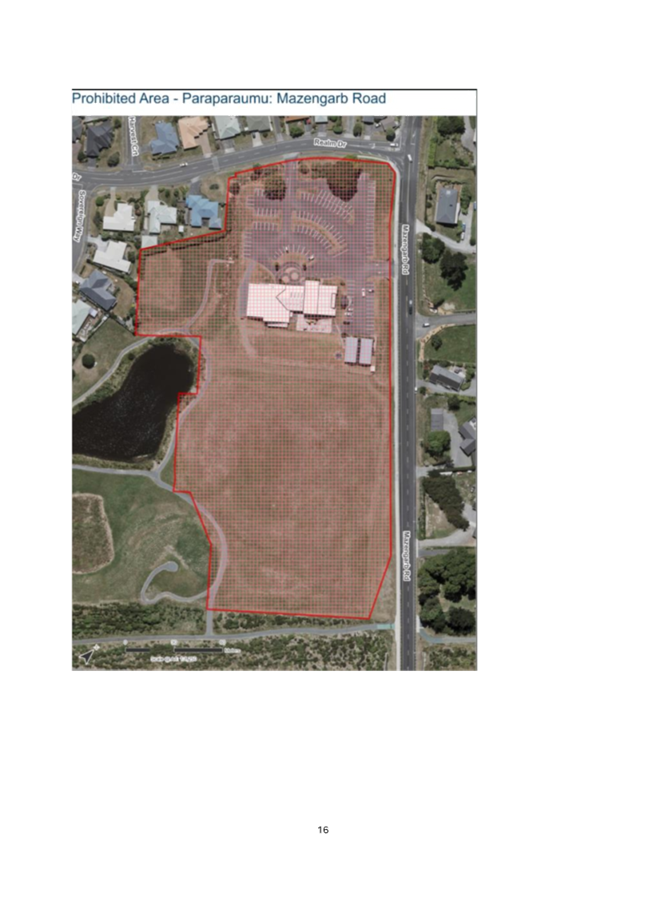
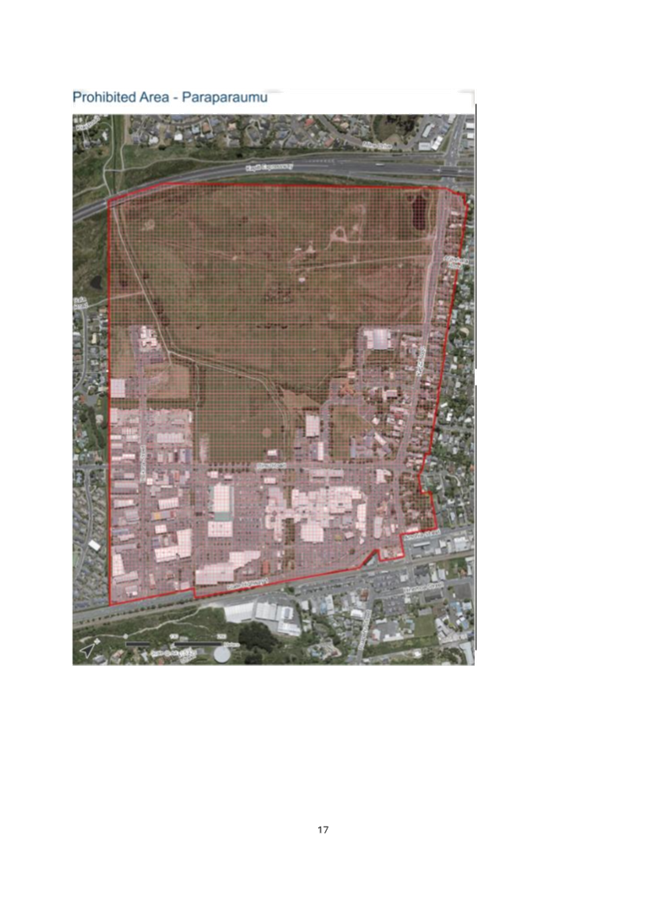
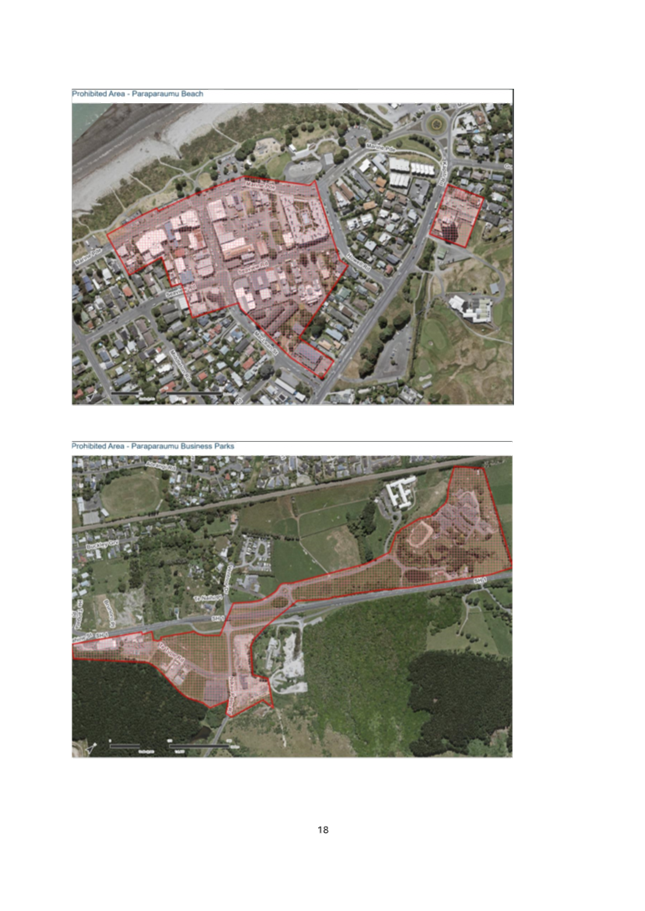
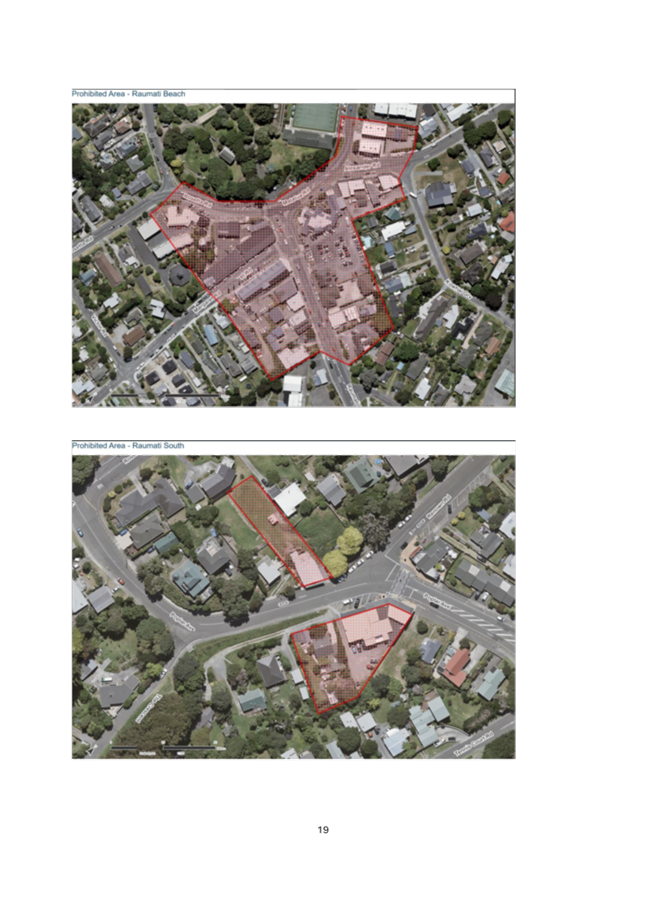
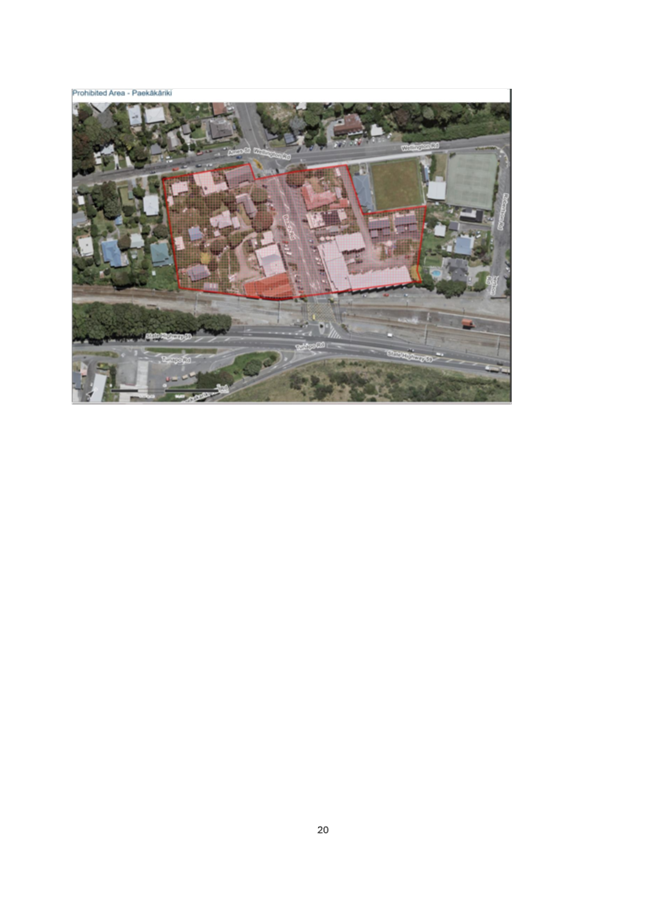
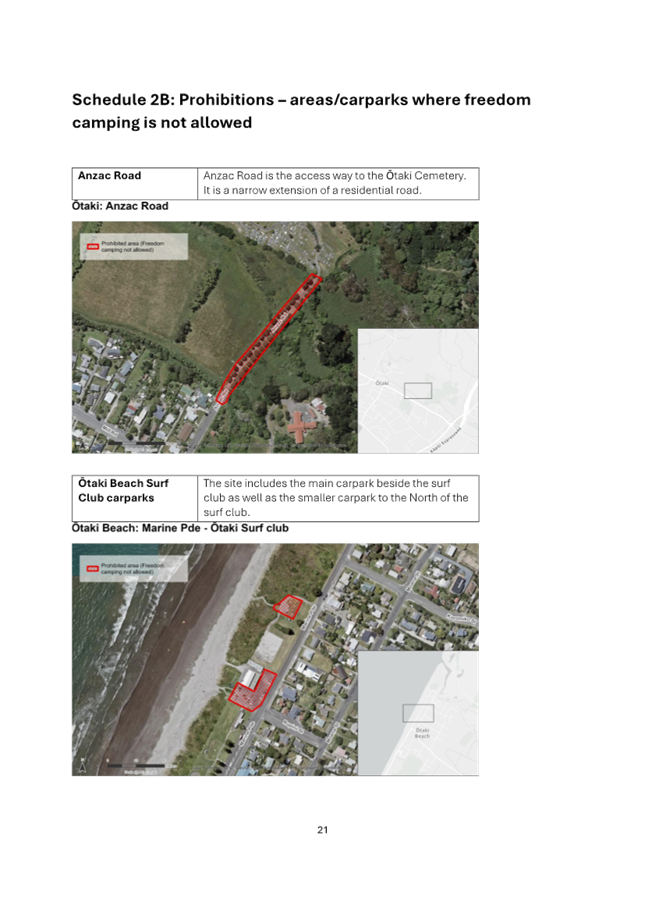
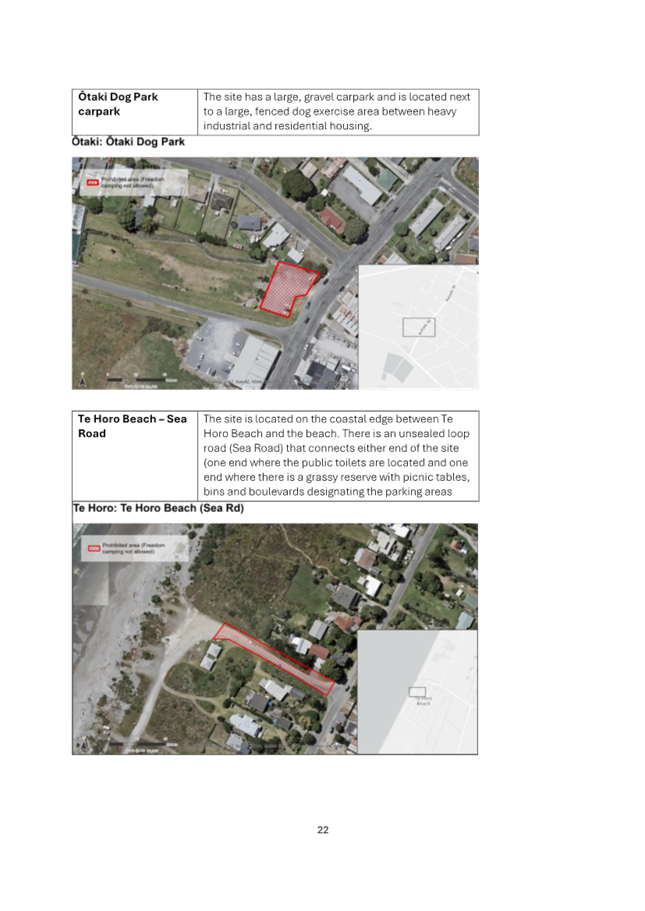
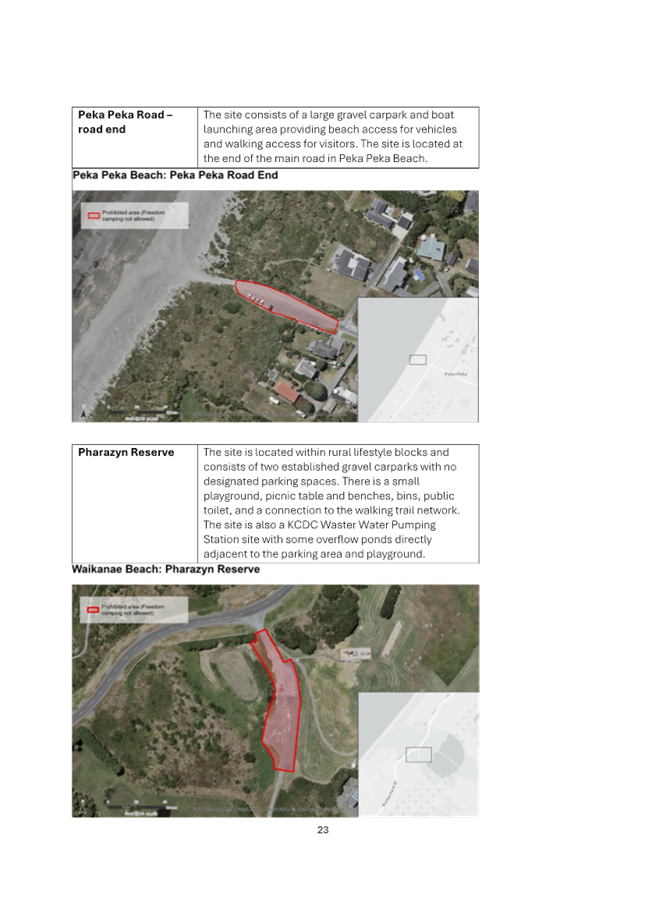
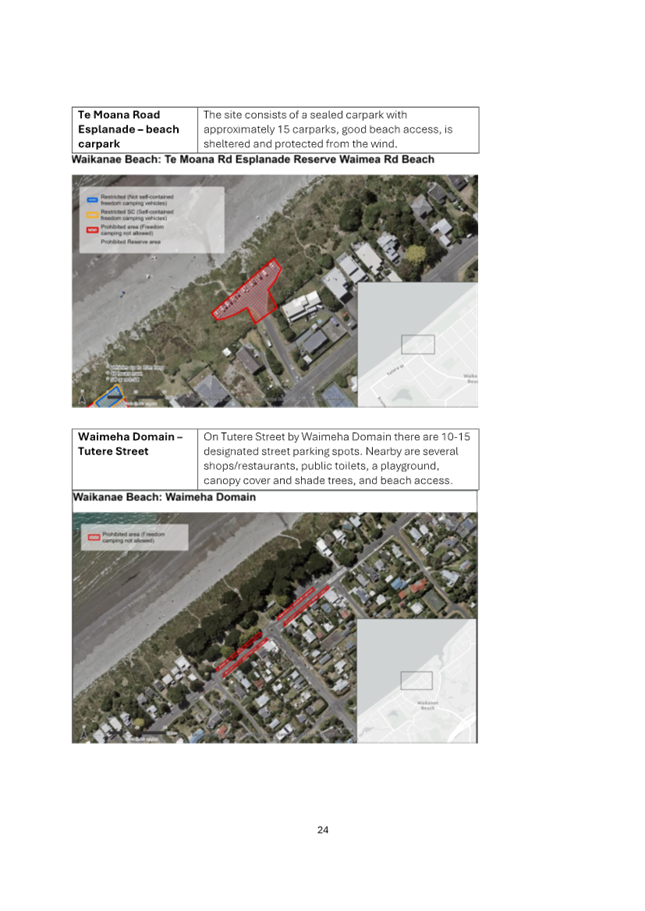
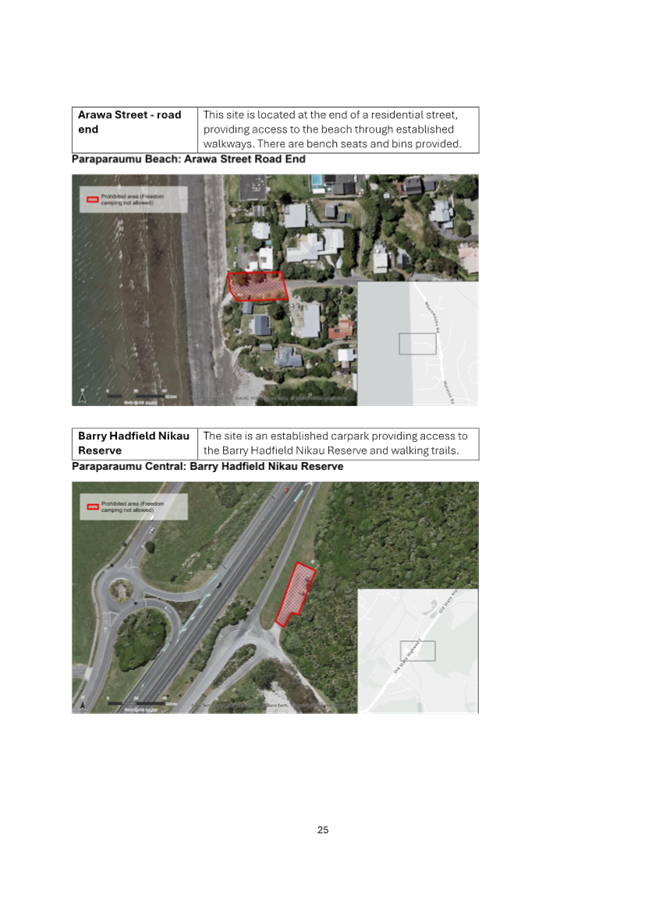
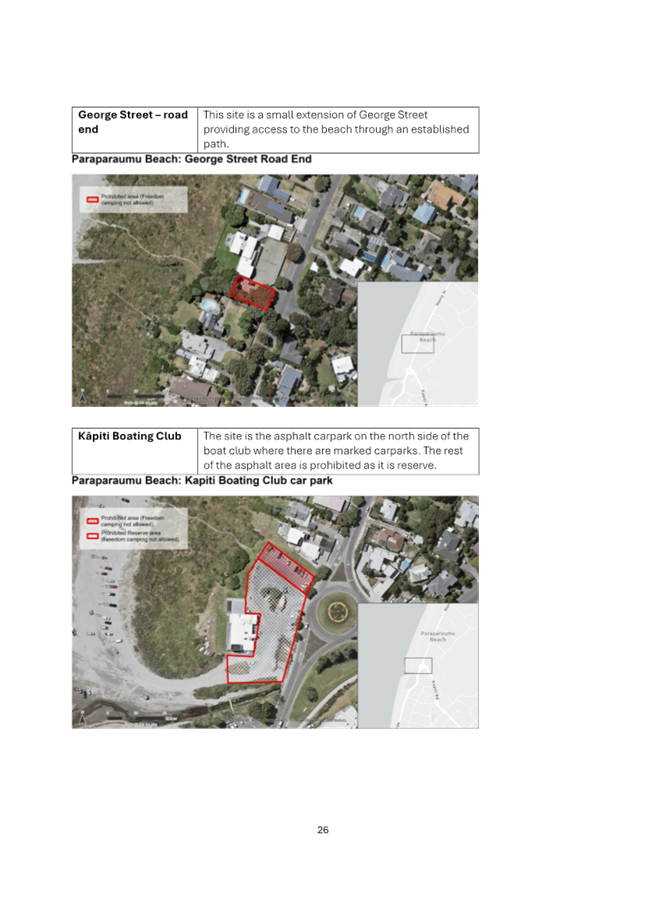
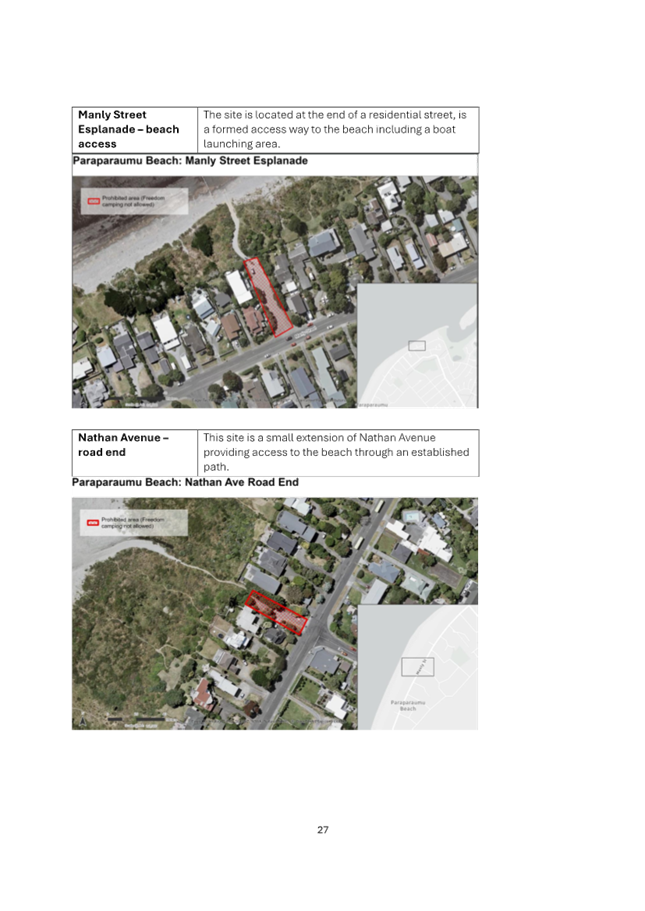
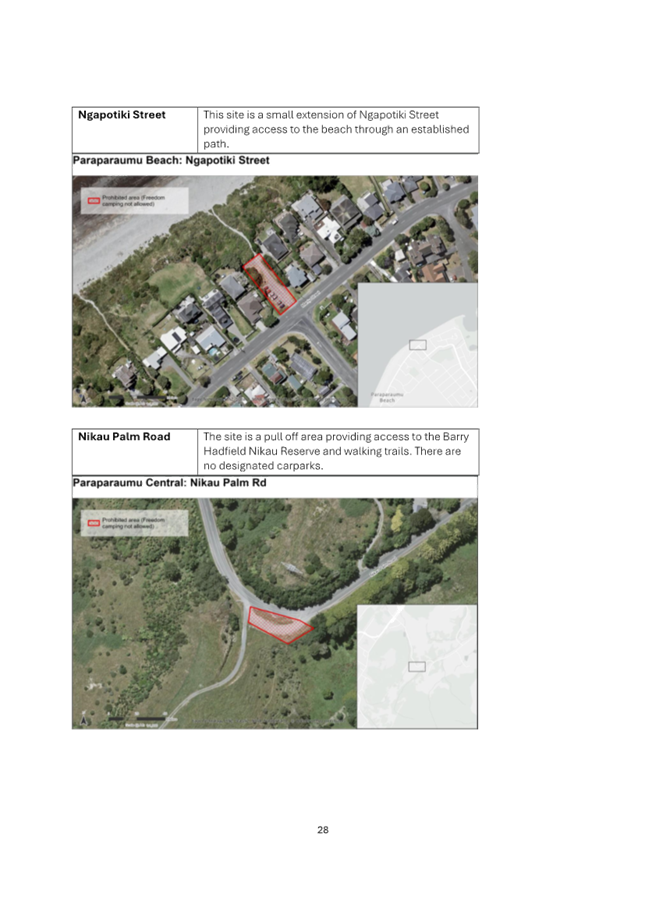
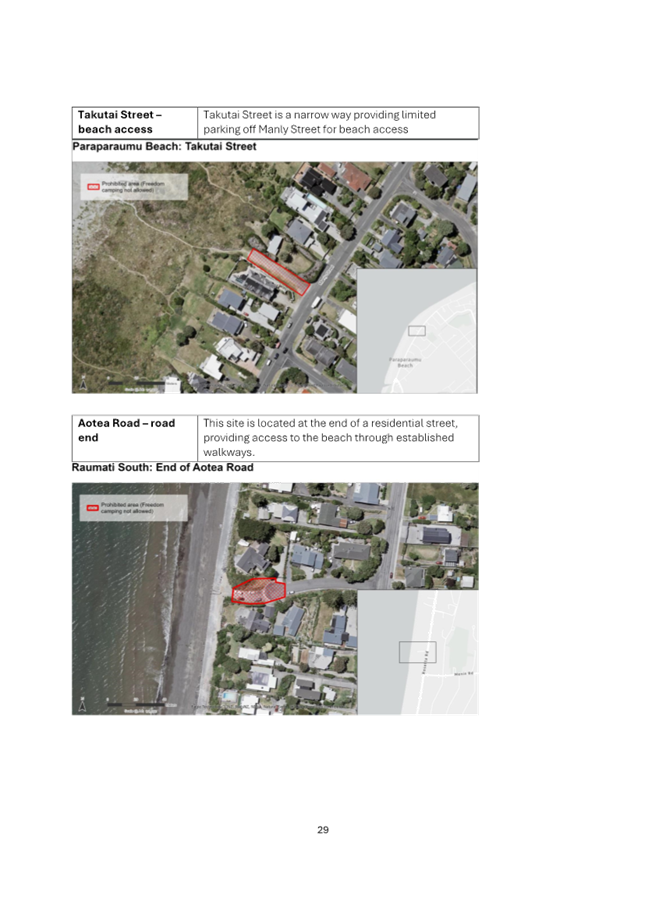
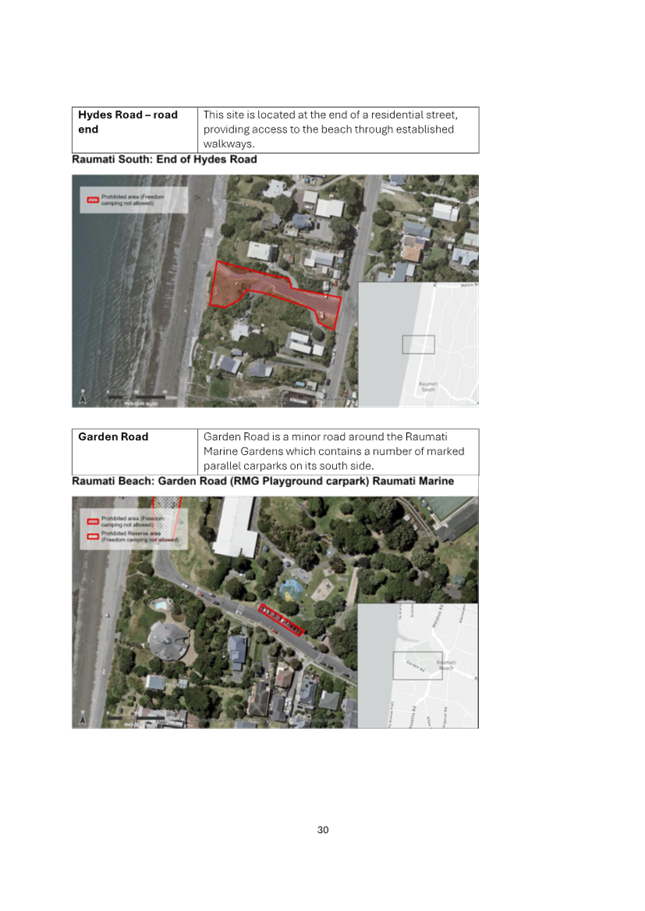
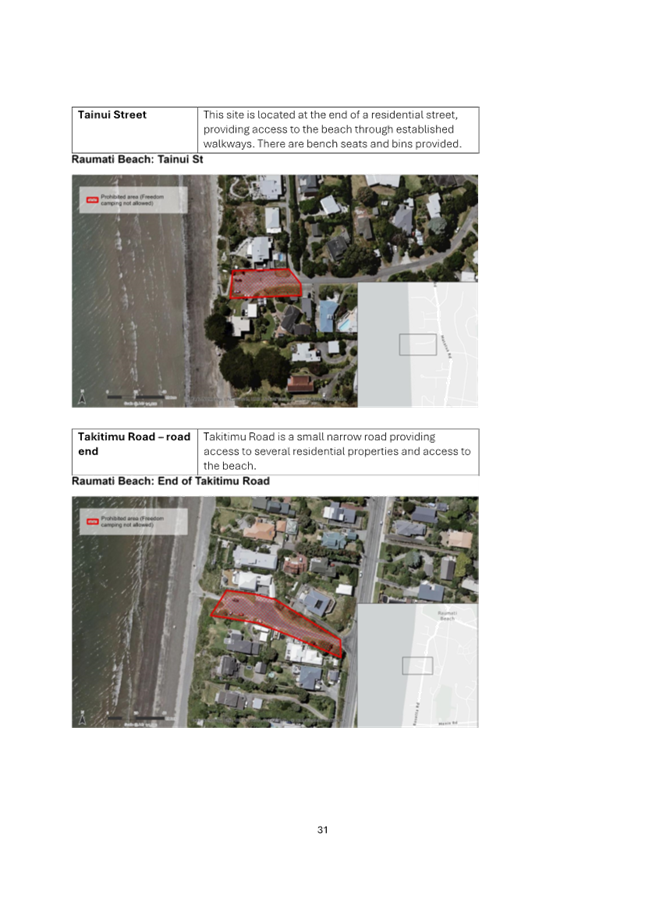
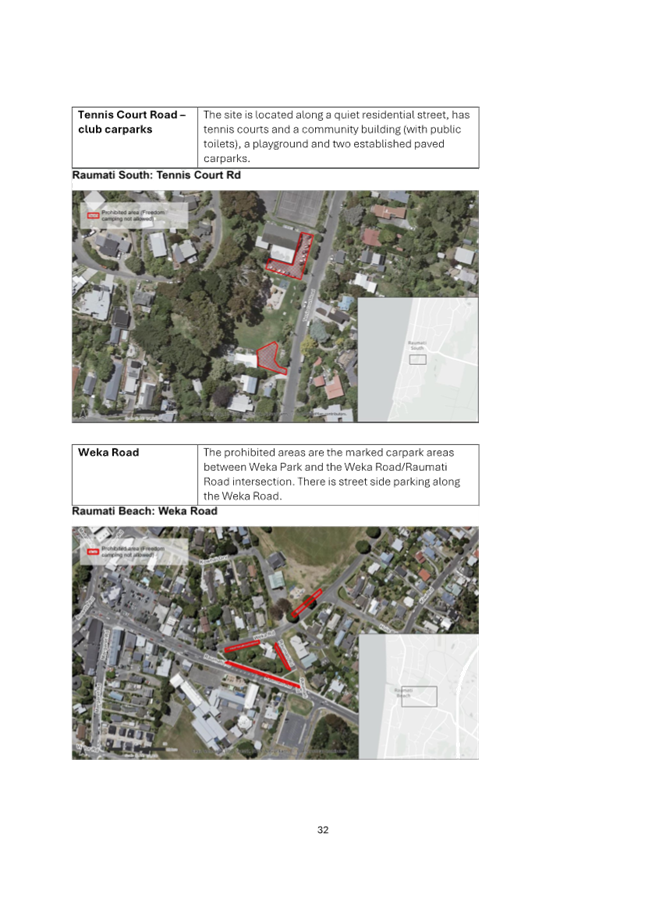
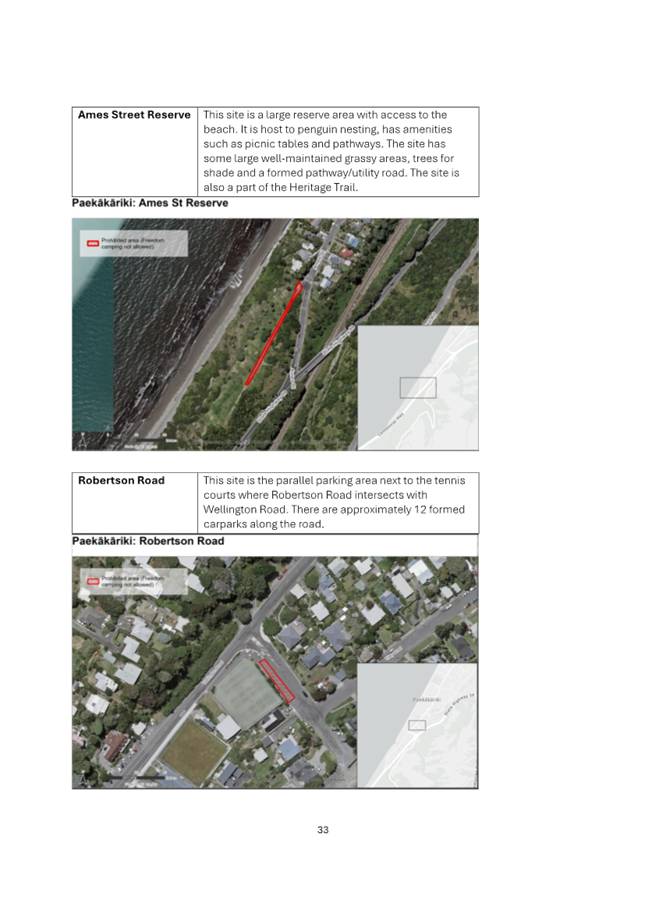
|
Council Meeting Agenda
|
27 March 2025
|
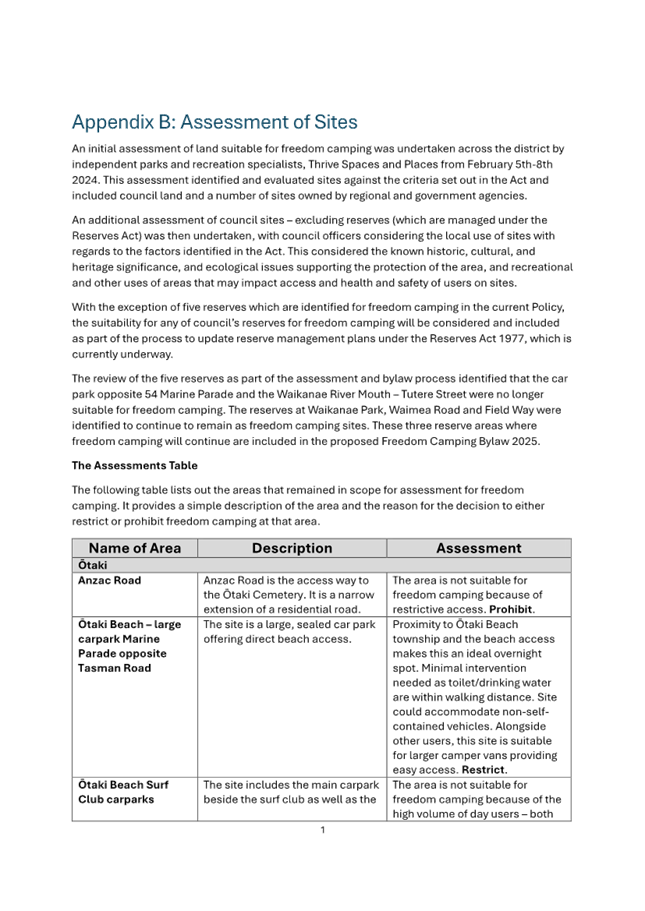
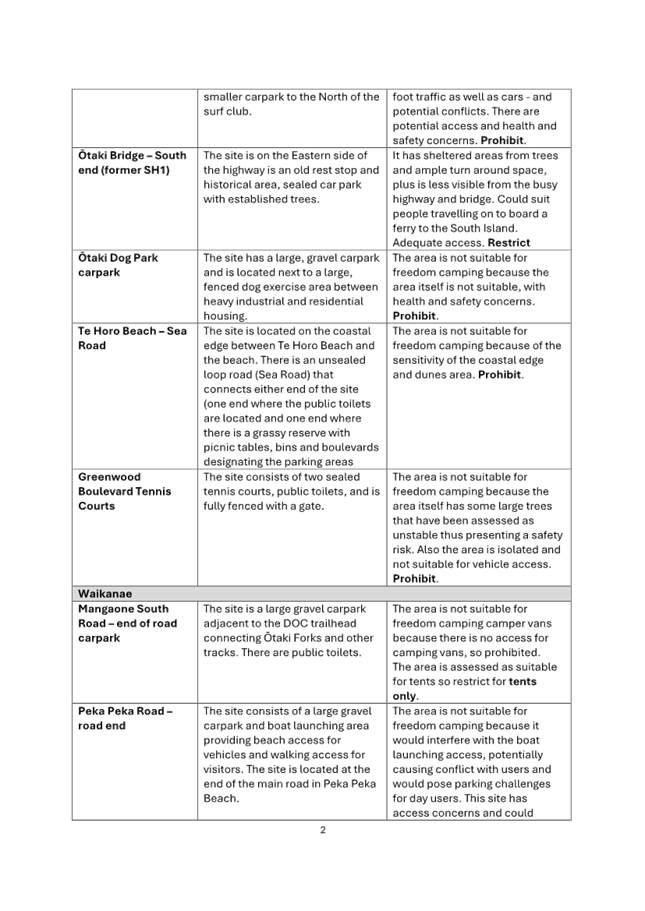
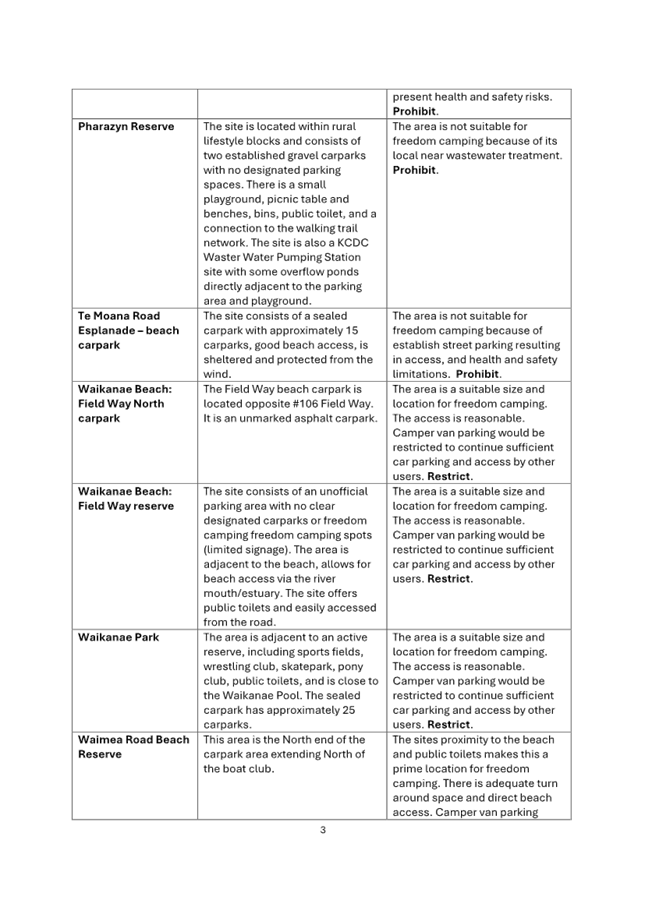
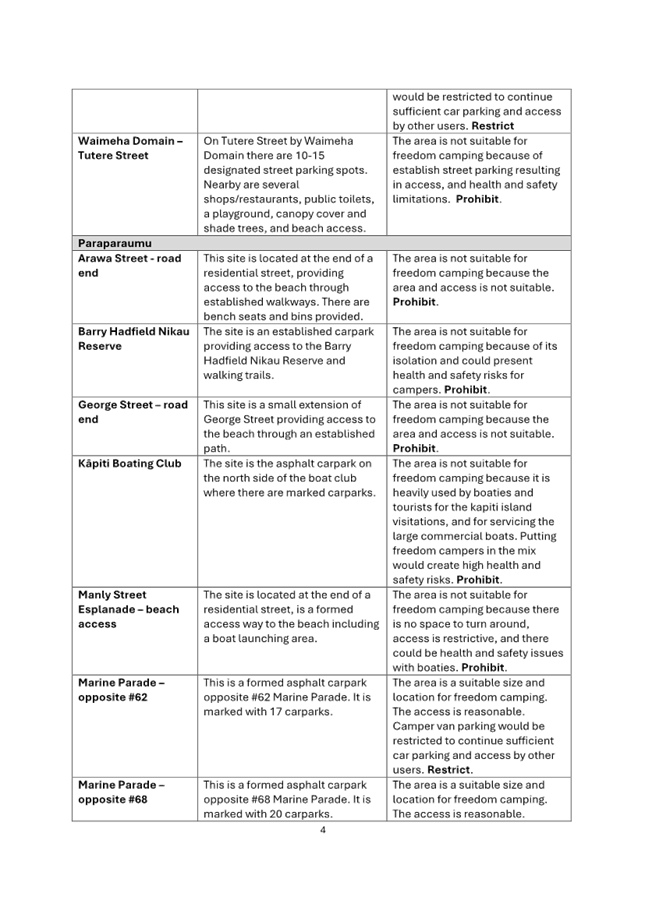
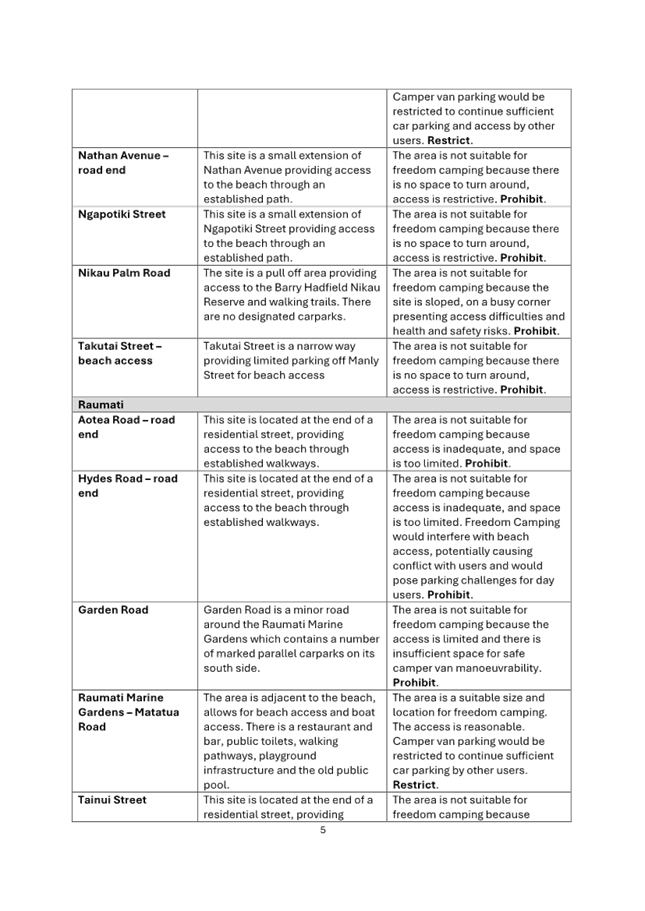
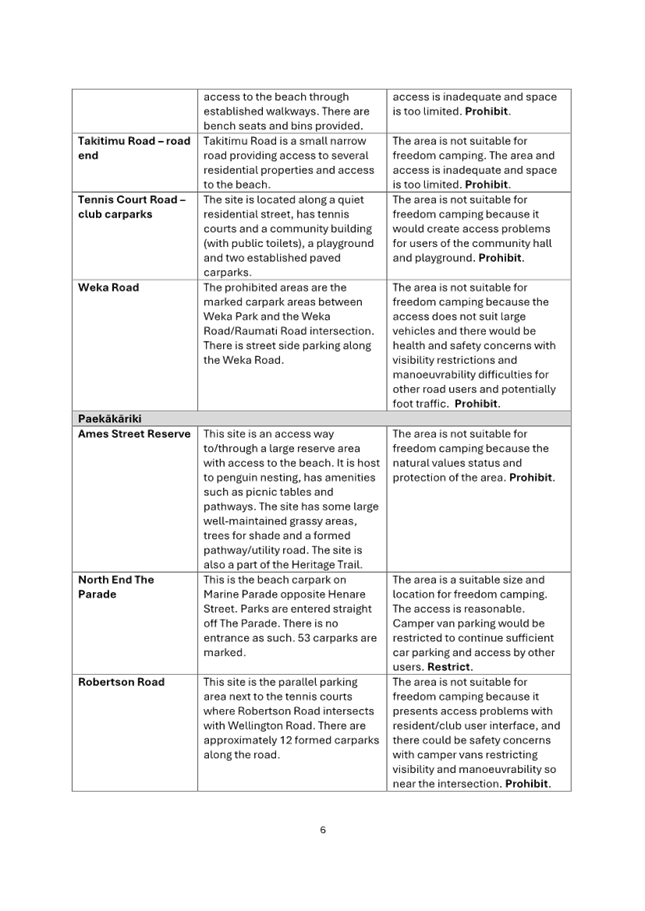
|
Council Meeting Agenda
|
27 March 2025
|
11.3 Adoption of the Policy
Work Programme 2024 - 2027
Kaituhi |
Author: Hamish
McGillivray, Manager Research & Policy
Kaiwhakamana
| Authoriser: Kris Pervan, Group Manager Strategy & Growth
Te pūtake | Purpose
1 This
report presents the Policy Work Programme (PWP) 2024-2027 for Council’s
approval.
He
whakarāpopoto | EXecutive summary
2 An
Executive Summary is not required.
Te tuku
haepapa | Delegation
3 Council
has the authority to adopt to consider this matter under the Governance
Structure and Delegations 2022 – 2025.
Taunakitanga | RECOMMENDATIONS
A. That
Council adopt the Policy Work Programme 2024-2027 as shown in Attachment 1 to
this report.
B. That
the Council note the updates provided on the current projects under the PWP
2024- 2027.
C. That
Council agrees to shifting the Alcohol Licencing Fees Bylaw 2024 Review to be
undertaken as part of work to prepare the next Long-Term Plan in 2027.
Tūāpapa |
Background
4 The
Policy Work Programme (PWP) identifies the development, review and updates of
strategies, policies, bylaws and plans identified for the next three-year period
2024 - 2027. The PWP supports Council managing the development and review of
strategy and policy work to ensure it meets statutory requirements and a fit
for purpose policy framework to achieve community outcomes.
5 The
previous PWP (2021-2024) was adopted by Council on 10 March 2022 and covered
the period from the 1 January 2021 to the end of December 2024. Progress on the
PWP projects is reported to the Strategy, Operation and Finance Committee every
six months. The last update was provided on 16 May 2024.
He
kōrerorero | Discussion
6 The
refreshed PWP 2024-2027 schedule is appended to this report for discussion and
approval (Refer to attachment 1 for details of the projects, and attachment 2
for timeframes). Of note, the refreshed PWP 2024-2027:
6.1 Has
been extended to not only include the policy and strategy work of the Council,
but to extended to also include Annual Plan and Long-Term Plan documents,
District Plan changes, Research and Monitoring projects and several key
delivery Plans.
6.2 Helps
to identify the extent and nature of work planned and underway across
council’s strategic framework; and provides a key mechanism for
understanding, communicating and reporting on the delivery of Council’s
statutory requirements, priorities and community outcomes.
6.3 Outlines
a total of 72 projects across a comprehensive suite of policy, strategy,
bylaws, and district planning projects, including that:
6.3.1 Several
projects will continue on from the previous PWP, with 25 projects already in-track
and currently being worked on.
6.3.2 An
additional 46 projects are scheduled for work during over the next three-years.
7 There
are several changes to projects on the PWP since the last update to the
committee, and some projects that we agreed to provide an update on when we
brought the PWP 2024 – 2027 to the committee for adoption. Those updates
are provided in the issues section below.
Prioritisation of PWP projects
8 In
reviewing the PWP and projects for the next three years, a number of key
criteria have supported prioritisation of projects, year on year, to ensure our
statutory requirements are met. These include:
8.1 Legislative
obligations – including ensuring alignment to the timing of Government
direction or change;
8.2 Alignment
to the Council’s Top 10 Priorities – which are Councillor’s
top priorities for driving affordable, focused strategic change for
Kāpiti;
8.3 LTP
outcomes and deliverables – a number of policies/strategies in the PWP
contribute to meeting the deliverables committed to in the Long-Term Plan
2024-2034
8.4 Challenges
or issues that could increase financial or legal risk for Council – our
suite of LTP policies include a focus on lowering the potential risk to Council
8.5 Community
feedback on needs and priorities – we have heard from a lot of our
community via Vision Kāpiti about the needs and priorities that matter
most to them.
Structure of
the PWP 2024-2027
9 While
the coverage of the PWP 2024-2027 has been broadened, it retains the same
structure and format as the previous version, including:
9.1 Timeframes
for each project. These are indicative of the review and development process.
across the top by year.
9.2 Status
of project (active, scheduled, on-hold);
whether it is a review or new; and statutory deadlines are noted by an
asterisk.
10 Typically, each
project on the PWP will has its own schedule for updating Council and seeking
decisions. However:
10.1 The PWP provides the opportunity
for an overview of the complete work programme.
10.2 Updates on the progress of the PWP
will come to the committee every six months to ensure that there continues to
be oversight of the complete work programme.
He take | Issues
11 As
noted earlier in this paper, several more substantive changes to projects in the
PWP related to either scope, timeframe or policy direction have occurred since
the last update to the committee. Details are as follows:
11.1 Central
Government Reform – Local Water Done well:
11.1.1 Several
areas of work are subject to changes from final decisions of the Local Water
Done Well reform programme and Resource Management reforms, including:
· Decisions relating
to the future model of water services and responsibilities and requirements
under the current Local Government (Water Services) Bill will have a bearing on
the nature of our suite of Long-Term Plan documents. This includes the infrastructure
and funding strategies, but also the suite of three water bylaws being reviewed
or due for review in the next few years.
· The review of the
Water Supply Bylaw 2013 has been caught in the middle of current reforms and
the end date by which the bylaw needs to be reviewed by. Separate advice and
options relating to the review and adoption of the bylaw will be presented and
discussed with Council in April/May 2025.
11.1.2 Advice
on any changes relating to projects on the PWP, including any changes to timing
and priority will be provided as part of regular project or PWP updates once we
have certainty of evolving requirements.
11.2 Alcohol
Licencing Fees Bylaw 2024 Review and Local Alcohol Policy:
11.2.1 The
initial Bylaw introduced fees in 2024. The resolution to adopt the bylaw also
included the option to further review the level of cost recovery ahead of the
next Annual Plan (for example, lifting recovery to 100%).
11.2.2 However,
there is no Annual Plan consultation planned for this year, and the next stage
of increases in fees is due to occur in June 2027.
11.2.3 To
avoid complexity for businesses, we propose to defer this review to enable the
consideration of options alongside the LTP 2027. This will allow us to consult
on increasing the proportion of recoverable fees as part of the Long-Term plan
consultation process. There is a specific recommendation in this report
(Recommendation C) to agree to defer this work to January 2026 to July 2026.
11.2.4 The
Local Alcohol Policy work has paused until the
completion of the Health Strategy and is now scheduled for June 2025 through to
December 2026.
11.3 Resolutions related to Climate Change and
related strategies:
11.3.1 At the Strategy, Operations and Finance
meeting on 5 December 2024, the committee agreed that the Climate Change and
Resilience Strategy be progressed separately, to enable work around mitigation, resilience and
recovery, and adaptation to proceed at differing paces and in line with
legislative requirements. Of note, the strategies will progress in this order:
11.3.2 Climate Change - Mitigation: setting out
direction to achieve our aspirational net zero emissions reduction goal; levers
for change, and focus of work including partnering with others and sharing with
the community how we can all get involved. This will be considered by this
Committee in May 2025.
11.3.3 Climate Change - Resilience and Recovery: setting
out the direction for how we will ‘build back’ from significant
natural disasters or events; outline governance and partnerships needed to
support efforts; levers to ensure our resilience; and the focus of work related
to improving our resilience and preparing for post-disaster recovery. The
development of this strategy will progress through 2025, and be considered for
decision in 2026.
11.3.4 Climate Change – Adaptation: setting out
the direction for adaptation (given national direction); levers we have to
adapt now; and the focus of work needed understand if we can see changes in our
environment that require us to take action. Council will work with communities
to identify the signals, triggers and thresholds for identifying change; and
continue to deliver existing adaptation related work such as sand dunes
planting and seawall management. This work will not proceed until 2026/27.
11.4 Environment
strategies:
11.4.1 This
Committee will receive advice in May 2025, proposing that a similar approach is
taken to progressing the Environment Strategy as is noted in 11.3 for the
Climate Change related strategies.
11.4.2 The
Climate and Environment Committee will consider options in April/May to inform
this direction.
11.4.3 The development of relevant strategies will progress
through 2025, and be considered for decision in 2026. In the interim, the
Environment Dashboard will be developed and stood up for regularly reporting by
the end of this triennium.
11.5 Other
projects with changes of note:
11.5.1 Property
Strategy: this project has been removed from the PWP 2024-2027 and is expected
to be revisited and aligned as a result of the master planning work underway as
part of the Vision Kāpiti work – helping inform the Blueprint in the
2026/2027 timeframe.
11.5.2 The
review of the Coastal Management Strategy 2006 and the Sustainable Water
Management Strategy 2002 have been removed from the PWP 2024-2027. Both
strategies were identified on the previous PWP and remain due for review and
replacement. However, these are older strategies and its anticipated that they
will be incorporated into the scope and development of the new Environment and
Climate Strategies. Further advice on the scope and incorporation of these
strategies will be provided as work on the strategies progresses.
11.5.3 Accessibility
Approach (formerly Strategy): Approaches are a new component of our strategic
architecture and provide a focus on a specific group within our district. The
Age Friendly Approach was the first to be reviewed and aligned to the new
strategic framework and the Accessibility Approach will follow a similar
process.
11.5.4 Māori
Economic Development & Wellbeing Strategy: This project was previously
identified on the previous PWP but has now been removed from PWP 2024-2027 as
it is being aligned with work led by the Economic Development Kotahitanga Board
(Iwi and Council is involved in this work). Updates on this approach will be
provided to Council and resolution sought on the final strategy.
Ngā
kōwhiringa | Options
12 No
additional options have been considered in this paper.
Mana whenua
13 The
development of the PWP 2024-2027 has been informed by Council’s Long-term
Plan 2024-2034 which was guided by the views of our local iwi and hapu partners
Te Rūnganga O Ngāti Toa Rangatira, Ngā Hapū o Ōtaki
and Ātiawa ki Whakarongotai Charitable Trust.
14 The
PWP 2024-2027 provides an overview of projects that will be shared with mana
whenua partners and our Iwi Partnerships Team to support discussions on overall
work and areas of interest and priority.
15 As
the implementation of the PWP is carried out over the next three years,
planning to ensure that individual projects are created in partnership with
mana whenua will be undertaken by individual project managers.
Panonitanga
Āhuarangi me te Taiao | Climate
change and Environment
16 The
decision to adopt the PWP has no direct climate change implications. However,
we do have projects scheduled on the PWP that will determine future work in
relation to the environment and on mitigating, adapting and building resilience
in our approach to climate change. Key projects are the Environment Strategy,
Climate Change: Mitigation Sub-Strategy, Climate Change: Adaption
Sub-Strategy, Climate Change: Resilience and Recovery Sub-Strategy.
Ahumoni me
ngā rawa | Financial and resourcing
17 There
are no immediate financial implications as a result of adopting the PWP.
Budgets necessary for the implementation of PWP projects will be determined as
each of those projects comes to Council for decisions and approval to progress.
18 The
addition of any policy projects onto the PWP will need to consider resource and
budget implications and will be included as a change to the PWP to be agreed by
Council. Typically, this will be managed by projects individually, however the
PWP will remain the overview mechanism for Council and the Strategy, Operations
and Finance Committee to have the oversight across the whole work programme.
Tūraru
ā-Ture me te Whakahaere |
Legal and Organisational Risk
19 The PWP supports the
ongoing management and prioritisation for the review of policies and bylaws to
ensure they are completed within their respective statutory timeframes.
Ngā pānga ki ngā
kaupapa here | Policy impact
20 The adoption of this PWP has a direct positive impact on
Council policies in that it plans for the development and review of priority
policy projects for the next three years. It also provides regular
opportunities for prioritisation of work to ensure alignment to council
priorities and community outcomes.
TE whakawhiti kōrero me te tūhono | Communications & engagement
21 While the PWP itself does
not meet significance levels for consultation under Council’s
Significance and Engagement Policy, the significance for each individual policy
project will likely differ and therefore be assessed as each project progresses,
including the nature and type of any consultation required.
Te mahere tūhono | Engagement planning
22 An engagement plan is not needed to implement this
decision.
Whakatairanga | Publicity
23. A communications plan is not needed to
implement this decision as the PWP is an internal planning and monitoring tool.
Ngā
āpitihanga | Attachments
1. 1. Council
Policy Work Programme 2024-2027 ⇩ 
2. 2. PWP
2024-2027 Tables for Current and Scheduled Projects ⇩ 
|
Council Meeting Agenda
|
27 March 2025
|
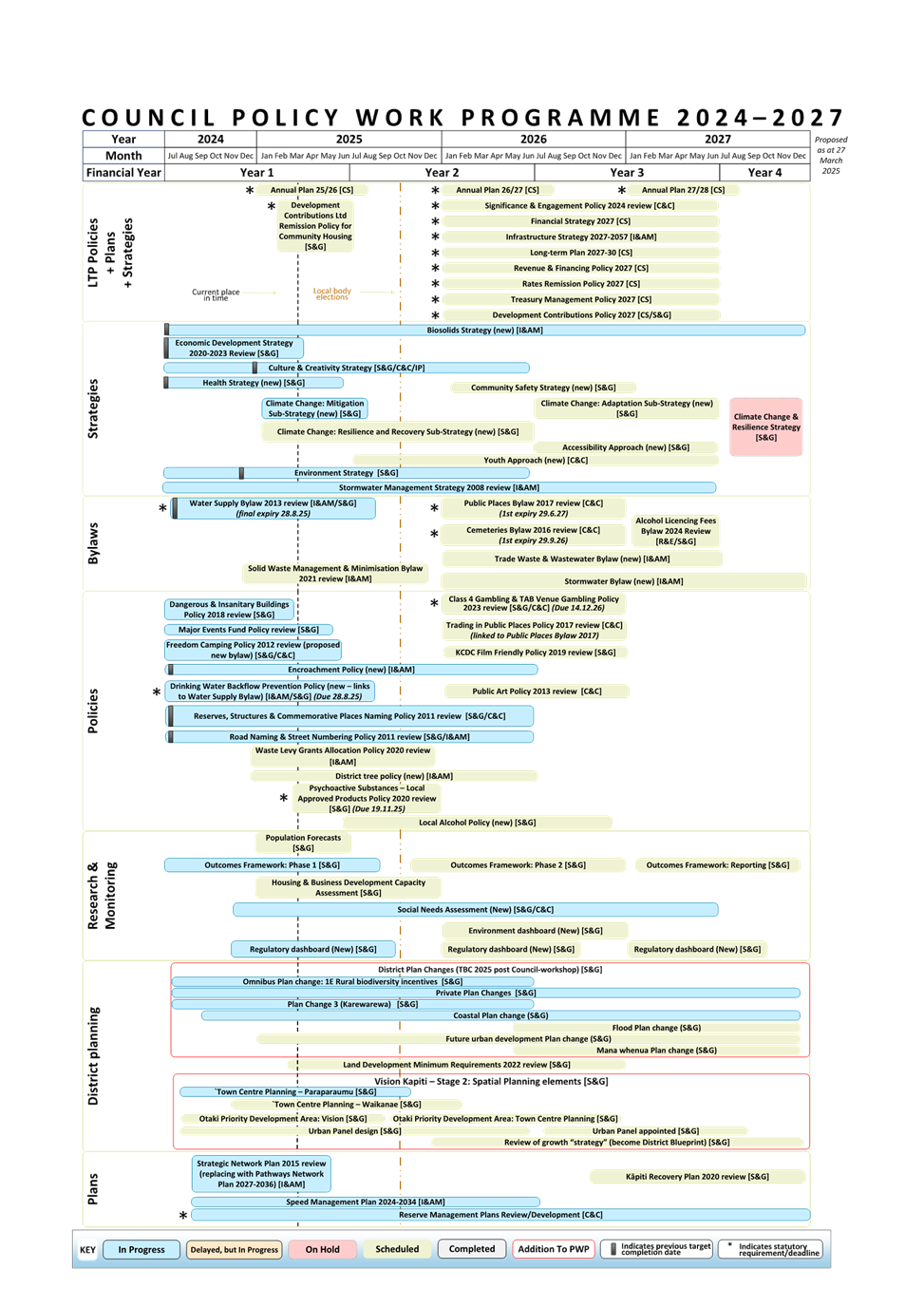
|
Council Meeting Agenda
|
27 March 2025
|
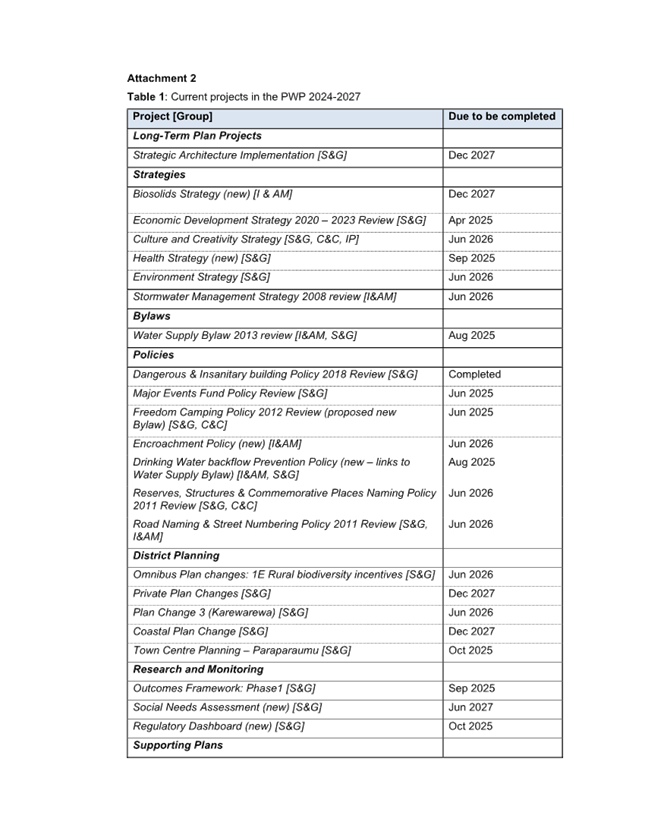
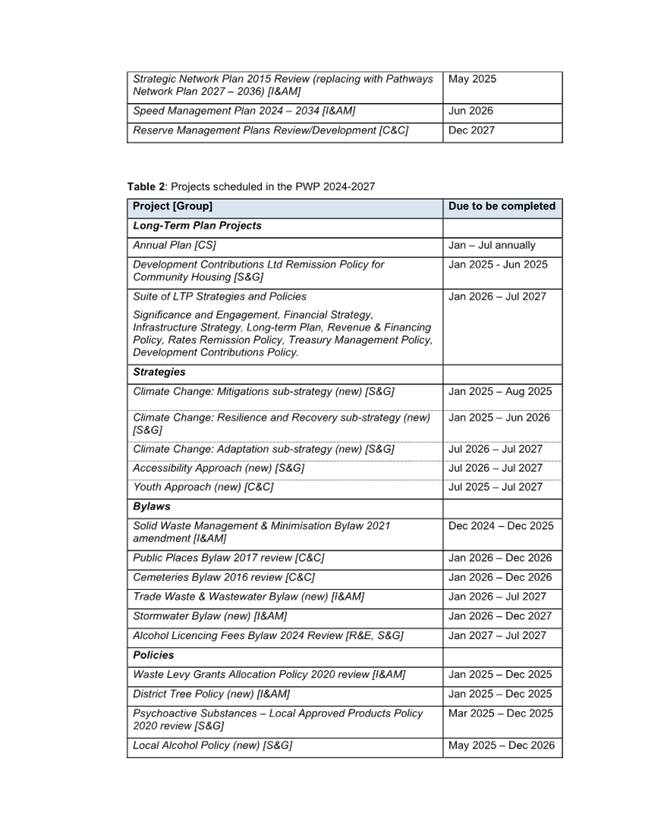
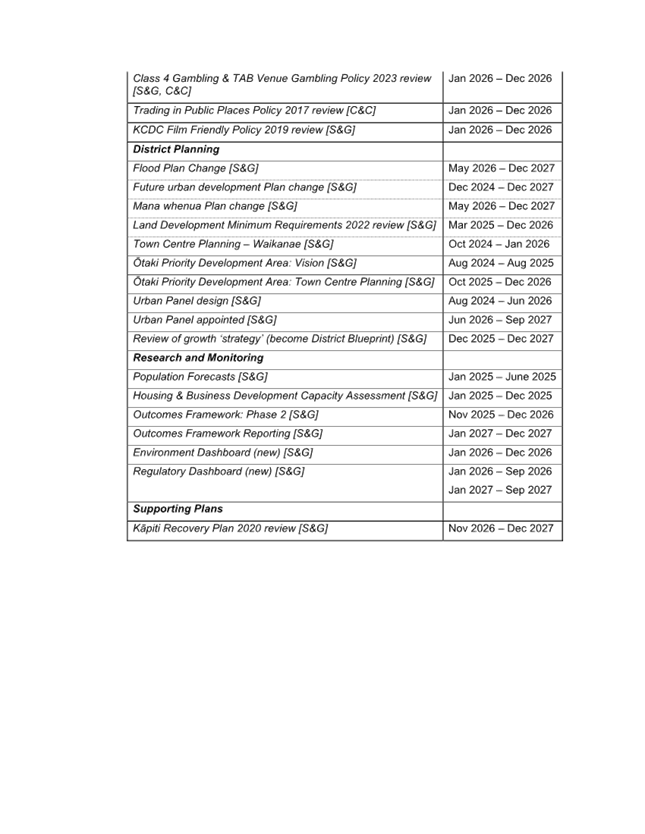
|
Council Meeting Agenda
|
27 March 2025
|
11.4 Order of Candidates'
Names on Voting Documents for the 2025 Local Body Elections
Kaituhi |
Author: Jessica
Mackman, Senior Advisor Governance
Kaiwhakamana
| Authoriser: Mark de Haast, Group Manager Corporate Services
Te pūtake | Purpose
1 This
report asks the Council to resolve the order in which candidates’ names
appear on voting documents for the Kāpiti Coast District Council local
body election to be held on 11 October 2025.
He
whakarāpopoto | EXecutive summary
2 The
Local Electoral Regulations 2001 (the “Regulations’) provide for
the Council to resolve the order in which candidates’ names appear on
voting documents for the 2025 local body election.
3 The
order of candidates’ names on voting documents can be alphabetical by
surname, pseudo-random or random.
4 If
no decision is made, the order of candidates’ names on voting documents
will default to alphabetical order by surname, in accordance with the Regulations.
Te tuku
haepapa | Delegation
5 The
Council has the authority to consider this matter under regulation 31 of the
Local Electoral Regulations 2001.
Taunakitanga | RECOMMENDATIONS
A. That
the Council resolve that the names of candidates for the Kāpiti Coast
District Council local body election on 11 October 2025 are to be listed on the
voting documents in:
A.1 alphabetical
order by surname or
A.2 pseudo-random
order or
A.3 random order
as permitted under regulation 31
of the Local Electoral Regulations 2001.
Tūāpapa |
Background
6 The
Kāpiti Coast District Council local body election will be held on Saturday
11 October 2025 by postal vote using the STV (single transferable vote)
electoral system.
7 Regulation
31 of the Local Electoral Regulations 2001 (the “Regulations’) provides
for the Council to resolve the order in which candidates’ names appear on
the voting documents for this election.
8 The
order of candidates’ names on voting documents can be alphabetical by
surname, pseudo-random or random, as described below:
8.1 Alphabetical
Order by Surname
8.1.1 Alphabetical
order is simply listing candidates’ surnames alphabetically and is the
order traditionally used in local and Parliamentary elections.
8.1.1 If
this option is selected, the candidate names for each issue (for example, the
Mayoralty, each ward and community board) will be listed alphabetically by
surname.
8.1.2 Each
combination of voting document will look the same for every voter.
8.1.3 This
is the default option under the Regulations. If the Council does not make a
decision, then under clause 31(3) of the Regulations, candidate names will be
listed in alphabetical order by surname.
8.2 Pseudo-Random
Order
8.2.1 Pseudo-random
order is where candidates’ surnames for each issue (for example, the
Mayoralty, each ward and community board) are randomly selected, and listed on
all voting documents in the order in which they are drawn. The names are
randomly selected by a method such as drawing names out of a container.
8.2.2 Each
combination of voting document will look the same for every voter.
8.2.3 If pseudo-random order is
selected, the Electoral Officer must state in a public notice the date, time,
and place at which the order of the candidates’ names will be drawn, and
any person is entitled to attend (section 65 of the
Local Electoral Act 2001).
8.3 Random
Order
8.3.1 Random
order is where all candidates’ surnames are randomly selected and are
listed in a different order on every voting document.
8.3.2 Random
order enables names to be listed in a completely unique order on each voting
document and is achieved by using software which is specifically designed for
this purpose.
8.3.3 Each
combination of voting document will look different for every voter.
9 The
Council resolved to adopt the random order of candidates’ names on voting
documents for the 2019 and 2022 local body election.
10 In
line with the Regulations, councils are required to resolve the order of
candidates’ names on voting documents ahead of each triennial election
and a decision does not determine the order of candidates’ names for
future elections.
He
kōrerorero | Discussion
He take | Issues
What is
on the voting documents?
11 For
the 2025 local body election, voting documents for the Kāpiti Coast
District will contain:
· Election
for the Kāpiti Coast District Council Mayor, councillors (Districtwide,
General Ward and Māori Ward) and community board members;
· Election
for the Greater Wellington Regional Council members for the Kāpiti Coast
General Constituency and the Te Upoko o te Ika a Māui Māori Constituency;
· A
Kāpiti Coast Māori Ward Poll;
and
· A
Te Upoko o te Ika a Māui Māori Constituency (Greater Wellington
Māori Constituency) Poll.
12 Voting
documents are accompanied by a candidate directory which contains the profile
statements of all candidates listed in alphabetical order. If the Council
decide to list candidates’ names on voting documents by pseudo random or
random order, the order of candidates’ names will differ from the
directory.
13 Although
the candidates for both the regional council and the territorial authority
elections appear on the same voting documents, regional councils and
territorial authorities resolve the order of their candidates’ names on
voting documents separately. Greater Wellington Regional Council resolved the
order in which their candidates’ names are listed on the voting documents
on 27 February 2025 and decided to arrange the names in random order. If the
Council resolved to use a different order, the order of names for each election
would therefore differ even though they are on the same voting document.
Are there any additional costs for any of the
options?
14 While
the cost of printing and distributing the voting documents is the same for all
three options, the Council would have to meet some minor additional costs if
the pseudo-random option was chosen as the Electoral Officer will be required
to publicly notify a date, time and place to draw the order of
candidates’ names. The booking of a suitable venue and reimbursing travel
for the Electoral Officer for this would incur minor additional costs.
Ngā
kōwhiringa | Options
15 The
options for the order of candidates’ names on voting documents are as
follows:
· Alphabetical
Order by Surname.
· Pseudo-Random
Order.
· Random
Order.
16 The
benefits and risks associated with each option are outlined below.
Alphabetical
Order by Surname
· The
majority of voters will be familiar with names being listed alphabetically from
Parliamentary elections.
· Voters
may find it easier to locate the names of the candidates for whom they wish to
vote.
· The
order of candidate names on the voting document matches the order listed in the
candidate directory (candidate profile statements).
· It
has been suggested that alphabetical order may favour candidates with a surname
in the first part of the alphabet as they will be listed toward the top of the
voting documents whereas candidates with a surname in the latter part of the
alphabet will be listed toward the bottom.
Pseudo-Random Order
· The
candidates’ names appear in the same mixed order (not alphabetical) on
the voting document.
· Pseudo-random
order provides for candidates to have equal opportunity to be at the top of the
voting document. However, some candidates will be listed at the bottom of every
voting document.
· Specific
candidate names may not be easily found, particularly where there may be many
candidates which may lead to voter criticism or confusion.
· The
order of candidate names on the voting document does not match the order listed
in the candidate directory (candidate profile statements).
Random Order
· The
candidates’ names appear in mixed order (not alphabetical) on the voting
document and each candidate has an equal opportunity to be at the top, middle
or bottom of each voting document.
· Random
order could be considered to be the fairest option for all candidates.
· Kāpiti
Coast District Council has used random order for the 2019 and 2022 local body
elections and voters are likely to be familiar with this approach.
· Specific
candidate names may not be easily found, particularly where there may be many
candidates which may lead to voter criticism or confusion.
· The
order of candidate names on the voting document does not match the order listed
in the candidate directory (candidate profile statements).
17 If
no decision is made, the order of candidates’ names on voting documents
will default to alphabetical order by surname, in accordance with regulation
31(3) of the Regulations.
Mana whenua
18 There
has been no engagement with mana whenua regarding this report.
Panonitanga
Āhuarangi me te Taiao | Climate
change and Environment
19
There are no climate change and environmental impacts arising from this
decision.
Ahumoni me
ngā rawa | Financial and resourcing
20 The
cost of the election has been budgeted through the Long-term Plan 2024-2034.
While the cost of printing and distributing the voting documents is the same
for all three options, Council would have to meet some minor additional
administration costs if the pseudo-random option was chosen as the Electoral
Officer will be required to publicly notify a date, time and place to draw the
order of candidates’ names. The booking of a suitable venue for this
would incur minor additional costs.
Tūraru
ā-Ture me te Whakahaere |
Legal and Organisational Risk
21 There
are no further legal or risk considerations within this report.
Ngā pānga ki ngā
kaupapa here | Policy impact
22 This
decision does not impact current or future Council policies. This decision does
also not determine the order of candidate names for future elections. Council
will be required to reconsider this matter anew ahead of the 2028 local body
elections.
TE whakawhiti kōrero me te tūhono | Communications & engagement
Te mahere tūhono | Engagement planning
23 This
matter has a low level of significance under Council’s Significance and
Engagement Policy and no community engagement on the order of candidates’
names has taken place.
Whakatairanga | Publicity
24 The
order in which candidates’ names will be arranged on voting documents
will be communicated to the public as part of communication activities for the
2025 local body elections and the public release of the minutes of this Council
meeting.
25 If
Council resolve to use the pseudo-random order for the order of candidates’
names on voting documents, the Electoral Officer will be required to issue a
public notice containing the date, time, and place at which the order of the
candidates’ names will be drawn, and any person is entitled to attend (in line with section 65 of the Local Electoral Act 2001). This notice, if required, will also be
communicated through Council’s regular channels.
Ngā
āpitihanga | Attachments
Nil
|
Council Meeting Agenda
|
27 March 2025
|
11.5 Reports and Recommendations from Community Boards
Kaituhi |
Author: Maria
Cameron, Advisor Governance
Kaiwhakamana
| Authoriser: Mark de Haast, Group Manager Corporate Services
Te pūtake | Purpose
1 This
report presents items considered and recommendations made to Council by
community boards between 1 December 2024 and 12 March 2025.
He
whakarāpopoto | EXecutive summary
2 There
were no recommendations made to Council during this period.
Te tuku
haepapa | Delegation
3 In
line with Council’s Governance Structure and Delegations 2022-2025, Council
has the authority to consider recommendations made by community boards and
provide direction to Council officers to action these recommendations.
Taunakitanga | RECOMMENDATIONS
A. That Council receives
this report.
Tūāpapa |
Background
4 During
the period of 1 December 2024 to 12 March 2025, the following community board
meetings took place:
|
Paekākāriki Community
Board
|
Tuesday, 10 December 2024
|
|
Paraparaumu Community Board
|
Tuesday, 11 February 2025
|
|
Paekākāriki Community
Board
|
Tuesday, 18 February 2025
|
|
Raumati Community Board
|
Tuesday, 25 February 2025
|
|
Waikanae Community Board
|
Tuesday, 4 March 2025
|
|
Ōtaki Community Board
|
Tuesday, 11 March 2025
|
5 The
following items were discussed at each of the meetings:
5.1 On
Tuesday, 10 December 2024 the Paekākāriki Community
Board met to discuss:
· Update: Emergency Management Update
– The Community Approach
· Report: Draft calendar of meetings 2025
· Consideration of Applications for Funding
· Matters Under Action
5.2 On
Tuesday, 11 February 2025 the Paraparaumu Community
Board met to discuss:
· Deputation: Kāpiti Health
Advisory Group - Case for a polyclinic
· Deputation: Summerset Group Holdings Limited plan change
request
· Update: Beach Accessways and Storytelling at MacLean Park
· Consideration of Applications for Funding
· Matters Under Action
5.3 On Tuesday,
18 February 2025 the Paekākāriki Community Board met to discuss:
· Deputation: Kāpiti Health
Advisory Group - Case for a polyclinic
· Consideration of Applications for Funding
· Matters Under Action
5.4 On Tuesday,
25 February 2025 the Raumati Community Board met to discuss:
· Deputation: Kāpiti Health
Advisory Group - Case for a polyclinic
· Report: Establishment of Vision Raumati Grants Fund
· Consideration of Applications for Funding
· Matters Under Action
5.5 On Tuesday, 4
March 2025 the Waikanae Community Board met to discuss:
· Briefing
from New Zealand Police regarding street racing incident
· Deputation:
Kāpiti Health Advisory Group - Case for a
polyclinic
· Update: Waikanae Town Centre Plan
· Update:
Update on the Omnibus Reserve Management Plan
· Consideration
of Applications for Funding
· Matters
Under Action
5.6 On Tuesday,
11 March 2025 the Ōtaki Community Board met to discuss:
· Update:
Update on the Omnibus Reserve Management Plan
· Update:
Ōtaki Town Centre Planning
· Report: Road Naming - 83 Riverbank Road, Ōtaki
· Consideration
of Applications for Funding
· Matters Under Action
He
kōrerorero | Discussion
He take |
Issues
6 Within
the reports and recommendations considered by community boards between 1
December 2024 and 12 March 2025 there were no recommendations made to
Council from the meetings.
Ngā
kōwhiringa | Options
7 No
further options are provided in this report.
Mana whenua
8 Mana
whenua have not been consulted in relation to this report.
Panonitanga āhuarangi | Climate change and
Environment
9 There
are no direct climate change and environment considerations in relation to this
report.
Ahumoni me
ngā rawa | Financial and resourcing
10 There
are no direct financial and resourcing considerations relevant to this
report.
Ture me
ngā Tūraru | Legal and risk
11 There
are no direct legal or risk considerations relevant to this report.
Ngā pānga ki ngā
kaupapa here | Policy impact
12 There
are no direct policy impacts relevant to this report.
TE whakawhiti kōrero me te tūhono | Communications & engagement
Te mahere tūhono | Engagement planning
13 An engagement plan is not
required for this report.
Whakatairanga | Publicity
14 The
decision made in this report will be publicly available through Council’s
standard communications channel.
Ngā
āpitihanga | Attachments
Nil
|
Council Meeting Agenda
|
27 March 2025
|
11.6 Amendments to Council
Delegations to Staff
Kaituhi |
Author: Sarah
Wattie, General Counsel
Kaiwhakamana
| Authoriser: Mark de Haast, Group Manager Corporate Services
Te pūtake | Purpose
1 This
report seeks Council’s consideration and approval of amendments to
Council delegations to Staff, including changes to the Resource Management Act
1991 delegations.
He
whakarāpopoto | EXecutive summary
2 An
executive summary is not required.
Te tuku
haepapa | Delegation
3 Council has the authority to consider this matter. Clause
32, Schedule 7 of the Local Government Act 2002 empowers the Council to
delegate its responsibilities, duties and powers in accordance with the
restrictions set out in this provision.
Taunakitanga | RECOMMENDATIONS
A. That
Council Adopts the amended sections in ‘Council Delegations to
Chief Executive and Staff’ as shown in Attachment 1 to the report,
‘Amendments to relevant sections of Council Delegations to Chief
Executive and Staff’.
B. That
Council Adopts the amended Resource Management Act 1991 delegations to
staff as shown in Attachment 2 to the report ,‘Amendments to Council
to Staff RMA Delegations’.
Tūāpapa |
Background
4 The
purpose of local government under clause 10(1) of the Local Government Act 2002
is to enable democratic local decision-making and action by, and on behalf of,
communities; and to promote the social, economic, environmental, and cultural
well-being of communities in the present and for the future. Legislative
compliance with central Government’s legislative and regulatory programme
supports Council to do this in a fair and efficient manner.
5 Council
has a range of legislative functions, duties and powers. It is not always
efficient or practical for elected members to carry out all of these functions,
duties and powers, which is reflected in various statutes that provide Council
with the legal authority to delegate to Council staff. Delegated authority
allows for administrative efficiency and ensures timeliness in the conduct of
Council’s daily business.
6 In
particular, Council has the authority to delegate to officers under clause 32
of Schedule 7 of the Local Government Act 2002. Clause 32 of the Local
Government Act 2002 also sets out certain powers that cannot be
delegated as follows:
“32.
Delegations‒ (1) Unless expressly provided otherwise in this Act, or in
any other Act, for the purposes of efficiency and effectiveness in the conduct
of a local authority's business, a local authority may delegate to a committee
or other subordinate decision-making body, community board, or member or
officer of the local authority any of its responsibilities, duties, or powers
except‒
(a) the
power to make a rate; or
(b) the
power to make a bylaw; or
(c) the
power to borrow money, or purchase or dispose of assets, other than in
accordance with the long-term plan; or
(d) the
power to adopt a long-term plan, annual plan, or annual report; or
(e) the
power to appoint a chief executive; or
(f) the power to
adopt policies required to be adopted and consulted on under this Act in
association with the long-term plan or developed for the purpose of the local
governance statement.
(g the power to adopt a remuneration and
employment policy.”
7 Most
legislation provides the Chief Executive with the discretion to sub-delegate to
Council staff. However, some Acts prescribe the way delegations must be made. For
example, section 34A of the Resource Management Act 1991 (RMA) provides local
authorities with the power to delegate to an employee any functions, powers, or
duties under these Acts however, they prohibit the power to sub-delegate and
therefore these delegations must be approved by Council.
8 The
Council’s delegations to Chief Executive and staff are monitored on a
regular basis and reported back to Council for amendment as required, in
response to changes in either staff or legislation.
He
kōrerorero | Discussion
9 This
report proposes amendments to Council delegations to the Chief Executive and
Staff and Resource Management Act 1991 delegations to give effect to
recommendations from staff.
He take | Issues
Council to Chief Executive
Delegations
10 The following amendments to Council Delegations to Chief Executive to Staff are highlighted in Attachment 1.
Water Services Act 2021
11 Staff require delegations under the Water Services Act 2021
to carry out functions and responsibilities under the Act as a drinking water supplier,
a stormwater network operator and a wastewater network operator
and monitor compliance as a local authority.
Fast-track Approvals Act 2024
12 Staff require delegation under the Fast-track
Approvals Act 2024 to carry out functions and responsibilities under the Act
and in order to submit, provide advice and information and recover actual and
reasonable costs under the Act in relation the fast-track consent applications.
Resource Management Act 1991
(RMA) Delegations
13 Amendments are required to Council’s delegations to
staff under the RMA relating to changes in
roles, titles or specific delegations as clarified in the table below and
highlighted in detail in Council to Staff
RMA Delegations in Attachment 2.
|
Recommended amendments to Council delegations to staff
under
the Resource Management Act 1991
|
|
Advisor Biosecurity
|
New position in
Parks, Open Space and Environment team.
|
|
Consultant Policy Planner
|
Title is for
independent planning consultants to assist with District Plan.
|
|
Group Manager Strategy and
Growth
|
Position requires
delegations for determining whether to become a party and taking all other
steps under section 274 and in relation to being a party.
|
|
Manager Property Assets
|
Additional title in
the Property team.
|
|
Officer Property Leasing and
Contracts
|
Additional title in
the Property team.
|
|
Property and Facilities
Services Officer
|
Change in title
Property and Parks Officer.
|
|
General Counsel, Manager Legal
Compliance and Complaints, Senior Advisor Legal Compliance and Complaints, Advisor Legal
Compliance and Complaints
|
Extending delegation
of section 38(5) relating to issuing warrants to include all of section 38
to cover compliance with the full section for issuing warrants.
|
14 The above amendments are effective immediately, noting that
titles and their associated delegations that are listed as amended or replaced
will stay in effect until contracts have been signed for the amended or
replacement positions.
Ngā
kōwhiringa | Options
15 The
proposed options are set in paragraphs 10 through 15
of this paper.
Mana whenua
16 Where
responsibilities and powers are delegated to staff, staff will be required to
seek early input from Council’s Iwi Partnerships Group on matters that
are likely to impact on mana whenua or mana whenua interests. What is
appropriate in view of Council’s partnership with mana whenua and
legislative provisions will depend on the nature of the delegated
responsibility, duty or power. This report does not have direct implications on
Council’s partnership with mana whenua.
Panonitanga
Āhuarangi me te Taiao | Climate
change and Environment
17 There
are no climate change considerations triggered by this report.
Ahumoni me
ngā rawa | Financial and resourcing
18 There
is no direct financial impact from these changes to delegations.
Tūraru
ā-Ture me te Whakahaere |
Legal and Organisational Risk
19 This
paper has been reviewed by the Council’s General Counsel.
20 The
exercise of powers and functions by staff must adhere to legislative
requirements. Managers are responsible for ensuring legislative compliance in
the exercise of statutory powers in their area and are able to seek legal
advice where required.
Ngā pānga ki ngā
kaupapa here | Policy impact
21 Appropriate
delegations facilitate efficiency and effectiveness in the conduct of Council
business and assist staff to deliver on Council outcomes.
TE whakawhiti kōrero me te tūhono | Communications & engagement
22 This
decision has a low level of significance under the Council’s Significance
and Engagement policy.
Te mahere tūhono | Engagement planning
23 No
consultation or engagement is required relating to the process of making these
amendments.
Whakatairanga | Publicity
24 No
publicity is required for these minor amendments.
Ngā
āpitihanga | Attachments
1. Amendments
to relevant sections of Council Delegations to Chief Executive and Staff’
⇩ 
2. Amendments
to Council to Staff RMA Delegations ⇩ 
|
Council Meeting Agenda
|
27 March 2025
|
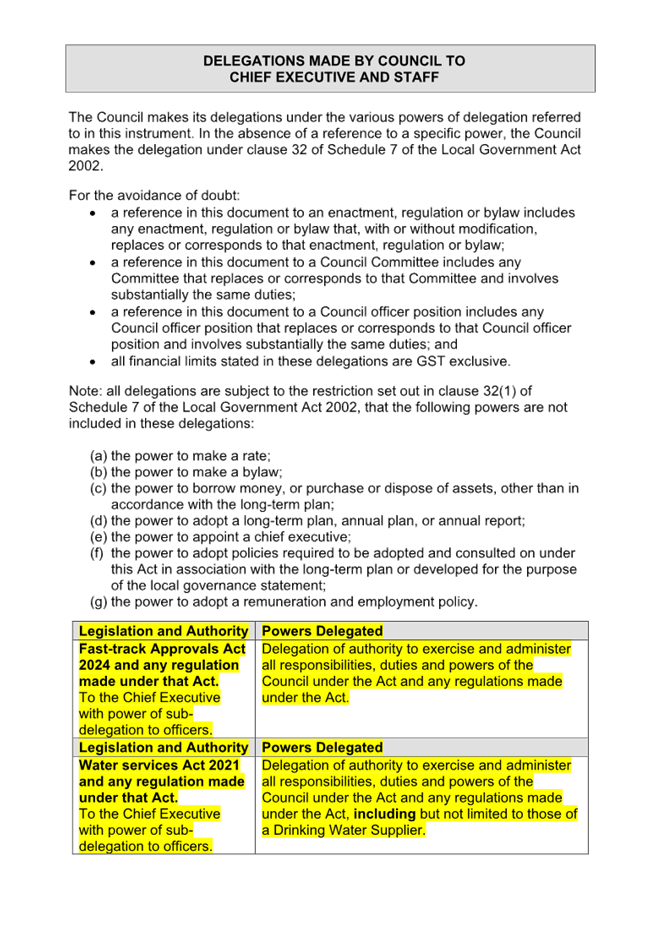
|
Council Meeting Agenda
|
27 March 2025
|
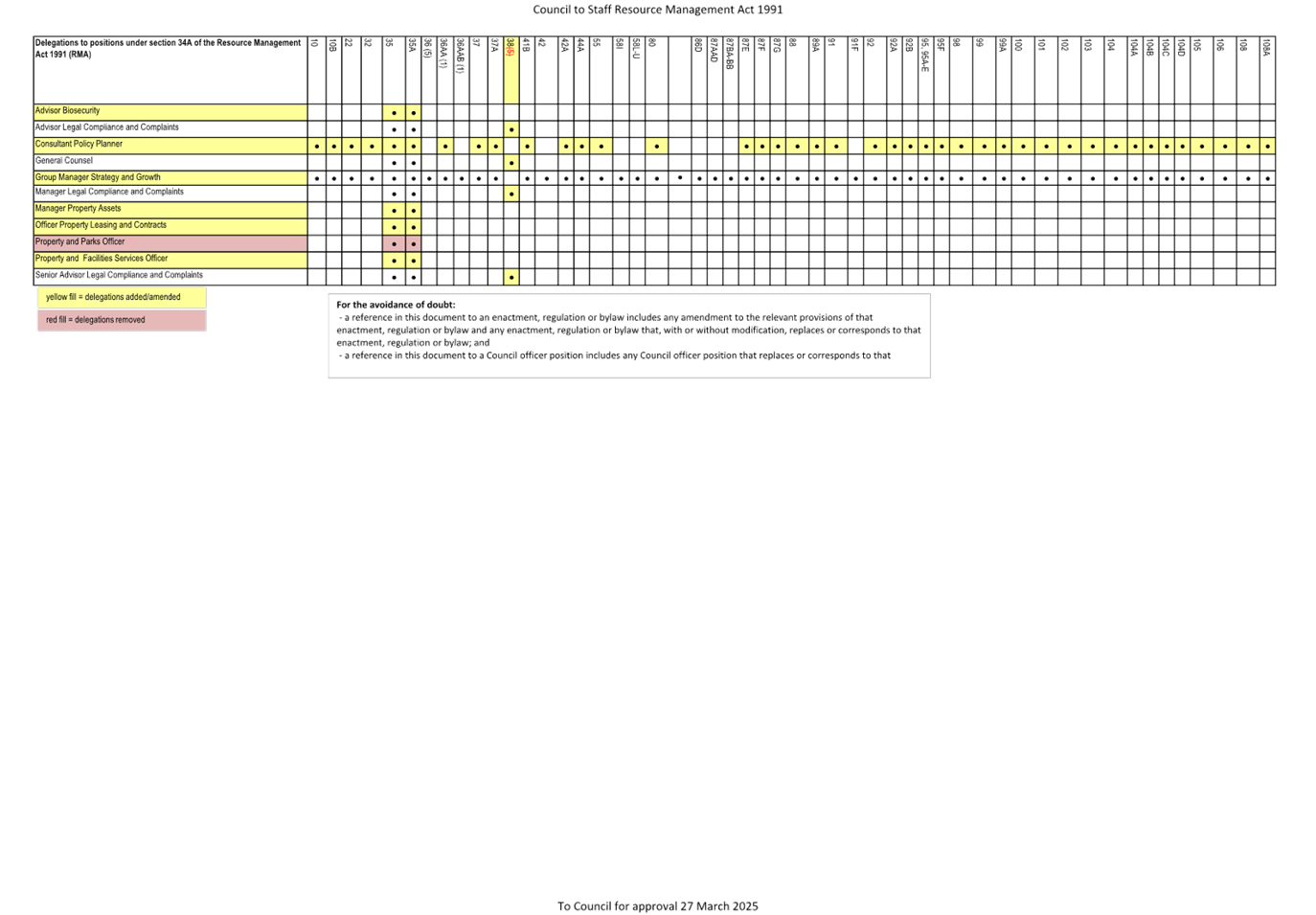
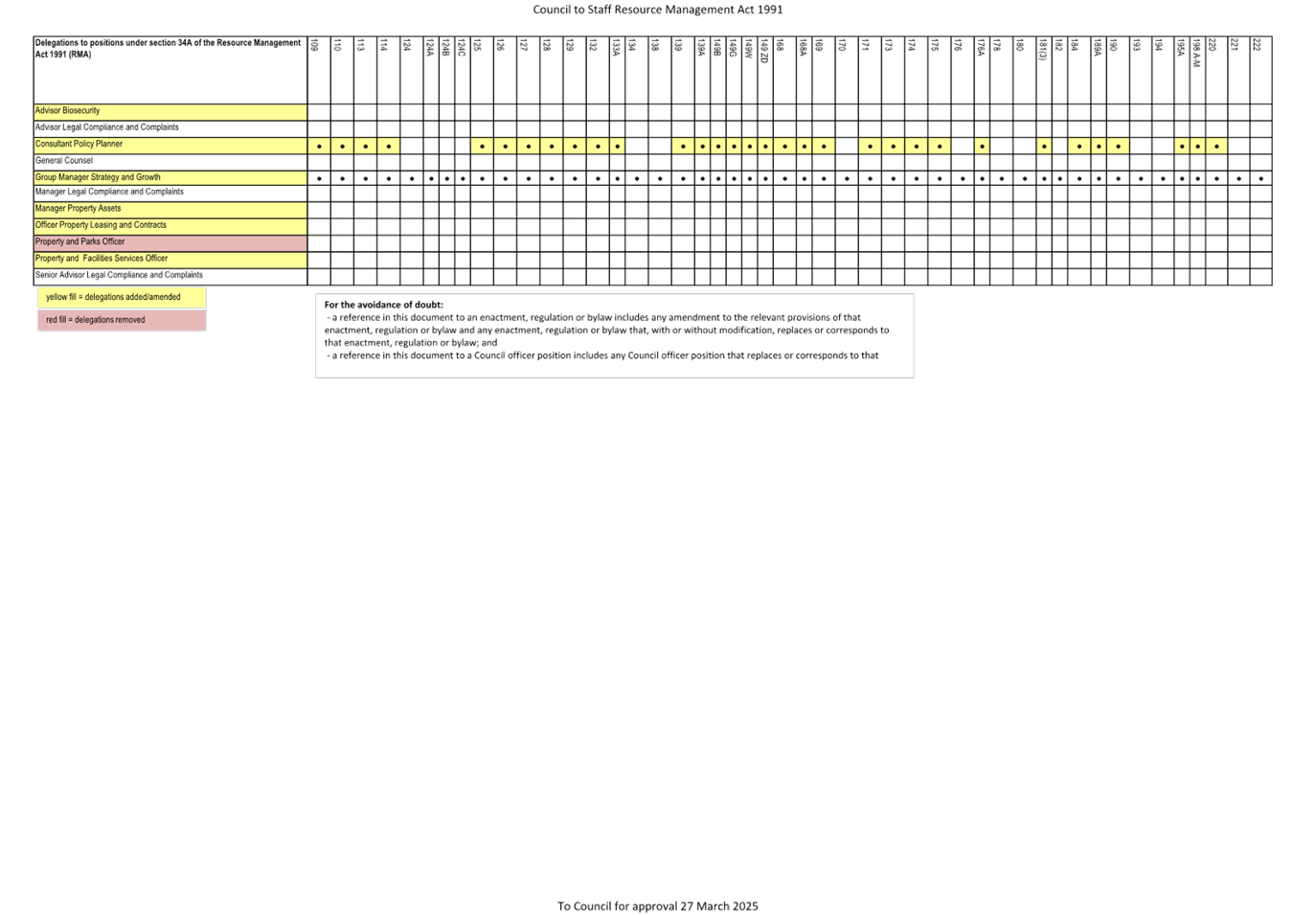
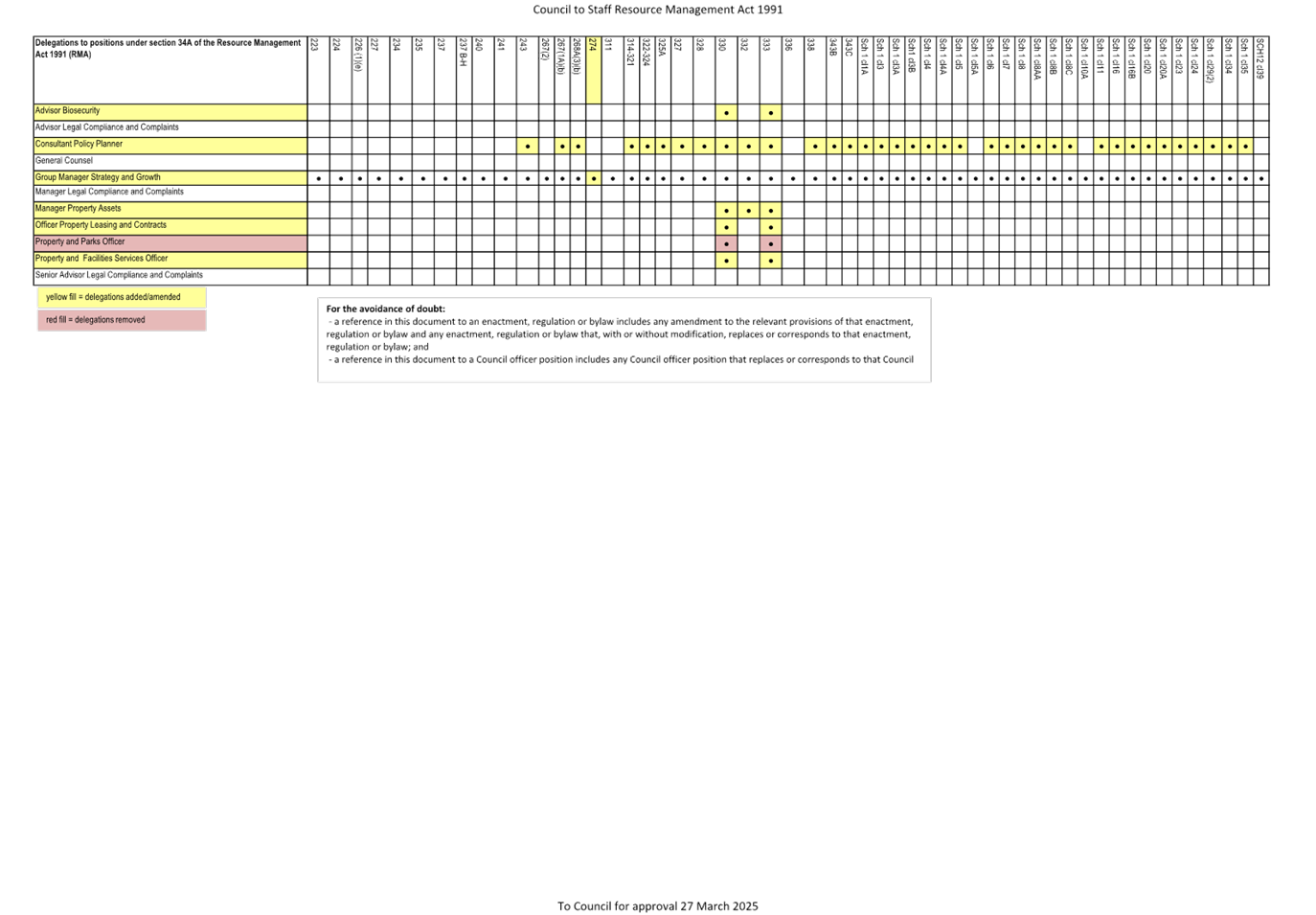

|
Council Meeting Agenda
|
27 March 2025
|
12 Te
Whakaū i ngā Āmiki | Confirmation of Minutes
12.1 Confirmation
of Minutes
Author: Maria
Cameron, Advisor Governance
Authoriser: Darren
Edwards, Chief Executive
|
Taunakitanga | Recommendations
That the minutes of the
Council meeting of 6 March 2025 be accepted as a true and correct record.
|
Ngā
āpitihanga | Attachments
1. Unconfirmed
Minutes of the 6 March 2025 Council Meeting ⇩ 
|
Council Meeting Agenda
|
27 March 2025
|
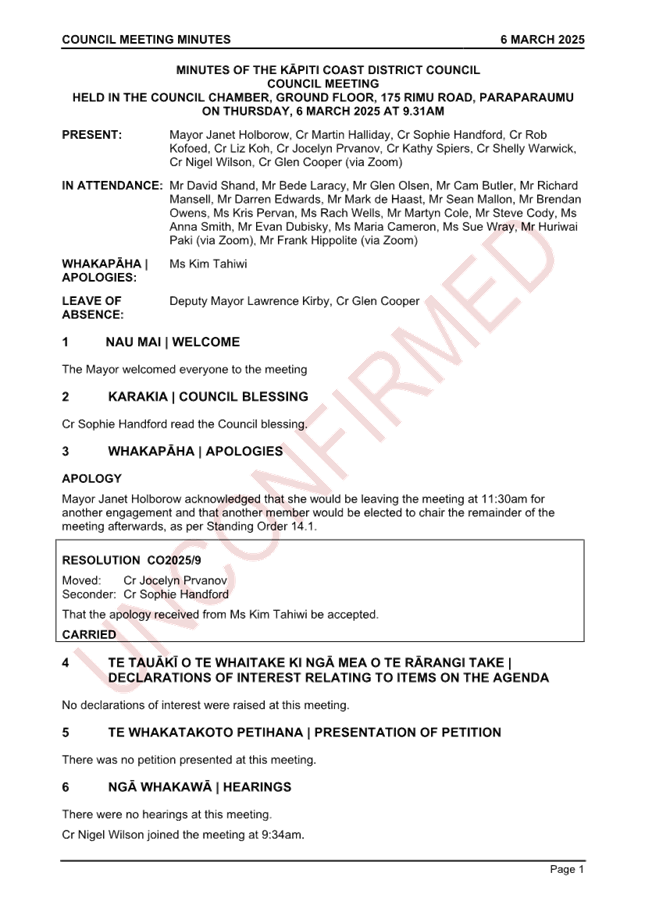
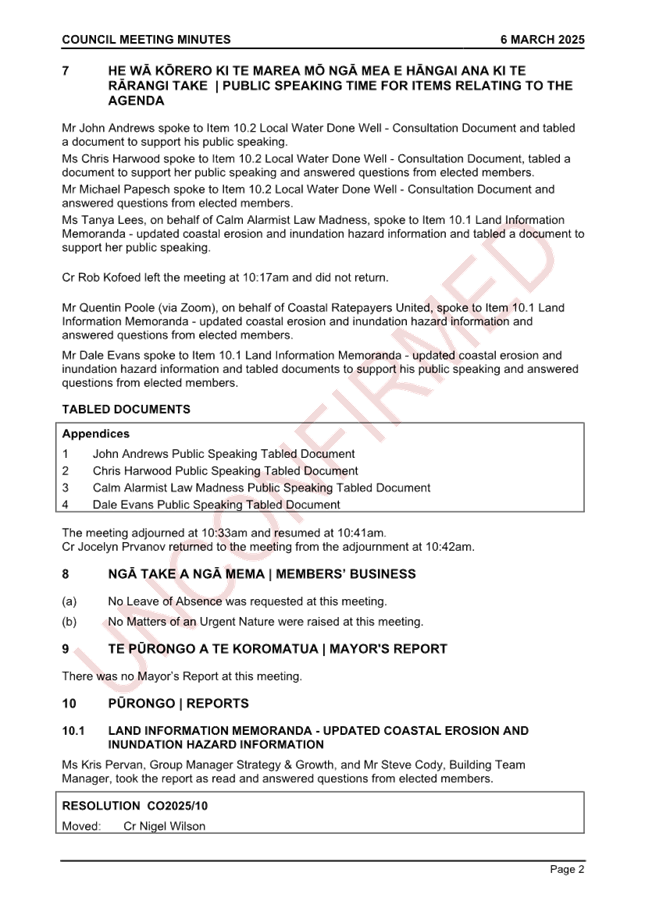
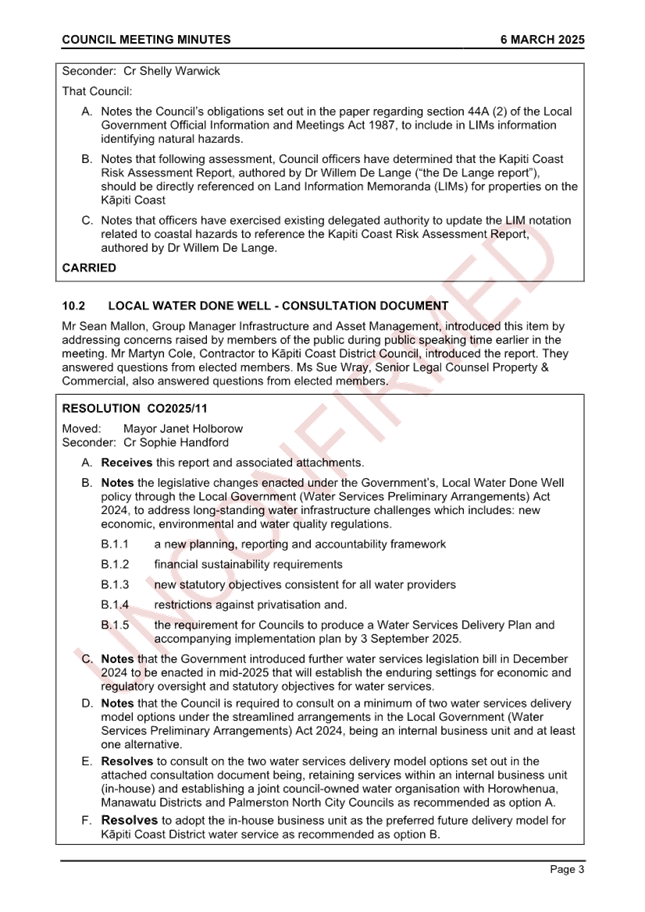
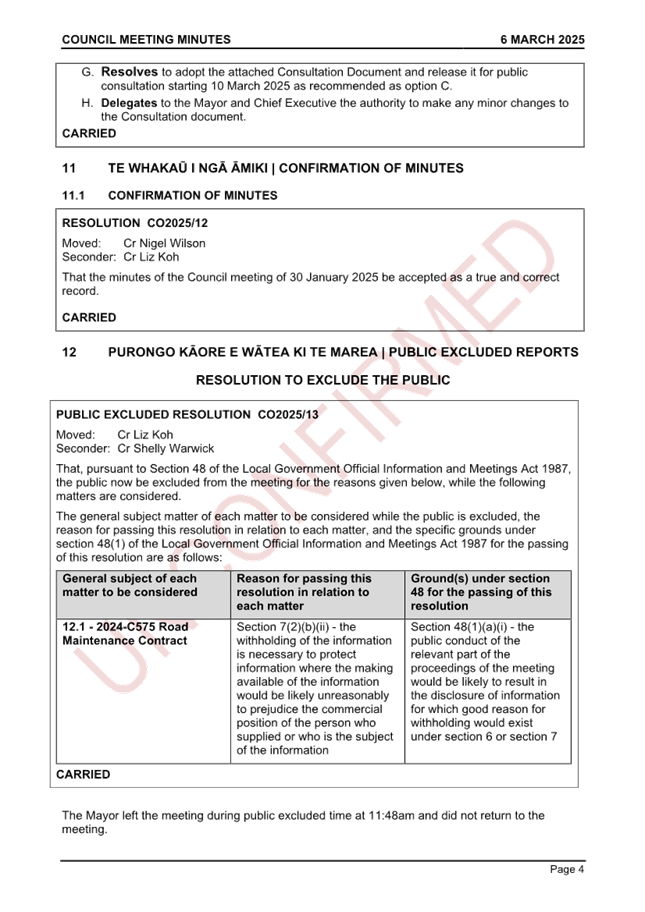
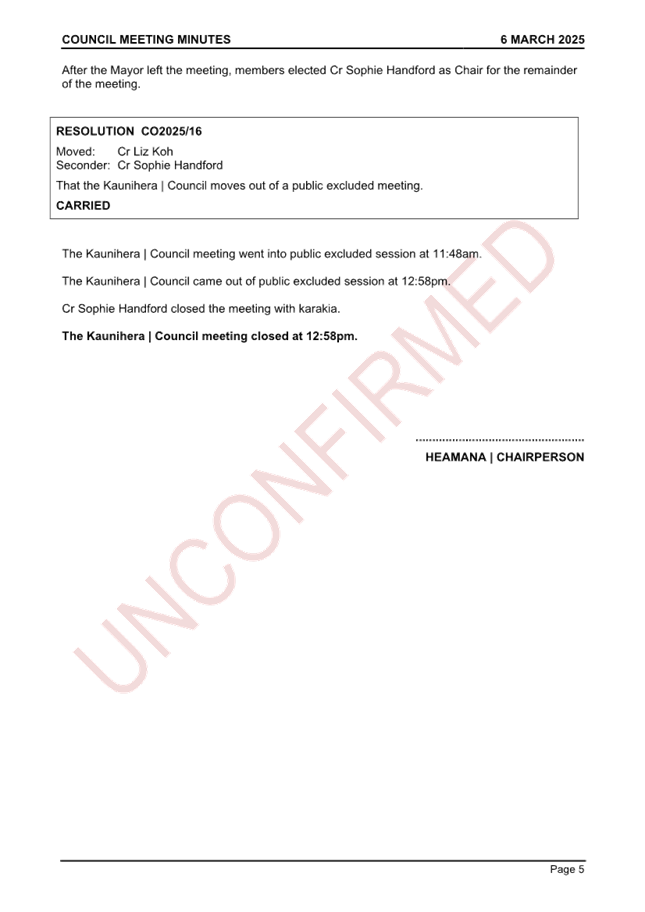
13 Te
Whakaūnga o Ngā Āmiki Kāore e Wātea ki te Marea | Confirmation
of Public Excluded Minutes
14 Purongo
Kāore e Wātea ki te Marea | Public Excluded Reports
Resolution
to Exclude the Public
|
PUBLIC EXCLUDED ReSOLUtion
That, pursuant to Section 48 of the Local Government
Official Information and Meetings Act 1987, the public now be excluded from
the meeting for the reasons given below, while the following matters are
considered.
The general subject matter of each matter to be considered
while the public is excluded, the reason for passing this resolution in
relation to each matter, and the specific grounds under section 48(1) of the
Local Government Official Information and Meetings Act 1987 for the passing
of this resolution are as follows:
|
General subject of each
matter to be considered
|
Reason for passing this
resolution in relation to each matter
|
Ground(s) under section 48
for the passing of this resolution
|
|
13.1 - Confirmation of Minutes
|
Section 7(2)(b)(ii) - the withholding of the information
is necessary to protect information where the making available of the
information would be likely unreasonably to prejudice the commercial
position of the person who supplied or who is the subject of the
information
Section 7(2)(i) - the withholding of the information is
necessary to enable Council to carry on, without prejudice or disadvantage,
negotiations (including commercial and industrial negotiations)
|
Section 48(1)(a)(i) - the public conduct of the relevant
part of the proceedings of the meeting would be likely to result in the
disclosure of information for which good reason for withholding would exist
under section 6 or section 7
|
|
14.1 - Youth Development Provision (Waikanae –
Paekākāriki)
|
Section 7(2)(b)(ii) - the withholding of the information
is necessary to protect information where the making available of the
information would be likely unreasonably to prejudice the commercial
position of the person who supplied or who is the subject of the
information
|
Section 48(1)(a)(i) - the public conduct of the relevant
part of the proceedings of the meeting would be likely to result in the
disclosure of information for which good reason for withholding would exist
under section 6 or section 7
|
|
14.2 - Strategic Property Acquisition
|
Section 7(2)(b)(ii) - the withholding of the information
is necessary to protect information where the making available of the
information would be likely unreasonably to prejudice the commercial
position of the person who supplied or who is the subject of the
information
Section 7(2)(h) - the withholding of the information is
necessary to enable Council to carry out, without prejudice or
disadvantage, commercial activities
Section 7(2)(i) - the withholding of the information is
necessary to enable Council to carry on, without prejudice or disadvantage,
negotiations (including commercial and industrial negotiations)
|
Section 48(1)(a)(i) - the public conduct of the relevant
part of the proceedings of the meeting would be likely to result in the
disclosure of information for which good reason for withholding would exist
under section 6 or section 7
|
|
14.3 - Affordable Housing Project: Rangiuru Road
|
Section 7(2)(h) - the withholding of the information is
necessary to enable Council to carry out, without prejudice or
disadvantage, commercial activities
|
Section 48(1)(a)(i) - the public conduct of the relevant
part of the proceedings of the meeting would be likely to result in the
disclosure of information for which good reason for withholding would exist
under section 6 or section 7
|
|
15 Karakia
Whakamutunga | Closing Karakia
|
Kia tau ngā
manaakitanga ki runga i a tātou katoa,
Kia hua ai te
mākihikihi, e kī ana
Kia toi te kupu
Kia toi te reo
Kia toi te wairua
Kia tau te mauri
Ki roto i a
mātou mahi katoa i tēnei rā
Haumi e! Hui e! Taiki
e!
|
May blessings be upon us all,
And our business be
successful.
So that our words endure,
And our language endures,
May the spirit be strong,
May mauri be settled and in
balance,
Among the activities we will
do today
Join, gather, and unite! Forward
together!
|

























































































